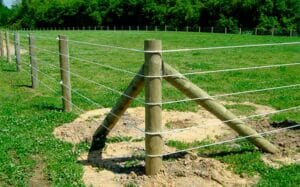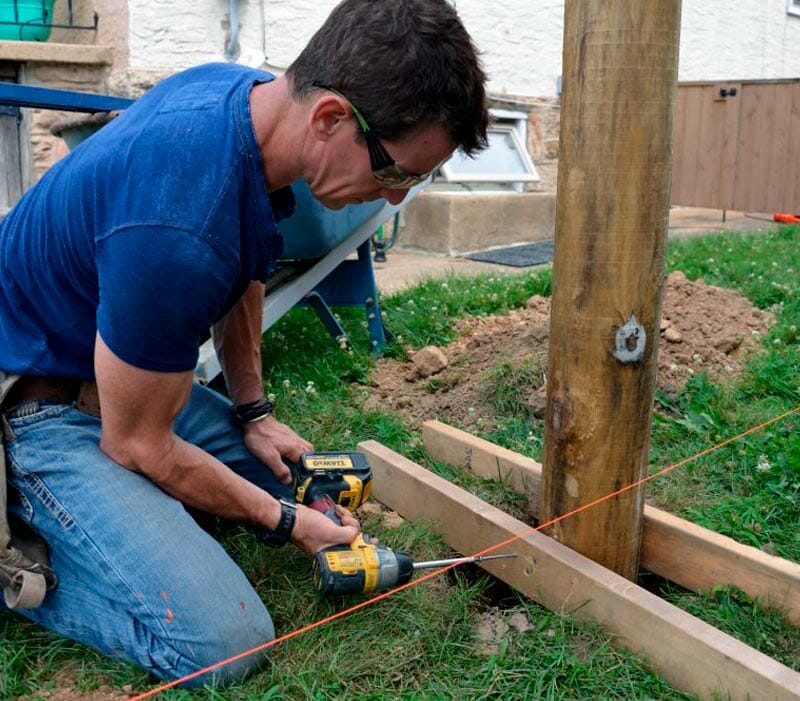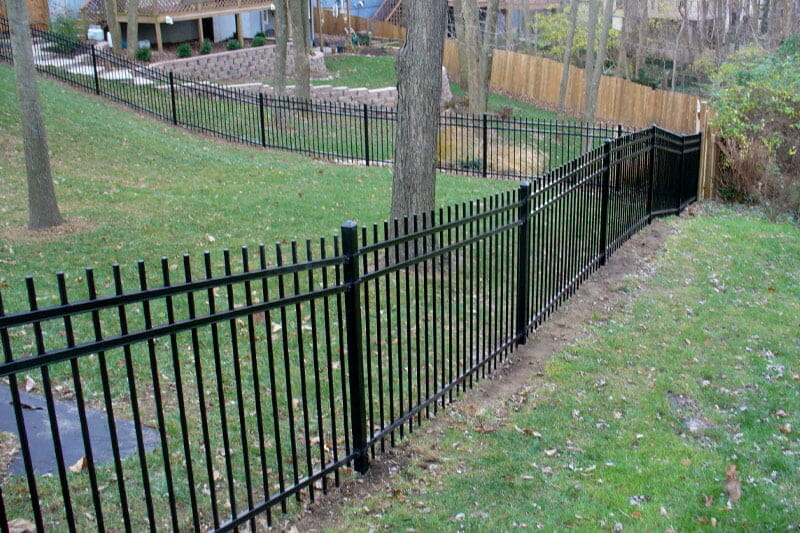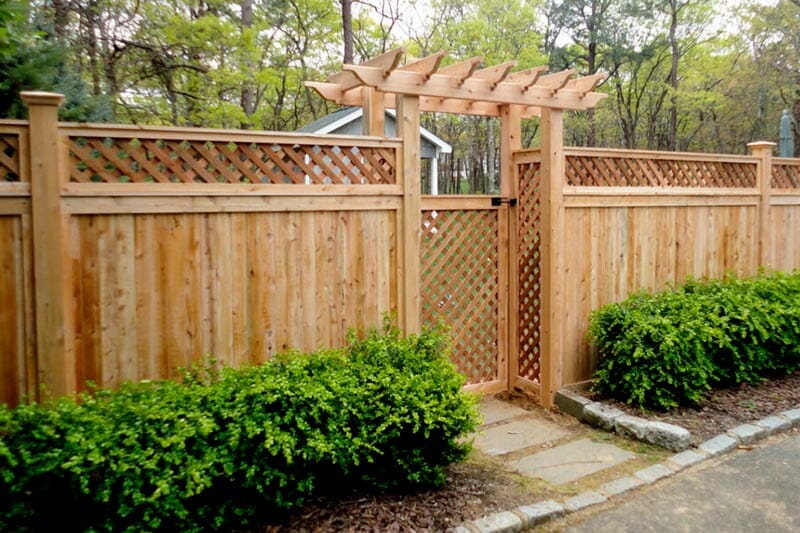Split rail fences have earned their reputation and been widely used in countryside areas for generations. Their popularity stems from both their cost-effectiveness and the ease of assembly. These fences can be constructed with or without wire mesh, allowing for spaces to remain between the rails.
Split rail fences have different types of gates. Some of the gates used with this fence are posts placed in holes. Or, you can make a wooden or metallic gate. Additionally, you can choose to have a 2,3, or 4-rail split rail fence.
You can install a split rail fence gate in any type of compound. You will enjoy a range of benefits from installing this type of fence.
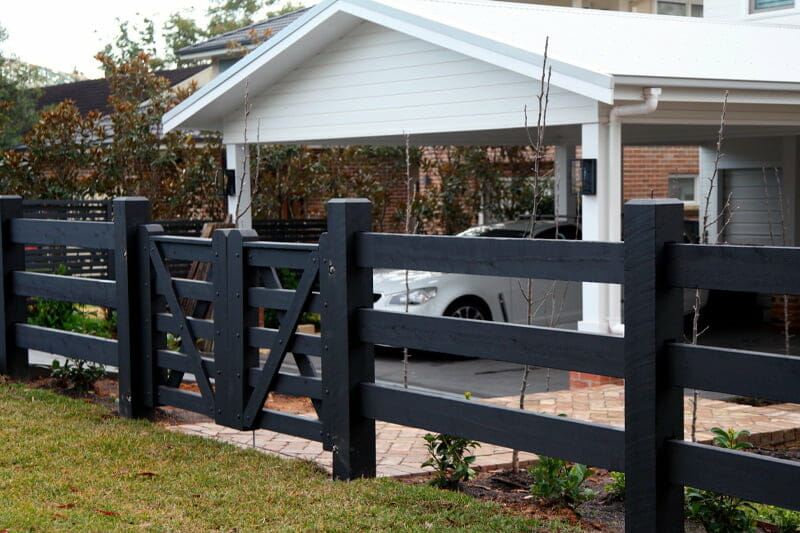
Split Rail Fence Gates Ideas
You can make as many types of gates on a split rail fence. Here are some of the basic foundations of the type of gate you can build.
Standard Split Wood Fence Gate
A split wood fence gate is one of the most common and easiest gates you can make on a split rail fence. It is most suitable for rural regions. It is easy to construct and use.
As its name implies, the split wood gate is made from split wood just like the fence. When you decide where to install your gate, you will leave enough space for the splits. You will then add holes on either side of the fence panels.
Insert your wood splits into the holes. Ensure that the wood can be pushed back through the holes to leave enough space for people and vehicles to pass through.
Ensure that both ends of the splits are in their respective holes on the fence to close the gate.

Single Swing Gate
A single swing gate is a common gate design idea for split rail fences. A single swing gate is a gate design composed of only one gate door.
The gate is attached using hinges on the panels of the fence. You can build the gate to any size. The single swing gate is easy and cheap to install. Also, it is easy to operate on a split rail fence.
The downside of a single swing gate is that it has to cover the whole space left for the gate. This will make the gate heavy and cover a large opening radius to fit people and vehicles.
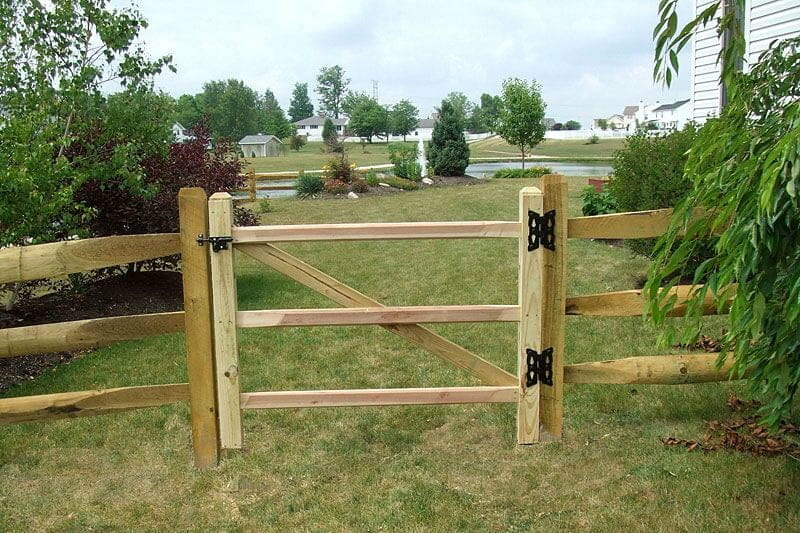
Double Swing Gate
A double swing gate has two gate doors, hinged on either end to fence panels. The gates meet in the middle where they latch.
They are also a common and easy type of gate to install on a split rail fence. Depending on the material you use to make the gate, double swing gates are attractive.
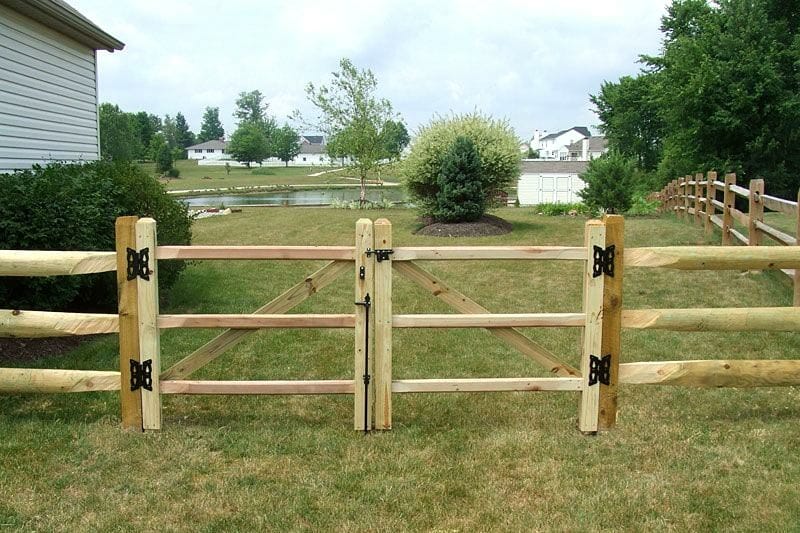
Sliding Gate
A sliding gate can also be installed on a split rail fence gate. It is suitable for an urban split rail fence. It is easy to operate and provides an easy-to-recognize path. It is mostly automatic and can be operated via remote control or by a proximity sensor.
Picket Style Gate
A picket-style gate is a fine gate for the split rail fence. It can be installed in both rural and urban gates. Picket gates add elegance to your split rail fence and make the entryway easy to spot. Further, it is available in a range of designs.
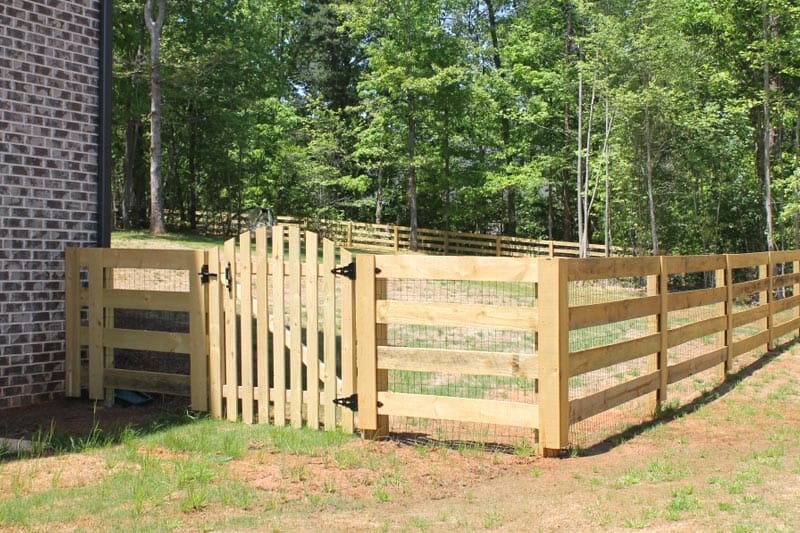
How To Build A Split Rail Fence Gate
Step 1
You need to have all your tools and supplies ready before you start building the gate. You will need a measuring tape, a hole digger, an acid level, and a shovel. For the materials, you will need posts, hinges, latch, and other materials fit for the design of the gate you want to install.
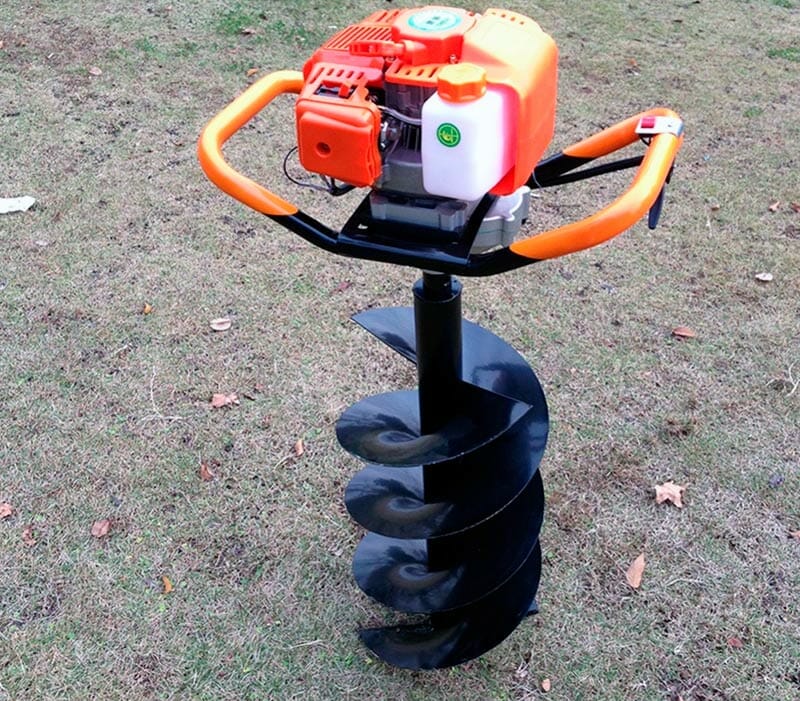
Step 2
Plan it out. This will involve marking and measuring your yard to ensure that you have enough materials for your fencing project. Also, determine your gate size. Will it be the same height as your fence or longer, or shorter? Make sure to measure and plan out everything well to ensure it results in a perfect gate.

Step 3
Build the frame for your gate design. Then, attach the frame of your gate to the posts of your fence by the hinges. Ensure that it is firmly in place.
Step 4
Attach the rails to the frame.

Step 5
Attach the latch. Make sure it attaches to the gate properly. Both sides of the latch should line up properly and be properly attached. It enhances the security provided by the gate.

Step 6
Make sure that the gate is firmly attached to the fence. You have finished building and installing a gate on your split rail fence.

How Much Does A Split Rail Fence Cost
The cost of installing a split rail fence varies depending on the type of material or wood used for the fence and the size of the land to be fenced.
It costs between $1,700 and $ 4,000 to install a split rail fence.
If you hire a professional to install the fence and gate, they will charge you per the square foot. You can expect to pay $11 to $29 per foot depending on the material of your fencing rails.
If you are fencing a ranch with a split rail fence, it may cost you up to $24,000 to install the fence. For a small homestead, you may pay up to $1000 to fence your yard.
If you DIY your split rail fence installation, you could spend up to $1500 and the time it takes to complete your installation. You are likely to save a significant amount if you can install the fence for yourself.
Cost To Install A Split Rail Fence Gate
For each fence, you install you need to fix a gate. Depending on the design and type of gate you use, your costs are likely to increase significantly. On average, you will pay $400 to $600 for a fence gate.
Depending on the material, design, and size of the gate, your costs are likely to increase to $2,000.
Further, depending on the type of gate you want to install, if you have the DIY skills, you can save a significant amount if you forego a professional installer.
Split Rail Fence Contractors
If you are looking to install a split rail fence and gate, is it better to use a professional than to DIY?
This will depend on the size of the land that you want to fence and your fence and gate installation DIY skills.
If you can’t do it by yourself, you have to get a pro to do it for you.
The homegardenguides.com tool makes it easier for you to get a professional to advise and install your split rail fence gate for you.
All you need to do is enter your zip code in the space provided. Then, fill out a form to offer more information on your project.
You will then receive three quotes and advice from professionals. The quotes are sent to you with no obligation to purchase their service.
You can decide to hire one of these service providers to install the fence on your land. Professionals from this tool offer high-quality services with a guarantee of durability.
You can negotiate the services and the costs quoted to get one who will work within your budget and offer the expected services.
Benefits Of Installing A Split Rail Fence Gate
Affordable
A split rail fence gate is significantly cheaper to install than other types of fences. A split rail fence gate requires you to have wood or metal fence rails. The larger the space you have, the more rails you need.
Wood is the most common material used to make a split rail fence gate. The price of the wood used for the fence depends on the type and size of rails you need. You can easily DIY a split rail fence installation or contract an installation company to do it for you which will cost you more.
Durability
Split rail fence gates are long-lasting. The wood used to make the split rail fencing is pressure treated. This ensures that once you plant your posts in the ground, they will not start rotting and decaying.
Wooden posts naturally absorb water from the ground. The water then makes them swell, attract mold and mildew and start cracking. In a few years, you will have to change these posts due to rot.
The pressure treatment prevents the gate and fence rails from absorbing moisture from the ground. This prevents the gate from rotting ensuring that it serves you over a long period.
Attractive
The split rail fence gate is a beautiful fence. The wood used to make the rails is attractive. Cedar and pine are some of the commonly used wood types to make a split rail fence. Once treated and stained, the wood has an attractive appearance.
Easy To Repair
Split rail fences and their gates are easy to repair. Depending on the type of fence you or the gate you have, all you need is wood similar to your gate. If you used nails to build the gate, you can use nails and new rails to repair the broken parts.
If you used assembled rails, you can easily reassemble the railings to repair any broken part of the fence or gate.
Disadvantages Of Split Rail Fence Gate
Privacy
Due to the split between the rails making up your fence, it doesn’t provide as much privacy. You can see through the fence, your small pets can easily get through the fence and get lost.
You can use more rails to reduce the amount of space in the fence or, add a wire. This will enhance the privacy provided by the fence. You can also plant flowers alongside it to cover the split.
FAQ's
Your posts should be at least 6 ft. deep in the ground for proper support. Add gravel until you only have 6 feet left on the hole. Now insert your post and fill the hole with soil for enhanced support.
Strongly held-posts ensure that your fence is strong. A strong fence is attractive and saves you money. You don’t have to repair it regularly and it serves you longer with little maintenance.
Your split rail fence gate should be the same material as the rest of the fence. If you use wood or vinyl to make your fence, make sure that your gate is the same material. In this way, you can be sure that your gate is as strong as your fence. This ensures that you can maintain them both easily and in the same way.
Mixing materials will cause a point of weakness in the fence since the materials are not equally strong.
Vinyl fencing is the most durable fence material you can use. Wood lasts about 20 years before you have to replace it. Wood is affected by the weather in different ways and may rot and decay and start sagging before the 20 years are over.
Vinyl is a strong and durable fencing material. It is not affected by extreme weather changes or pests. Once installed, vinyl fencing requires no maintenance. It maintains its color and luster for longer than a wood fence. You don’t need to repaint, treat or seal vinyl to ensure it lasts long.
Building a cedar split rail fence is a more affordable choice when compared to other types of wooden fences, as it uses less wood in its construction.
You will pay between $12 and $20 per linear foot to install a cedar split rail fence. However, these costs usually vary depending on various factors such as property size, fence height, quality of cedar, location, and the number of gates.
When compared to other types of wood, cedar is also considered to be one of the cheapest fencing alternatives alongside other wood types like redwood and cypress.
Average cost of Cedar Split Fencing
| Quantity | Low | High | |
|---|---|---|---|
| Cedar Split Rail Fencing cost (materials) | per foot | $8 | $12 |
| Cedar Split Rail Fencing Labor Cost | per foot | $4 | $8 |
| Cedar Split Rail Fencing Cost (materials + installation) | per foot | $12 | $20 |
| Cedar Split Rail Fencing cost 200 ft. (installed) | 200 feet | $2400 | $4000 |
Cost Factors of Cedar Split Rail Fences
Cedar Split Rail Fence Gate Cost
Cedar split rail fence gates are relatively cheaper than those of other types of fences. This is because they do not consume a lot of material in construction. On average, one should expect to pay about $250 per gate.
This could however vary depending on the number and size of the gates as well as the type of material used in their construction. Walk-through gates are smaller and easier to put up and are usually much cheaper than their larger drive-through counterparts.
Cedar Split Rail Fence Size
The size of a cedar split rail fence is usually determined by the length and number of its rails as well as the height and number of its posts.
Rails
Most people prefer 2- and 3- rail cedar split rail fences, even though their 4-rail counterparts are also available.
The wooden rails on such fences are usually either 8 or 11 feet long each. Choosing wider rails will certainly cost around 20% to 30% more than settling on narrower ones.
Posts
Cedar split rail fence posts usually differ depending on whether they will be used for 2-, 3- or 4-rail fences. 2-rail fence posts are about 36 inches tall whereas their 3- and 4-rail counterparts measure 48 inches and 60 inches in height respectively.
Cedar split rail fence posts are also categorized based on their position on the fence. Line posts make up most of the fence since they are located between either end or corner posts. They have holes on either side to effectively support the rails passing through them.
Corner posts are meant to enable the fence to form a right angle and therefore have holes drilled at 90 degrees on the adjoining sides. End posts only have holes on one side. Gates are mostly constructed between two end posts. The price of a single post can range between $23 and $50 depending on the number of rails it will support and its position on the fence.
Cedar Split Rail Fence Wire Mesh
Attaching a wire mesh on your cedar split rail fence is sometimes necessary particularly in cases where you do not want your children and pets to go beyond the set boundaries. A wire mesh is also quite effective in keeping out unwanted animals like coyotes and mongooses.
Expect to pay an extra $1-$8 to purchase and install a wire mesh on your cedar split rail fence with the help of a professional.
Cedar Split Rail Fence Cost Location
The location of a cedar split rail fence will certainly affect its labor installation costs to a great degree. Installing a cedar split rail fence on a hilly terrain for example, is likely to take more time and effort than putting it up in a flat area.
In most cases, experts usually demand more money for the extra time spent in installing such a fence. This is especially common in places where labor is charged per hour rather than per linear foot.
Locations also differ from each other in terms of running costs like taxes and availability of materials. A cedar split rail fence will thus cost more to install in areas where cedar is not common. This is because the demand for cedar is higher in such areas than its supply.
Additional Cedar Split Rail Fencing Services
There are some additional services that normally accompany cedar split rail fencing depending on their necessity in the installation process and the clients’ preferences.
It is therefore important to determine whether your fencing expert offers these services or if you need to get another professional for the same. You should expect to incur almost the same amount of additional expense for both options. Such services include:
Tearing Down Old Fences
Tearing down and disposing of an old fence is usually necessary especially if it is positioned in the same place where you want to install your new cedar split rail fence.
If you choose to engage a professional, this may cost you an average of $4 per linear foot depending on the size, accessibility and material of the fence.
Brush Clearing and Tree Removal
Brush clearing in this case, is the process of removing any vegetation that presents a barrier for the installation of your new cedar split rail fence. Tree removal on the other hand means completely cutting down and hauling a tree from the crown to the stump.
It is advisable to engage experts in this processes particularly when you cannot do it on your own due to factors such as complex root systems and excessive plant cover.
Depending on the size of the trees in question one should expect to pay between $325 and $7900 per tree. One can also expect to pay between $20 and $200 per acre for professional brush clearing.
Land Grading
Although a cedar split rail fence is quite flexible when it comes to following the terrain of the land, its installation can be hampered by landscapes that are either too steep or extremely uneven.
In such cases, engaging a land grading expert to level your premises may be the best option. This may cost you between $700 and $1700 depending on the time and equipment that will be used for the job.
Staining and Sealing
Although cedar is naturally resistant to environmental elements such as rot, moisture, pests and warping, it should be frequently refinished through staining and sealing.
This can extend its lifespan for up to 15 to 30 years. One should expect to pay between $500 and $3000 depending on the size of the fence and the quality of stain.
Benefits of Cedar Split Fencing
A cedar split rail fence has numerous benefits especially for large properties located in rural areas. These benefits include:
Its Rustic Appearance
The natural appearance of a cedar split rail fence will most certainly blend into your landscape without causing much disruption. This makes it a great way to effectively define your boundaries without interfering with the beauty of your scenery.
It is Affordable
A cedar split rail fence is extremely affordable especially on large areas. This is because cedar is one of the cheapest fencing materials available. It is also quite economical since it does not require posts to be placed too close to each other which would increase the cost of materials.
It is Durable
The ability of cedar to withstand harsh weather elements such as snow, extreme heat and rain makes it a better fencing alternative to other types of wood like oak and pine.
Cedar is also naturally resistant to insect damage and decay. A cedar split rail fence can therefore last for up to 30 years.
It is Safe
Although barbed wire is the cheapest fencing alternative for large areas, cedar is often preferred since it is safer than barbed wire. With a cedar split rail fence, you do not have to worry about potential injuries to your children, pets and domestic animals.
It is Flexible
A cedar split rail fence can be applied in a variety of ways depending on the clients’ needs and the type of property in question. Whether 2-, 3-, or 4-rail, one can choose to either stain it or retain its natural look.
It can also be fortified with wire mesh when looking to keep external dangers such as pests and varmints away from your property. Some people even combine it with limestone and brick columns for a better visual appeal.

Cedar Split Rail Fence Vs Vinyl Fence
Cedar and vinyl are two of the most common materials as far as fencing is concerned. So which one is better?
Cost
Cedar is certainly a cheaper fencing alternative than vinyl. Vinyl fencing materials cost about $22 to $55 per linear foot including installation. This is rather costly when compared to cedar split rail fencing materials which cost between. $20 and $32 per linear foot plus installation.
Vinyl fences are also more expensive to repair when compared to their cedar counterparts. It costs about $20 per linear foot to repair a cedar split rail fence whereas one must pay $30 per linear foot on average to repair a vinyl fence.
Maintenance
Although both vinyl and cedar are low-maintenance fencing materials, vinyl is better in this regard.
This is because vinyl fences only require periodic hose pipe rinsing to remove any mildew or dirt that may have built up. Where there is mildew, it should be removed as soon as possible to prevent staining.
Cedar split rail fences also require regular cleaning using either a power washer or a garden hose. This should be done when looking to remove any dust, dirt or debris that may have gathered on them over time.
This prevents any rotting and pest infestation on such fences. Trimming any grass or shrubs that may have grown around the posts and rails also helps in preventing any damage from pests. Staining and sealing can also be done to ensure maximum protection.
Durability
Vinyl fences are known to last for 30 years and above. They are thus more long-lasting than their cedar counterparts which only last for an average of 15 years.
This is because they can withstand extreme climatic conditions such as snow, heavy rains, strong winds and extreme sunlight for a longer time than cedar split rail fences. They are also quite resistant to pests, rot and mold infestations which adds to their durability.
DIY vs Professional Cost
DIY
Installing a cedar split rail fence on your own is a rather simple and cost-effective process. This is because it does not require extra materials such as concrete and fasteners which are used on other kinds of fences to provide stability.
Equipment needed
Since installing a cedar split rail fence barely requires any specialized equipment, most people usually already have the needed tools. This makes the project rather affordable since in most cases, there is normally no need to buy new tools.
However, it can cost about $220 to buy new tools for a person doing a DIY fencing project for the first time. Such tools include work gloves, a post level, safety glasses, a mason’s twine, a tape measure, a hand saw, a shovel, a post hole digger and fence stakes.
Cost of Materials
Apart from the tools, essential materials such as posts, rails, a gate, gravel and, paint or stain are also needed when installing a cedar split rail fence. This could cost a total of around $1300 for a 150-foot long two rail fence with a height of 4 feet.
Professional Installation
Hiring a professional to install your cedar split rail fence could cost up to double the amount needed to put it up yourself. It can however help you avoid any costly mistakes that could be detrimental in the long-term.
It is therefore advisable to engage the experts to help you in property assessment, planning and calculation of materials even if you choose to install the fence by yourself.
Home Garden Guides is a great tool that quickly matches you with the best fencing specialists in your locality. You can get three estimates from local fencing professionals in a matter of two minutes. Kindly follow the steps below to enjoy this great service:
- Scroll to the top of the page and enter your zip code
- Answer questions about your drywall job
- Your fencing details are forwarded to three local experts who will send you a price estimate for your job with some friendly advice.
FAQ's
Yellow Pine and Western Red Cedar are considered to be the best wood species when it comes to split rail fence construction. This is because they can be able to withstand highly moist conditions for a long time without rotting.
This makes them quite durable and low-maintenance when compared to other wood species such as Oak and Spruce.
No, they do not. When erecting Cedar rail posts, it is advisable to fill the holes using only the dirt that was removed in digging. This dirt should be put back into the holes in a fixed manner that allows for proper stability and water resistance of the posts.
Although concrete can be used to provide extra support for the gate posts, it should not be applied on wood. This is because it contains water permeable gravel in its makeup that can cause the wood to rot and erode due to excessive moisture build-up.
Each cedar post in a rail fence should be at least 24 inches below the ground and about 12 inches from the earth to the first rail.
Yes, you can. A Cedar split rail fence has an extremely simple design that makes it quite user-friendly even for those engaging in DIY projects for the first time.
No, it is not. Wire fencing which costs an average of $2 per foot is widely considered to be the cheapest fencing alternative.
Cedar split rail fencing is however quite affordable and often costs between $8 and $16 per foot. These costs largely depend on the quality of Cedar being used, the length of the rails and whether it is a DIY or professional project.
Well-installed and properly maintained Cedar split rail fences should last for at least 15-30 years.
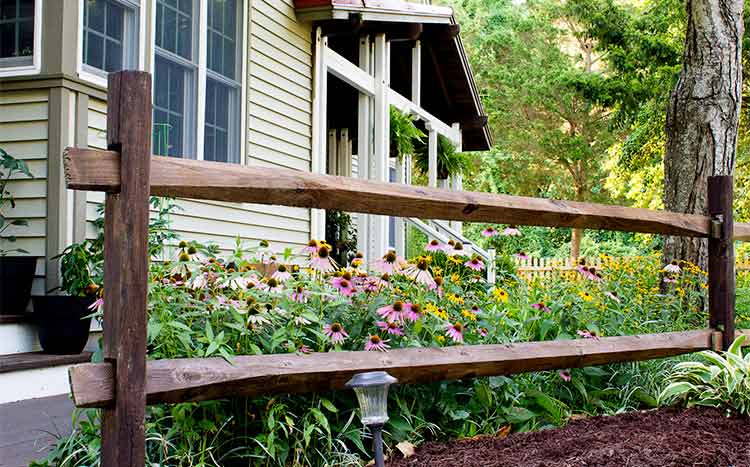
Conclusion
Installing a cedar split rail fence is a great and cheap way to add personality and beauty to your landscape. It is especially suitable for those who want it for its rustic appearance rather than its security.
Expect to pay an average of $3200 for both the materials and labor required to put up a cedar split rail fence up for a perimeter of about 200 linear feet. You can also choose to put it up yourself to reduce costs. However, this is not practical for large projects like animal ranches.
Are you considering the installation of a split rail fence on your land? These kinds of fences not only add to the visual appeal, but also require minimal maintenance and are cost-effective. In this comprehensive guide, we will explore the factors that influence the price of split rail fences, compare different materials, and provide tips on reducing expenses for your fencing project.
A split rail fence costs $8 to $30 per linear foot. To fence a 1/4 acre property or paddock (420 linear feet) with post and rail will cost $3,360 to $4,999.
Factors such as your location, the wood you use and the grade of your land will influence cost.
Highlights
- Split rail fence costs are determined by materials, labor and installation costs, as well as additional features.
- Material cost ranges from $8 to $30 per linear foot depending on the type of material used.
- Consider factors such as length and height of the fence, terrain of property, regulations/permits when budgeting for a successful split rail fencing project.
Average cost of post and rail fence
The average cost of a post and rail fence ranges between $1,500 and $3,500 according to Ergeon. While HomeAdvisor prices split rail fences at $9,960 to $24,900. Below is a breakdown of materials and labor costs.
| Quantity | Low | High | |
|---|---|---|---|
| Post and rail fence cost | Per linear ft | $8 | $29.85 |
| Materials cost | Per linear ft | $6 | $24 |
| Labor costs | Per linear ft | $2 | $5.85 |
| Total costs | 100 sq. ft | $800 | $2,985 |
Average installation cost for 100 linear ft = $1,893
Understanding split rail fence costs
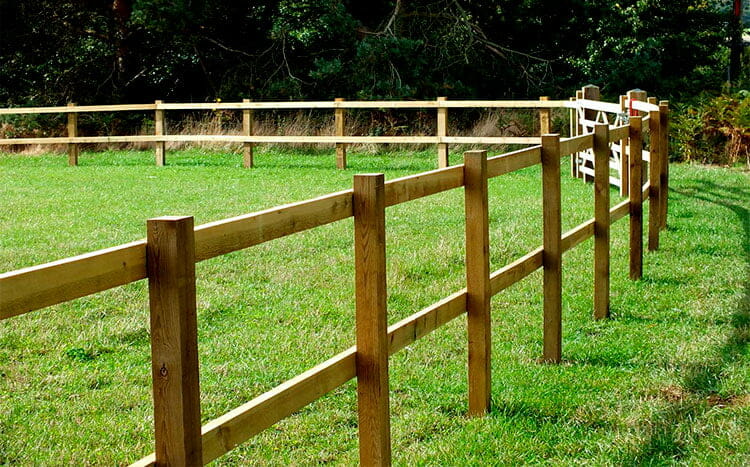
When planning a new split rail fence project, it’s important to consider the various factors that contribute to the overall cost. This includes the material used, labor and installation costs, as well as additional features and expenses that may arise during the project.
In the following sections, we will delve deeper into these factors to help you make an informed decision about your split rail fence investment.
Material costs
A key factor that affects the cost of a split rail fence is the material used. Common materials for split rail fences include:
- Wood
- Vinyl
- Composite
- Metal
Among wood options, cedar and pine are the most economical materials, offering a lower rail fence cost compared to other materials.
The cost range for a split rail fence is as follows:
- Pine: $1,800 to $4,500 for a 150-foot fence, averaging $11 to $21 per linear foot
- Cedar: $11 to $20 per linear foot
- Steel: $15 to $20 per linear foot
- Black locust: $20 to $30 per linear foot
It is important to note that these prices are for materials only and do not include labor costs.
Labor and installation costs
In addition to material costs, labor, and installation costs also play a significant role in determining the overall cost of a split rail fence. The cost of employing professionals to install a split rail fence could be approximately $500 to $1,200 per 150 feet of fencing. Factors such as the terrain and the length of the fence can influence the labor costs associated with installing a split rail fence.
One way to calculate labor costs for installation is by the number of linear feet installed. Additional expenses to consider when installing a split rail fence include renting a powered auger (typically costing $100 per day), land grading, and adding a gravel base to help with water drainage. It is essential to account for these additional costs while budgeting for your split rail fence project.
Additional features and expenses
When planning your split rail fence project, it’s important to consider not only material and labor costs, but also the split rail fencing cost that might arise from additional features such as gates, wire mesh, or painting/staining. Wire mesh, for example, can be acquired for approximately $1.66 per linear foot. Installing a gate to your split rail fence can be pricey, with costs reaching around $200.
It is essential to factor in any extra expenses when planning a split rail fence project. These may include:
- Installation of wire mesh or gate
- Fence removal or tree removal
- Yard grading
- Paint or stains
Being aware of these additional features and expenses will help you budget more accurately and avoid surprises during the installation process.
Post and rail costs per linear foot
On the low end, expect to spend anywhere from $8 per linear foot, and up to $29.85 per linear foot on the higher end. Depending on the location and condition of your existing land, labor will also cost you between $3 – $6 per linear foot.
Post and rail fence cost per acre
If you’re planning to fence an acre (836 linear feet), the installation costs will range between $6,688 to $24,955. Nevertheless, the final quote you receive for this job will depend on the number of railings used and the rail material.
Tip: For installations on large ranches, farms, and other multi-acre properties, many contractors will offer significant discounts since their total overhead costs are lower. Be sure to inquire about such discounts particularly on the materials and labor.
| Property size | Size in linear feet | Average costs |
|---|---|---|
| Quarter acre | 210 | $1,672 - $6,249 |
| Half acre | 420 | $3,344 - $12,476 |
| 1 acre | 836 | $6,688 to $24,955 |
Cost comparison by material
As we’ve seen, the choice of material can significantly impact the cost of your split rail fence. Here are the average costs per linear foot for different types of split rail fences.
- Wood fences (such as cedar and pine): $9 to $18
- Vinyl split rail fences: $15 to $40
- Composite fences: $25 to $50
- Metal split rail fences (including steel and aluminum options): $15 to $32
In the following sections, we will explore each material in more detail, examining their respective advantages and disadvantages.
| Rail material | Low | High |
|---|---|---|
| Pine | $9 | $16.50 |
| Cedar | $11.50 | $18 |
| Vinyl | $15 | $40 |
| Composite | $25 | $50 |
| Aluminum | $22 | $32 |
| Steel | $15 | $20 |
Wood fences
Wood is a popular choice for wood split rail fences due to its durability and cost-effectiveness. Common wood materials used for split rail fences include cedar, pine, and black locust. Cedar split rail fences cost between $11.50 and $18 per linear foot, while pine fences range from $9 to $16.50 per linear foot. Black locust split rail fences are the most expensive wood option, costing around $20 to $30 per linear foot.
Although wood fences are generally more affordable, they do require regular maintenance and can be vulnerable to decay and insect damage. However, the most economical pine fence option would be a two-rail split rail fence constructed of cedar or pine, providing a balance between affordability and durability.
Vinyl fences
Vinyl split rail fences offer several benefits, including low maintenance, durability, and a variety of colors and styles. Vinyl fences typically range in cost from $15 to $40 per linear foot, making them more expensive than wood fences. However, their long-lasting and low-maintenance nature can make them a worthwhile investment for some homeowners.
Despite their advantages, vinyl split rail fences can be more susceptible to damage from extreme temperatures. Additionally, the higher cost of vinyl fences may be a deterrent for some homeowners. It’s important to weigh the benefits and drawbacks of vinyl fencing before making a decision on the best material for your split rail fence project.
Composite fences
Composite split rail fences are made from a combination of recycled wood and plastic, offering the benefits of low maintenance, durability, and a variety of colors and styles. The cost of composite fencing ranges between $25 and $50 per linear foot, making it more expensive than wood and vinyl fences.
While composite fences offer several advantages, they can also be affected by extreme temperatures. This factor, along with their higher cost, may influence homeowners when choosing the best material for their split rail fence project.
It’s essential to consider the unique characteristics of composite fencing before making a final decision.
Metal fences
Metal split rail fences, including steel and aluminum options, are known for their high durability, minimal maintenance, and a range of colors and designs. Steel split rail fences cost between $15 and $20 per linear foot, while aluminum fences range from $22 to $32 per linear foot for materials only.
However, metal split rail fences, such as steel split rail fences, can be more expensive than other materials and can be prone to rust and corrosion. When considering a metal split rail fence, it’s crucial to weigh the advantages and disadvantages of this material and determine if it’s the best choice for your fencing needs.
Factors that affect split rail fence costs
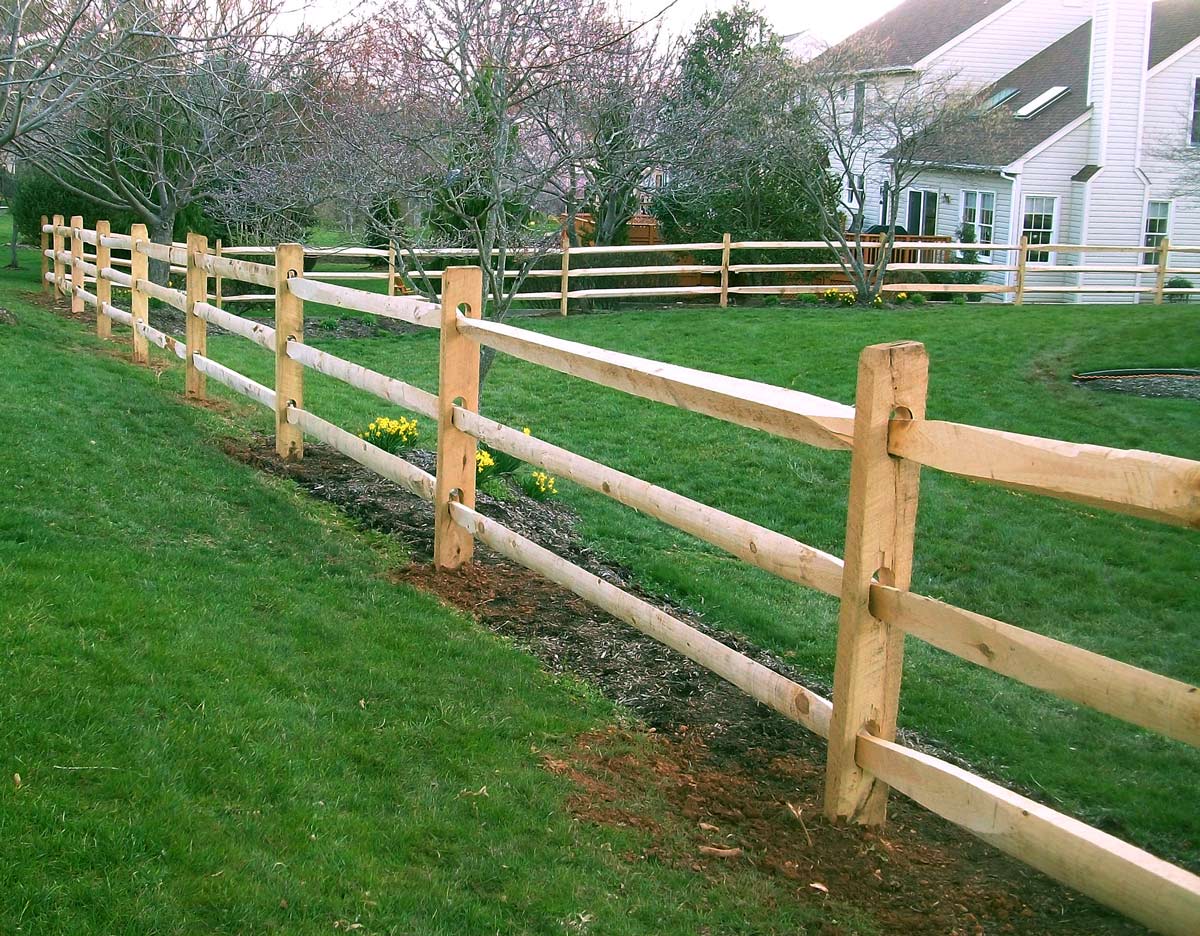
As we’ve explored in the previous sections, several factors can influence the overall cost of a split rail fence. These include:
- The type of material used
- The length and height of the fence
- The terrain of the property
- Any additional features and expenses that may arise during the project.
By understanding these factors, you can make informed decisions about your split rail fence project and potentially find ways to reduce costs.
Fence length and height
The length and height of your fence play a significant role in determining the overall cost of materials and labor. Longer fences require more materials, increasing the cost of the project. Similarly, taller fences necessitate more labor, resulting in a higher overall cost.
When planning your split rail fence project, it’s essential to accurately measure the area and consider the desired height of your fence. This will help you budget for materials and labor costs and ensure that your fence meets your needs while staying within your budget.
Property terrain
The terrain of your property can also affect the cost of installing a split rail fence. Hilly or irregular terrain may require additional materials and labor to install the fence. Rocky terrain or areas with a lot of tree roots can make installation more difficult, leading to higher costs. Additionally, the placement of fence posts in such conditions might also contribute to the overall expenses.
Before starting your split rail fence project, it’s crucial to assess your property’s terrain and consider any potential challenges it may pose during installation. This will help you plan and budget for your project more effectively, ensuring that your fence is installed correctly and lasts for years to come.
Local regulations and permits
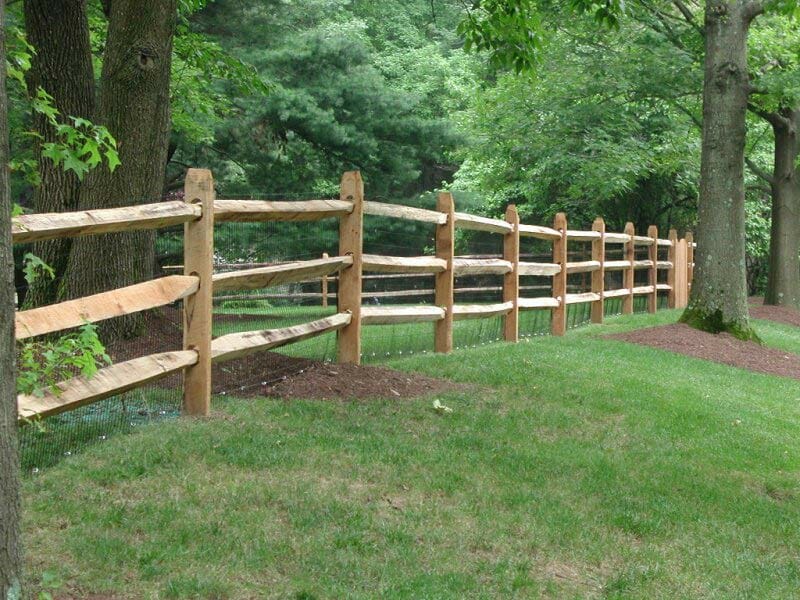
Local regulations and permits can also impact the cost of your split rail fence project. Requirements for size, placement, and permits may differ depending on your location. It’s important to assess local building codes, zoning laws, and neighborhood association rules to ensure your fence project meets all necessary specifications.
Failing to comply with local regulations and permits can result in fines or the need to modify or remove your fence, leading to additional costs. By researching and adhering to local requirements, you can avoid these potential issues and ensure that your split rail fence project is completed without any complications.
Important: Every state and county in the United States has its set fence laws and regulations that govern the height and setback regulations of that area. Some Homeowners Associations also have separate by-laws governing the fencing of your neighborhood.
Read more about the fence laws in your area here.
Post and rail fence labor costs
The total costs you’ll incur in labor costs will depend either on how fast your installers can complete the job, or how big your yard is.
Most contractors will charge you anywhere from $3 – $5 per linear foot or between $35 – $60 per hour on labor.
The simple installations will take a professional 1 – 2 days to complete and up to 5 days for the large, difficult jobs. Generally, a team of 2 – 4 workers should install between 200 – 300 linear feet of post and rail fencing every day.
Cost of gates, doorways, and accessories
Gates and doorways on post and rail fences are usually cheap since they don’t utilize a lot of material. Expect to spend anywhere from $100 – $300 for every gate and doorway you install depending on the type and size.
Adding other accessories such as lighting or decorations will also cost you slightly more. The more additions you install, the more money you’ll spend.
Cost of post and rail by number of rails
The cost of a post and rail fence is also affected by the number of horizontal rails you decide to use. The average cost of one rail stands between $1.50 – $4.50 per linear foot depending on the size.
Most homeowners prefer the 3-rail fencing because they are tall and often stronger than a 2-rail fence. Its cost is, however, higher at around $8 – $14 per linear foot compared to the $3 – $9 per linear foot of 2-rail.
Each railing is available in 1 by 6, 2 by 6, and 2 by 4 sizes, or 8 – 11 feet span for wooden rails.
| Number of rails | Cost per linear foot |
|---|---|
| 2 - rail fence | $9 - $13 |
| 3 - rail fence | $12 - $16 |
| 4 - rail fence | $16 - $19 |
| 5 - rail fence | $18 - $24 |
Cost of other extra services
When accounting for the post and rail fence installation costs, there are several other extra services that you should add to your budget for a successful job. These include;
Land grading
While post and rail fences can work on almost any terrain, in areas where the land’s slope is too steep, some grading will be needed to even out the fence. Depending on the amount of excavation and re-sloping required, this process will cost you between $900 – $3000.
Fence removal
If you have an existing fence that can’t be repaired, you’ll need to remove it before installing the new split rail fence. This process will cost you about $3 – $6 per linear foot if you choose to hire a professional.
Keep in mind; If the old fence was installed using concrete and other thick materials, the removal costs will be higher.
Tree/bush removal
Removing obstacles such as trees and bushes along your installation path may force you to hire a tree service company. Doing this will set you back an additional $400 – $1,100 per plant removed, or $10 -$14 per foot of the plant’s height.
Additional cost factors
- Size and Height – Tall and long post and rail fences generally require more material than short and smaller fences. You’ll therefore spend more on a fence taller than 5 feet and longer than 8 feet.
- Wire mesh – Installing a wire mesh with the post and rail fence increases your overall costs by around $1.80 per linear foot.
- Soil condition – The condition of the soil in your area affects how difficult the installation will be. For instance, Clay soils are very dense meaning digging will take more time. Loam soils can be unstable hence require large posts or additional gravel to improve balance. Sand soil may force the contractors to transport extra water on-site to improve its retention. All these mean additional costs.
- Shape of rails – Round rails cost slightly more than flat rails, but they last longer and thus are a better long-term investment.
DIY vs. professional installation
When it comes to having a split rail fence installed, homeowners often wonder whether they should take on the project themselves (DIY) or hire a professional fence contractor. Both options have their advantages and disadvantages, which will be explored in the following sections.
By understanding the costs, benefits, and challenges of each installation method, you can make an informed decision that best suits your needs.
DIY installation costs
Installing a split rail fence on your own can lead to significant cost savings compared to hiring a professional. On average, homeowners can expect to pay approximately $17.75 per linear foot for a 3-rail split rail fence when installing it themselves. However, it’s important to note that these costs can vary depending on factors such as the material used, location, and the length and height of the fence.
While DIY installation can be more cost-effective, it’s essential to consider the potential challenges and risks associated with this approach. These include the possibility of errors, the need for specialized tools, and the risk of injury. It’s important to weigh these factors against the potential savings before deciding to install your split rail fence on your own.
Hiring a professional
Hiring a professional fence contractor to install your split rail fence can provide several advantages. A professional fence installer can complete the project in a shorter time frame (typically 2-3 days) and ensure a higher quality installation. While the cost of professional installation is generally higher, ranging from $10 to $30 per linear foot, the benefits of a well-installed and durable fence may outweigh the additional expense.
It’s crucial to weigh the costs and benefits of hiring a professional fence contractor against the potential savings of DIY installation. If you’re unsure about your ability to install the fence yourself or if the project seems too time-consuming or challenging, hiring a professional may be the best option to ensure a successful and long-lasting split rail fence.
Pros and cons of post and rail fence
Pros
- Aesthetically pleasing and blends well with the natural landscape
- It’s easy to install and repair
- No sharp edges that could hurt children or animals
- Sturdy when properly installed and can be used to pen livestock
- Materials like cedar and vinyl used for the railing require minimal maintenance
- Wooden options are cost-effective
Cons
- Doesn’t provide any real security or privacy
- Doesn’t keep up out smaller animals like dogs unless you use a wire mesh
- Some rail materials can be expensive
- Doesn’t provide any shade
Tips for reducing split rail fence costs
Now that we’ve explored the various factors that contribute to split rail fence costs, let’s look at some strategies for minimizing these costs. By implementing these tips, you can ensure that your fence project stays within your budget while still meeting your needs and preferences.
One way to reduce costs is to purchase the materials yourself. This can be a great way to work.
Bulk purchasing
One way to reduce the cost of your split rail fence project is through bulk purchasing. Buying materials in large quantities can lead to discounts or other cost savings. This can be particularly beneficial for larger split rail fencing projects or if you plan to install multiple fences on your property.
When considering bulk purchasing, it’s important to ensure that the materials are appropriate for the task at hand and compare prices between different suppliers to guarantee the most advantageous deal. By taking advantage of bulk purchasing, you can potentially save a significant amount on your split rail fence project.
Choosing the right material
Selecting the most appropriate material for your needs can also help reduce costs. As previously discussed, materials such as cedar and pine are more economical options for split rail fences, while vinyl, composite, and metal fences can be more expensive.
It’s crucial to factor in your budget, the climate in your area, and the level of durability you require when choosing the right material for your split rail fence project. By selecting the most suitable material for your needs, you can ensure a cost-effective and long-lasting fence.
DIY installation
Finally, installing your split rail fence yourself can lead to significant cost savings compared to hiring a professional fence contractor for split rail fence installation. However, DIY installation comes with its own set of challenges and risks, such as the possibility of errors, the need for specialized tools, and the risk of injury.
If you’re confident in your ability to install the fence and are willing to invest the time and effort, DIY installation can be a cost-effective option. Just be sure to accurately measure the area, carefully follow instructions, and utilize the appropriate tools for the task to ensure a successful and long-lasting split rail fence.
FAQ's
On average, a split rail fence will cost around $20 per linear foot, or $2,853 for materials and professional labor.
Costs can range anywhere from $11 to $29 per linear foot, depending on the material used and your location.
Split Rail Fencing is a cost-effective and easy-to-maintain fence option. It requires minimal posts and rails to assemble, and can be easily repaired and maintained as needed.
This makes it a great choice for many people.
Split rail fences can have a life expectancy of up to 30 years when properly maintained, with an average lifespan of around 12-20 years. Pressure treated fences typically last up to 12 years, while larger posts last about 20 years.
Untreated split rails can survive for up to 10 years, and cedar fences may last between 10-15 years.
An alternative to a split rail fence is a Ranch Rail Fence, also known as Horse Fence, Farm Fence, Field Fencing or Board Fence. It’s becoming popular for various settings and provides a sleeker look than the traditional split rail fence.
Split rail fences are typically made from wood, vinyl, composite, or metal.
Many homeowners continue to favor wood for their deck railings. This preference is due to its unique visual charm offered at an affordable cost.
A 10-foot deck railing made of wood will cost you an average of $300 to professionally install. This translates to about $30 per linear foot. This price can however vary depending on the type of wood selected and the quality of labor used during installation.
DIY contractors will therefore incur only $14 per linear foot on average to install wood deck railing. Other cost considerations include installation equipment and old deck railing removal. Elaborate deck railing designs are also more expensive to install than simple ones.
Average Wood Deck Railing Cost
| Wood Railing Item | Average Cost Per Linear Foot |
|---|---|
| Materials | $14 |
| Labor | $14 |
| Permits | $2 |
| Total | $30 |
Factors to Consider When Installing Wood Deck Railing
Wood Species
Pine is arguably the cheapest wood deck railing option available. Lower grades of cedar are also quite affordable. Exotic wood varieties such as redwood and high-quality cedar can however cost up to $45 per linear foot.
Ipe, mahogany and tigerwood are the most expensive wood deck railing alternatives. The usually up to $75 per linear foot to purchase and install.
Materials
| Material | Average Cost |
|---|---|
| Balusters | $10 each |
| Posts | $3 per post |
| LED Lighted Caps | $68 per cap |
| Drink Rails | $13 per linear foot |
| Gates | $32 per gate |
| Deck Screws | $5 per pound |
Balusters
Balusters are also referred to as infill materials. Most infill materials used for wood deck railing are made of wood, steel, and aluminum. Baluster pressure-treated deck railing panels cost an average of $10 per linear foot.
Posts
Buying a post for wood deck railing will cost you an average of $3. Most posts used for wood deck railing are 39 inches tall. Posts with a height of 45 inches are however also available for 42-inch rails.
Posts are extremely critical to the railing’s structural stability because they offer support to the rail structure. On a flat deck, these posts should be no more than six feet apart.
On stairs, they should be no more than five and a half feet apart. For enhanced rail strength, your local building department may mandate closer post spacing.
LED Lighted Caps
Installing LED lighted caps is a great way to enhance the security and aesthetic beauty of your wood deck railing. Expect to pay an average of $68 for caps with solar-powered LED lights.
Rails
Expect to pay an average of $17 per linear foot for straight wooden rails with pickets or metal balusters. Stair railing made from treated wood, with pickets or metal balusters, will cost you $21 on average. Cedar railing is a rather expensive alternative at $39 per linear foot.
The standard height for guardrails as stipulated by the International Residential Code (IRC) is 36 inches. 42-inch rails are however also applicable for posts with a height of 45 inches. They are mostly used for commercial buildings adjacent to multifamily structures.
Rail height is measured from the deck surface to the upper part of the rail. You can install extra-wide drink rails with large ornamental caps to increase your deck’s visual appeal. This may however prove to be quite costly.
Gates
The cost of wood gates is mostly double the cost of the whole length of the railing. This is particularly the case if the gate is constructed on-site and not assembled beforehand. Expect to pay an average of $32 for cedar and treated pine deck gates.
Deck Screws
Deck screws will cost you an average of $5 per pound to purchase. 3-inch length coated deck screws are the most preferred for wood deck railing. This is because they hold the rails and deck panels much better than smaller 2.5-inch screws.
A deck screw with a diameter of #8 is optimal, because a larger one would split the wood. If you are working with cedar, you should employ a hidden fastening technique because the coated screws will stain the wood.
Deck Sophistication
A rectangular deck with only one level and no stairs is certainly cheaper to install than a more intricate deck with multiple tiers. This is because labor costs usually vary depending on the complexity of a project and the time spent on its completion.
Permits
All decks with railing require permits before construction. Such permits are normally issued by homeowners’ associations and local government authorities. Although they are cheaper than building permits, they still contribute to the overall deck railing cost.
Expect to pay an average of $25 for deck railing permits. This cost normally varies based on the size of your deck and your place of residence. It is therefore advisable to consult a local decking professional for the most up-to-date information on the rules and fees in your locality.
https://homegardenguides.com/siding/ is a great tool that quickly matches you with the best deck railing experts in your locality. You can get three estimates from local deck railing professionals in a matter of two minutes. Kindly follow the steps below to enjoy this great service:
- Scroll to the top of the page and enter your zip code
- Answer questions about your deck railing job
- Your deck railing details are forwarded to three local experts who will send you a price estimate for your job with some friendly advice.
DIY Vs Professional Wood Deck Railing Installation
The following factors should be considered when deciding whether to hire a professional deck railing contractor or install your wood deck railing system by yourself:

Cost
Professional wood deck railing costs about $30 per linear foot installed. DIY wood deck railing costs an average of $14 per linear foot installed. DIY wood deck railing is therefore much cheaper than professional installation based on initial costs.
Professional installation may however prove to be cheaper in the long term. This is because it guarantees a high degree of efficiency that keeps the railing durable for a long time. If done wee, professional installation also reduced the need for frequent maintenance.
Level of Skill and Experience
If you are a highly skilled DIY contractor with experience in handling similar projects to your wood deck railing installation, you can save a lot of money by doing the project yourself. If you are relatively new to DIY installation, hiring a professional deck railing expert is the best option.
This is because it guarantees a level of effectiveness and efficiency that your little skill and experience cannot offer. It can therefore save you from making costly mistakes that would be expensive to remedy in the long-term.
Availability
Making time for a large and complex wood deck railing project may be difficult if you have to put it alongside other vital daily tasks like work. Professional installation is therefore the best option if you cannot be consistently available to complete the project.
Warranty
Some manufacturers do not warranty DIY-installed deck railing materials. It may therefore be wise to hire a professional expert to install your wood deck railing because this guarantees a product warranty that may be useful in future repair and replacement projects.
How Much Does Disposing Damaged Wood Decking Cost?
Expect to pay deck railing experts and handymen an average of $2.5 per linear foot to get rid of your old deck railing. You can also opt for DIY wood railing removal and disposal at little or no extra cost.
It can be more cost-effective to rent a dumpster if you are either removing the entire deck or have additional cleanup jobs.
Smart homeowners understand that increased dumpster sizes lower the cost per cubic yard. Cost sharing with neighbors who have a lot of trash to get rid of, is also a good idea.
FAQ's
You should use both nails and screws for deck railing. Nails should be used to secure the joists and stair stringers to the deck’s framing. Decking and railings should be attached to the framing using screws or fasteners.
Expect to pay relatively the same price for both iron and wood balusters. Choosing between them is therefore almost completely a matter of preference and aesthetic appearance. This is because of the strength and adequacy that both options offer when installed correctly.
Iron balusters certainly last longer over time than wood balusters. This is because they are not susceptible to pests and rotting as a result of excessive moisture. They therefore do not need periodic maintenance to stay in shape.
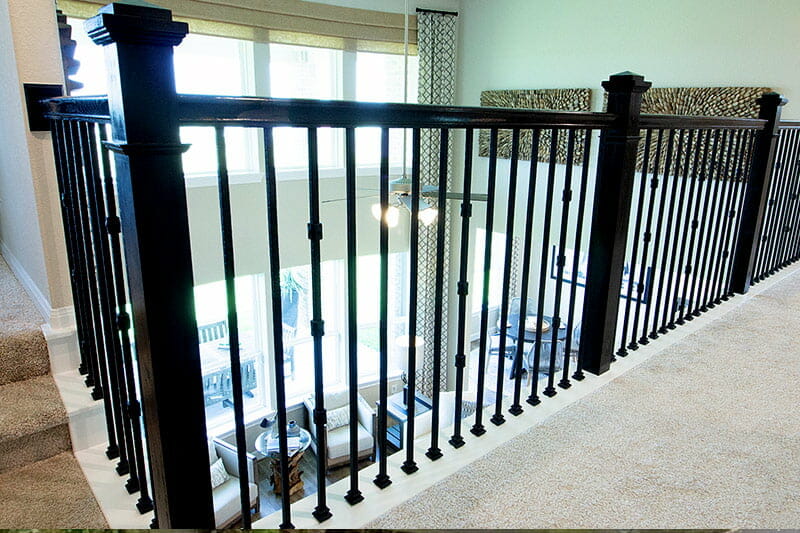
Yes, you can. One of the most frequent ways of modernizing an older balustrade is to replace wood balusters with wrought iron fencing balusters. This is mostly done when wood balusters outlive their usefulness by becoming cracked or broken.
Based on decking codes, a railing is not necessary if your deck is less than 30 inches off the ground. However, even a deck that is about 25 inches high can be unsafe for adults, children and pets. Railing is therefore essential to alleviate this risk.
What are the dimensions in feet for a lot that measures 1 acre, and how much fencing would be needed to enclose this area? These questions are often posed regarding the sizing of parcels of land.
1 acre of land is 43,560 square feet which gives it a linear circumference of 835 feet. Thus, you will need 835 feet of fence for a 1 acre lot . If you are buying prefabricated sections, you will need 104 sections that are 8 feet long each to fence 1 acre.
There are lots of difference fences you can use which vary wildly in price but the most popular is a split rail or a post and wire.
| Linear feet | No. of 8 ft. sections needed | |
|---|---|---|
| 1/4 acre lot | 208 | 26 |
| 1/2 acre lot | 417 | 52 |
| 1 acre lot | 835 | 104 |
| 2 acre lot | 1,670 | 208 |
| 5 acre lot | 4,175 | 520 |
| 10 acre lot | 8,350 | 1,040 |
How many 8 foot sections of fence needed for 1 acre lot
We know the linear circumference of a 1 acre plot of land, no matter the shape, is 835 feet. So the calculate the number of 8 feet sections to fence a 1 acre lot you need to :
835 divided by 8 = 104
So you will need 104 sections of fence that are 8 feet long each to completely fence a 1 acre lot.
How many feet of fence for a ½ acre lot
A 1/2 acre lot of land is 21,780 square feet with a circumference of 417 linear feet. So you will need 417 linear feet of fence for a ½ acre lot.
If you are buying 8 foot sections of fence, you will need take 417 and divide by 8 ft.
417 divided by 8 = 52
You will need 52 x 8 foot sections of fence for a 1/2 acre lot.
How many feet of fence for a ¼ acre lot
A 1/4 acre plot of land is 10,890, which is the average land size right across America. A 1/4 acre lot has 208 linear feet around the perimeter.
Most fences use 8-foot spacing between fence posts, so you will need approx 104 fence posts for a 1 acre lot.
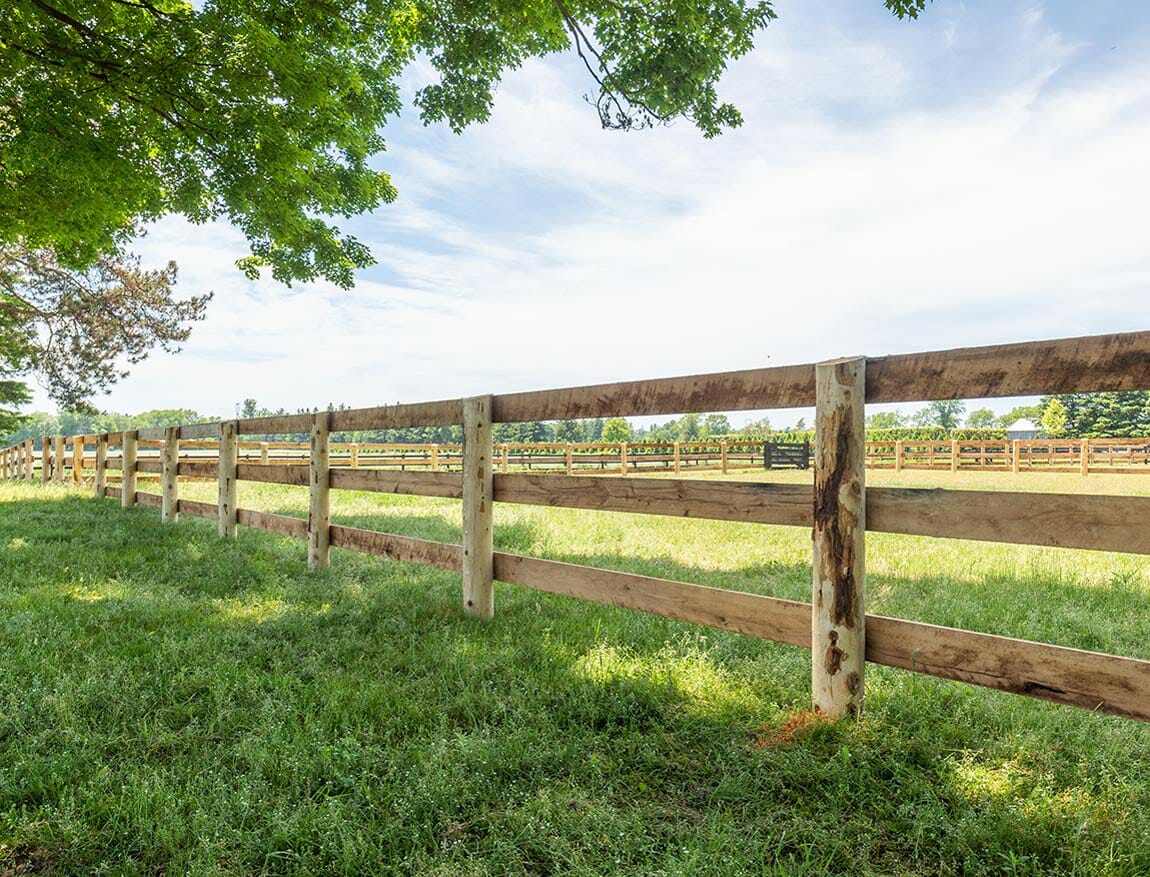
How much does it cost to fence a 1-acre lot?
It costs $3,550 to $23,425 to fence a 1-acre lot. The materials you use will determine the overall cost of installing the fence. Some materials may be a bit costlier than others.
How much you spend on a fence depends on your budget and the materials you use.
Average cost of fencing a 1-acre lot by material type
| Fence material | Cost per foot | No. of posts for 8-foot section fences | Final price (Average) |
|---|---|---|---|
| Post and Wire | $1 - $6 | 104 | $3,550 |
| Chain link | $9 - $18 | 104 | $9,450 |
| Wood | $10 - $20 | 104 | $12,460 |
| Vinyl or PVC | $20 - $25 | 104 | $18,300 |
| Aluminum | $20 - $35 | 104 | $23,425 |
Barbed wire
It is the cheapest fencing material. It costs $2.5 to $6 per foot. This works out to be $2,087 to $5,010 to fence your acre of land with barbed wire, which the variance in proce depending on the post type used.
Woven wire fence
It costs $2 to $4 per foot to fence land with a woven wire fence. You will pay $1,670 to $3,340 to fence a 1-acre lot with a woven wire fence.
It is used most in agricultural settings due to its strength and safety with animals.
Wood fencing
It costs $10 to $20 per foot to fence with wood. You will pay $8,650 to $17,400 to fence an acre of land with wood.
Wood is a suitable fencing material for both homes and agricultural land.
Vinyl
Fencing with vinyl costs $20 to $25 per foot. You will pay $17,400 to $20,875 to fence a 1-acre lot with vinyl. It is popular for its ease of use. It is lightweight and durable.
Aluminum
Aluminum fence materials are among the most expensive. It costs $20 to $35 per foot to fence with aluminum. The entire project will cost about $17,400 to $ 29,225.
Aluminum is an attractive and lightweight fence material that does not rust. Due to its cost, it is used mostly for residential fencing.
Factors to consider when fencing your land
Size of the land
It will cost more to fence a larger piece of land than a smaller one. The size of the land determines the number of fencing materials you need. The more materials you need, the more you pay for fencing.
Choice of fence materials
There are many types of fence materials to choose from. Prices of fence materials vary.
Barbed wire is the cheapest fence material while wrought iron and aluminum are the most expensive.
Type of fence
There are many options of fences you can install depending on how you intend to use the land. Land can either be residential or agricultural.
Residential fences provide privacy and security to homes. Agricultural fences mark boundaries and keep animals enclosed within the farm.
Permits
Permits tend to increase the cost of fencing, and depending on your location, you will need a permit for your home remodeling project.
Consult your local government office to find out if you need a permit. The more you pay, for a permit the higher your fencing costs.
DIY or hire a pro
Depending on the fence material you use, you can DIY or hire a pro. If you DIY, you will save on the fence installation costs.
You can also hire a pro to install your fence. The larger your land, the more you will pay a pro to install a fence. Additionally, the type of fence you install will increase the cost.
Job complexity
The complexity of fencing tasks depends on the state of the land. Trees and ungraded land increase the complexity of fence installation.
Grading the land increases the cost of fence installation.
How to save money on your fencing project
- Purchase cheap fencing materials. Depending on the purpose of the fence, do not go for the expensive materials. Pick fairly priced materials that will serve the purpose.
- Always prepare a budget with the help of a professional. It helps to guide your purchases.
- Choose an affordable and purposeful style for your fences.
- You can opt for DIY installation.
- Get three quotes from installation companies before you pick one to hire.
Benefits of installing a fence
- Increase your property’s value.
- Enhances your home’s security.
- Mark the boundaries of your land.
Landowners want to know the cost of fencing 1/4 acre lot of land. You need to first find out the actual footage of your land.
A one-acre lot measures 43,560 square feet. A 1/4 acre lot is 10,890 square feet. The square root of 10,890 gives you the length of the sides. Therefore, the sides of a 1/4 acre lot measure 104 feet. The perimeter of the ¼ acre lot is 416 feet which is equal to the amount of fencing material you require. We are assuming that the lot is square-shaped.
Your fence materials are equivalent to the total linear footage of your land. The larger your land the more fence materials you require.
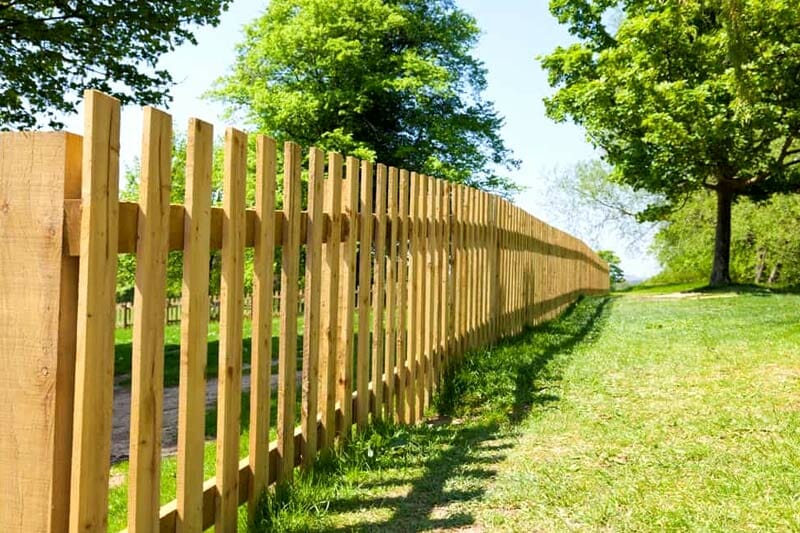
How much does it cost to fence a ¼-acre lot?
It costs $1,000 to $15,000 to fence a ¼-acre lot. How much you pay depends on the materials you use. Some materials are cheap while others are expensive.
How much you spend on a fence will depend on your budget and the materials you use.
Average cost of fencing a ¼-acre lot by material type
| Fence material | Cost per foot |
|---|---|
| Barbed Wire | $1 - $6 |
| Woven Wire | $2 - $4 |
| Wood | $10 - $20 |
| Split Rail Fencing | $10 - $20 |
| Vinyl | $20 - $25 |
| Aluminum | $20 - $35 |
| Wrought Iron | $20 - $35 |
Barbed wire
It costs $1 to $6 per foot to install a barbed wire fence. You will pay $600 to $1,200 to fence your ¼ acre of land with barbed wire.
Woven wire fence
You will pay $2 to $4 per foot to install a woven wire fence. It costs $900 to $2,000 to fence a ¼-acre lot with a woven wire fence.
Its strength and safe use with animals makes it a popular fencing material for ranches and other agricultural settings.
Wood fencing
A wooden fence costs $10 to $20 per foot to install. You will pay $4,000 to $8,000 to fence a ¼ acre of land with a wood fence.
Wood is a suitable fencing material for both homes and agricultural land.
However, it requires a lot of care. Ensure it is chemically treated before installation. It keeps away pests and prevents the wood from rotting. Also, inspect, paint and repair it regularly to maintain it in good condition.
Vinyl
It costs $20 to $25 per foot. To install a vinyl fence. You will pay $7,000 to $10,000 to fence a ¼-acre lot with vinyl.
It is lightweight, long-lasting, and easy to use. It is also appealing when new and becomes an eyesore once it fades due to age.
Vinyl is sturdy and versatile. Therefore, it can be used in a range of settings.
Aluminum
Aluminum is an expensive fencing material. It costs $20 to $35 per foot to install an aluminum fence. You will pay $8,000 to $ 15,000 to fence ¼ acre.
Aluminum fences enhance the appeal of your property, are lightweight, and do not rust.
Due to its cost and look, it is more of a residential fence than an agricultural one.
Wrought iron
A wrought iron fence costs about $20 to $35 to install. It is mostly used for residential fencing. It is sturdy and attractive. Additionally, it lasts for many years.
It costs $8,000 to $15,000 to fence a ¼ acre with wrought iron.
Split rail fencing
Split rail fences can be installed in both agricultural land and residential homes. It costs $10 to $20 to install.
You will pay $4,000 to $8,000 to install a split rail fence on ¼ acre. The type of wood used determines how much the fence materials cost.
It is high maintenance since it is made of wood. Ensure the wood you use is chemically treated before installation.
Factors to consider when fencing your land
Size of the land
The larger your land, the more you will pay to fence it. How big your land is determines how much fencing materials you require.
The more materials you need, the more time it will take for fence installation. Therefore, the more you will pay.
Choice of fence materials
There are many types of fence materials you can choose for your land.
The type of fence material you choose depends on several factors. Some of these are the purpose of the fence, location, type of fencing and price among many others.
Type of fence
There are many types of fences you can install.
The fence you choose to install depends on how you use the land, personal preference and price.
Different types of fences have different features that will influence how you choose your fence.
Permits
Depending on where you live, you may have to apply for a permit to fence your land. Permits increase the cost of fencing.
Consult your local government office or a professional fence installer to find out if you need a permit.
DIY or hire a pro
Depending on the fence material you use, you can DIY or hire a pro. It helps you to save on the fence installation costs.
You can also hire a pro to install your fence. The larger your land, the more you will pay. Additionally, the type of fence you install will influence how much you pay.
Job complexity
The condition of the land being fenced determines the complexity of the installation. Trees and ungraded land make it harder and slower to install a fence.
To ease fence installation and reduce your cost, prepare the land before you start fencing. It may take some time depending on the size of the land. It also increases the fencing cost.
How to save money on your fencing project
- Use low-priced fencing materials.
- Make correct estimates on the size of the land. It ensures that you do not spend too much to purchase materials. Consult a pro when making the estimates.
- Choose affordable materials and style of your fence.
- DIY your project.
- Carry out some tasks by yourself to save on the amount of money you pay to professional installers.
- Collect at least three quotes from professional fence installers then hire one within your budget.
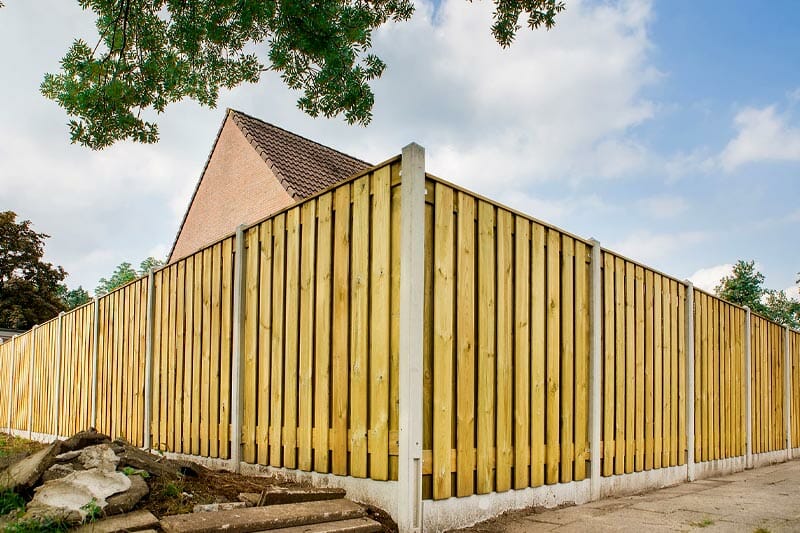
Benefits of installing a fence
- It grows the value of your property.
- Improves the security of your property.
- Demarcates your land.
- Enhances privacy.
Hire a pro to install your fence
Homegardenguides.com is a free tool to hire professional fence installation service providers.
It connects homeowners to professionals in the following easy steps.
- Enter your zip code at the top of the tool.
- Fill in the form to provide more details about the fence installation service you need.
- You will receive three or four quotes and advice from professional fence installers.
- Contact and hire a service provider that falls within your budget.

Many landowners are keen on figuring out the cost to fence a half-acre lot. The initial step involves calculating the specific length of your property in feet.
A 1/2 acre lot is 21,780 square feet and 418 linear feet around the perimeter. This means you will need 418 feet of fencing material for 1/2 an acre lot (836 for 1 acre).
Most fences have fence posts 8 feet apart, so to fence a 1/2 acre lot, you will need 52 fence posts.
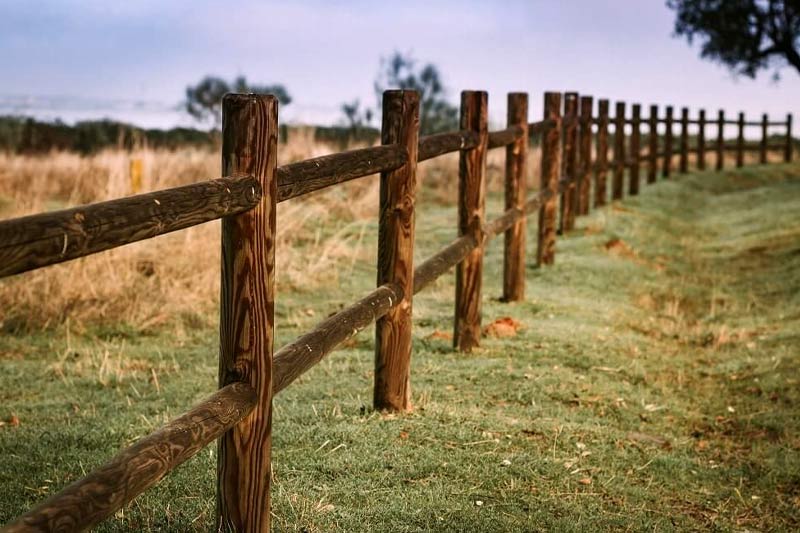
Fence length for a 1/4 acre lot?
The most common yard size is 1/4 acre or 10,890 square feet. For the fence length, we need the perimeter in linear feet.
The perimeter of 1/4 acres = 209 linear feet.
As most fences have an 8-foot space between the fence posts you will need 26 fence posts for a 1/4 acre plot.
How much does it cost to fence 1/2 acre lot?
It costs $1,000 to $20,000 to fence a 1/2-acre lot. How much you pay depends on a range of factors.
Average cost of fencing a 1/2 acre lot by material type
| Fence material | Cost per foot |
|---|---|
| Barbed Wire | $1 - $6 |
| Woven Wire | $2 - $4 |
| Wood | $10 - $20 |
| Split Rail Fencing | $10 - $20 |
| Vinyl | $20 - $25 |
| Aluminum | $20 - $35 |
| Wrought Iron | $20 - $35 |
Barbed wire
A barbed wire fence will cost you $1 to $6 per foot to install. You will pay $600 to $4,000 to fence your acre of land with barbed wire.
Woven wire fence
A woven wire fence costs $2 to $4 per foot. You will pay $1,200 to $2,400 to fence a ½-acre lot with a woven wire fence.
Wood fencing
It costs $10 to $20 per foot to install a wooden fence. You will pay $5,000 to $12,000 to install a wood fence on a ½ acre.
Wooden fences are suitable for both homes and agricultural land.
Vinyl
Installing a vinyl fence costs $20 to $25 per foot. You will pay $10,000 to $18,000 to fence a 1/2-acre lot with vinyl.
It is lightweight, durable, and long-lasting.
Aluminum
Aluminum is an expensive fence material.
It costs $20 to $35 per foot to install an aluminum fence. You will pay $12,000 to $21,000.
Aluminum is attractive, lightweight, and does not rust. It is used mostly for residential fencing.
Wrought iron
Installing a wrought iron fence costs $20 to $35. It is a common residential fence for its sturdiness and attractiveness.
Split rail fencing
Split rail fences cost $10 to $20 per foot to install.
You will pay $6000 to $12,000 to install it on ½ acre. The total cost of a split rail fence depends on the type of wood.
One disadvantage of the split rail fence is its maintenance. Wood needs regular repainting and sealing to eliminate the risk of rot and pest infestation which affect its durability.
Factors to consider when fencing your land
Size of the land
The larger your land, the more it costs to fence. The size of the land determines how long it takes to fence your land.
If you hire a professional installer, the longer the work takes, the more you pay.
Choice of fence materials
Prices of fence materials vary. The more expensive the material the higher the fencing cost.
Type of fence
There are many types of fences you can install.
Various types of fences have different costs. Other types such as wooden fences require more maintenance which makes them expensive in the long run.
Permits
Permits usually increase the cost of fencing. Depending on your location, you may or may not need to apply for a fencing permit.
If you are unsure of the details, consult a professional or a government agent for more information. The more you pay for a permit the higher your fencing costs.
DIY or hire a pro
You can DIY or hire a pro for the fence installation. DIY saves you money.
The cost of hiring a pro will vary depending on the materials, the condition of the land, and the type of fence you need.
Job complexity
The condition of the land also affects the cost of fencing. The presence of trees, rocks, and ungraded land will increase the installation cost as the land will need grading, and the rocks will have to be removed.
How to save money on your fencing project
- Get affordable fencing materials.
- Make accurate estimates on the size of the land to purchase the right amount of fence materials.
- Choose an affordable style for your fence.
- DIY fence installation.
- Finish some tasks by yourself to save the money you pay to professional installers.
- Get three quotes from professional fence installers to find out the right price.
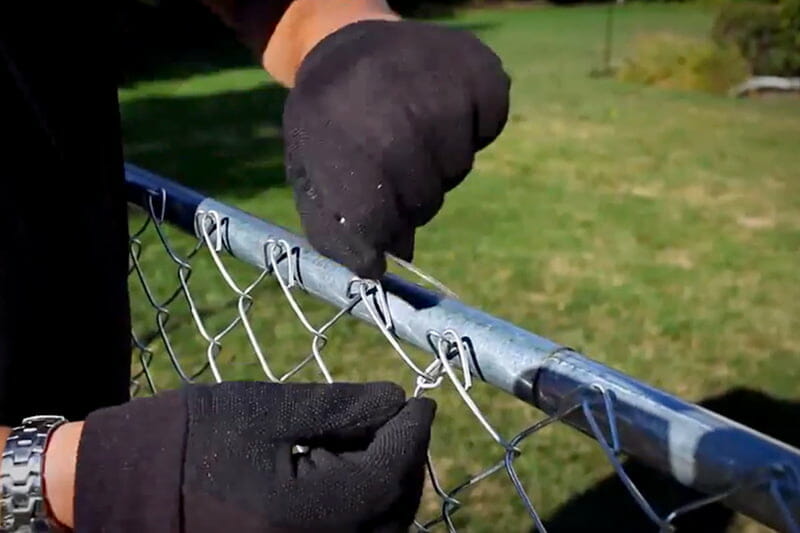
Benefits of installing a fence
- Increase the value of your property.
- Enhance the security of your property.
- Fences mark the boundaries of your land.
Hire a pro to install your fence
Homegardenguides.com is a free tool to hire professional fence installation service providers.
It connects homeowners to professionals in the following easy steps.
- Enter your zip code at the top of the tool.
- Fill in the form to provide more details about the fence installation service you need.
- You will receive three or four quotes and advice from professional fence installers.
- Contact and hire a service provider that falls within your budget.

Installing a barrier for farming needs to keep livestock enclosed is crucial and offers great advantages as it secures your domestic animals in a specified zone.
In having a fence to help contain and safeguard your livestock, you can expect to spend between $1 to $8 per linear foot. This estimated cost can differ depending on the type of fence, the size of the project, the height, and others.
In selecting the type of fence that you want to have installed, you should first consider the kind of livestock you are keeping, the quality that you want, and the purposes that you want your fence to be of use for.
Types of livestock fencing and their costs
High-tensile fencing
One of the most effective and worthwhile fencing types.
The best option for livestock because of its robust characteristics, and construction design.
Is relatively easy to install, but would require multiple strands to properly secure your perimeter.
| High-tensile wire type | Average cost range |
|---|---|
| High-Tensile Wire (Non-Electric) | $0.02 - $0.03 per strand |
| High-Tensile Bare Wire (Electric) | $0.03 - $0.12 per strand |
| High-Tensile Barbed Wire | $0.03 - $0.05 per strand |
| Electric High-Tensile Polymer | $0.10 - $0.15 per line |
| High-Tensile Polymer Rail | $0.80 - $0.90 |
| High-Tensile Polymer (Non-Electric) | $0.11 - $0.13 per line |
Barbed wire fence
Commonly used for keeping livestock and cattle in a provided area, this type of fence is typically made of steel, with sharp and pointed wires sticking out for added security.
Intruders, animals, or predators are repelled by the barbs that can cause injury. This also adds another layer of security for those who attempt to break or pass through the wire.
For barbed wire fences, there are two types: security and livestock.
For reference, below are the average prices for barbed wire fences:
| Description | Average Cost |
|---|---|
| Barbed Wire Fence per foot (Livestock) | $1.25 to $3.50 per foot |
| Barbed Wire Fence per foot (Security/Razor) | $1 to $3 per foot |
| Barbed Wire (Construction) 5 strands 12-gauge For a 1,300-foot fence | $1,900 |
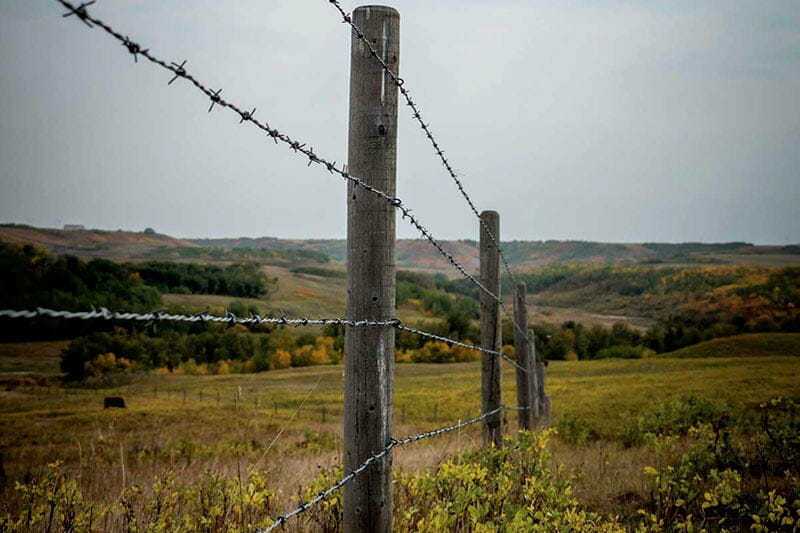
Chain link wire fence
Is usually paired with barbed wire fencing for optimum effectiveness and security. However, for those who don’t want the risk of injuring their livestock, it can also act as a standalone fence.
Cost-friendly and lightweight, yet strong enough to create an effective boundary marker for properties, residential markers, pet spaces, and small livestock.
For reference, below are the average prices for chain link wire fences:
| Description | Average Cost per linear foot |
|---|---|
| Chain Link Fence (4ft height) | $7 to $12 |
| Additional Height | $1 to $2 |
| Additional Privacy Slats | $3 to $5 |
| Additional Fabric Screen | $3 |
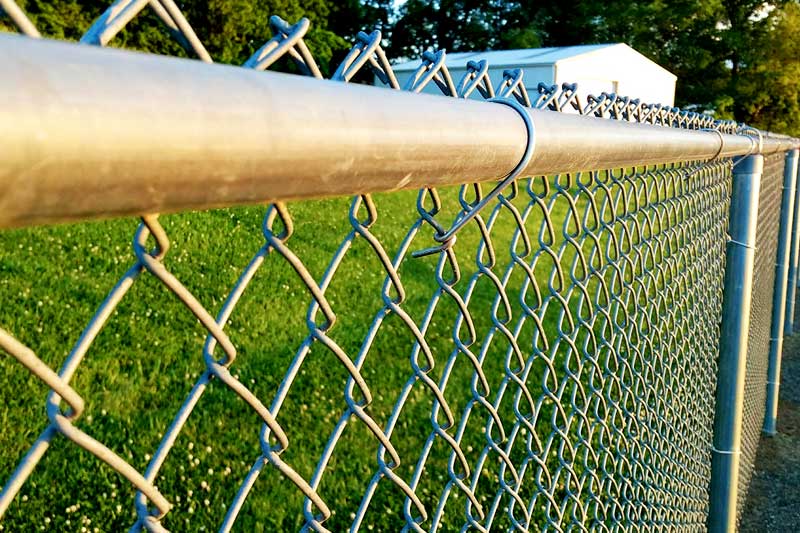
Chicken wire fence
Chicken wire fences are commonly used for their flexible, strong, and durable characteristics.
Named after its most common purpose, chicken wire fences are also used to keep squirrels, rabbits, mice, and other small animals contained safely in a specific area..
The average cost to install a chicken wire fence can range between $2 to $4.50 per linear foot.
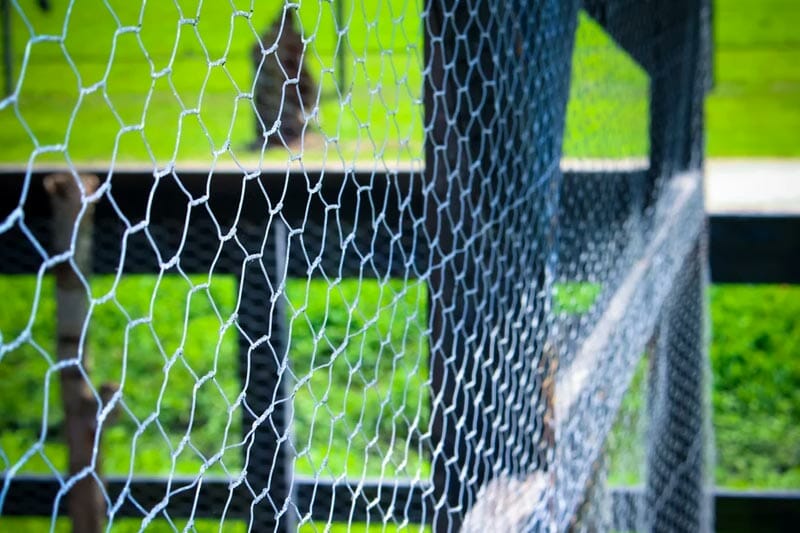
Horse fencing
This type of livestock fencing also has various styles, and a variety of materials that you can choose from such as metal pipes, classic split rail wood, or even electric.
The cost to install a horse fence can include multiple factors such as the size of the field needing to be fenced, the selection of materials, labor costs, and the height of the fence.
The cost to install a horse fence can run between the ballpark range of $3.70 to $30 per linear foot. Normally, installing a horse fence for a 100-linear feet area can run between $1,500 to $3,200.
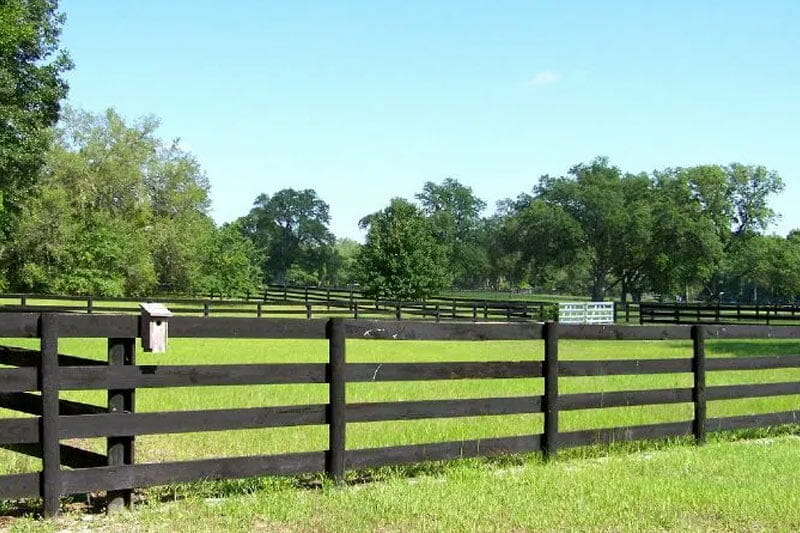
Woven wire fence
Also known as “page wire” or “sheep fencing”, a woven wire fence is made of wire nets of lightweight horizontal and vertical wire that are intersected with one another.
Typically, this wire is stretched and attached to opposite fence posts to enclose a given area.
For optimum security, property owners often pair this fence type with barbs at the top as a way of increasing its effectiveness.
For reference, below is the average cost for installing a woven wire fence:
| Description | Average Cost |
|---|---|
| Woven Wire Fence | $1.48 to $1.85 per linear foot |
| Woven Wire Fence 100 feet long; 5 feet height 2” x 4” mesh | $180 per roll |
| Woven Wire (4ft by 300ft) 330 feet length; 4 feet height 6” by 6” mesh | $189 per roll |

Fence post cost for livestock fencing
Normally, for any fence to be effective and efficient, they need to be attached to sturdy and reliable posts.
When it comes to installing a livestock fence, the charge for the posts is typically part of the total expense of the fencing project. Although this may be applicable in bulk projects, you may have to pay for them individually in some situations.
For instance, if you only need to repair, or replace a damaged fence post, or if you deem extending your fenced property, you may only need to purchase it individually as additional material.
You can spend somewhere between $20 to $60 to purchase a fence post, including the cost of its installation. The factors that can affect the cost can differ based on the type of the fence, the material of the fence, and its height.
To help you choose the type of fence post that best serves your type of livestock fence, below are two of the widely used variations:
Wood fence post
Wooden fence posts come in different kinds and thicknesses, which can be used for various types of fences.
Some wooden fence posts can be installed with decorative elements for added visual appeal.
For fences that use wooden frames, pairing it with this type of fence post adds a visual coherence, and can be visually pleasing.
The average cost for a wooden fence post is around $20 to $50 per post.
Metal fence post
Depending on the required foundation of your chosen fence type, there is a variety of metal fence posts that you can choose. These variations differ from thinner rods to more solid, robust pieces.
For lightweight fencing, thinner metal posts are more appropriate and sufficient.
For heavy and stronger fences, thick and sturdier fence posts are required and are suitable.
Typically, metal posts can be more durable compared to its counterparts. Additionally, metal posts require less maintenance and upkeep.
While they may be more durable, metal fence posts can be less appealing compared to wooden fence posts. However, decorative elements can still be attached to it.
The average cost for a metal fence can run between $25 to $60 each.
Other types of livestock fencing and their characteristics
Most of the time, property owners who keep livestock prefer a certain type of fencing to help protect and keep their animals and agriculture. Normally, a single type of fence is not a one-shoe-fits-all since each serves a specific purpose.
Typically, it can be tricky to keep sheep, goats, pigs, and poultry in a given space since they can easily climb over and crawl under certain types of fences. Luckily there are types of livestock fences that can solve this problem.
Below are some of the types of livestock fencing and their characteristics:
| Types of livestock fences | Characteristics |
|---|---|
| Hinge joint fence | Also referred to as farm fencing, this type has four wrap hinge joints that intertwine the wires. Has various height options to help keep different animals. Various horizontal wire spacing to allow various growth periods and tensile strength. Is best for safekeeping rabbits, cats, chickens, sheep, deers, and horses. |
| Fixed knot fence | This type combines the hinge joint with high tensile steel wire, which has stronger fabrics and can be installed faster with lesser use of fence posts. Comes in various height variations, which can cater to your livestock fencing needs, depending on the animal that you want to safe keep. Is ideal for safekeeping cattle, camels, horses, and deers. |
| High tensile wire fencing | This type of fencing makes use of highly robust, and high-tension wires that are not stretchable. With this, the wire prevents animals from passing and climbing through, since it cannot be easily bent or damaged. Utilizes lesser fence posts, and can be installed with wider spacing. While this type can be more on the costly side, high tensile wire fencing has a longer lifespan. |
| Chicken wire fence | Chicken wire adopts the characteristics of galvanized wire, stainless steel wire, and PVC coated wire. The result allows for an impressive anti-corrosion and durable fence wire. With steel wires that are woven into hexagon meshes, the chicken wire fence is a great choice for lightweight fencing. This type is ideal for keeping chickens, goose, rabbits, other small animals, and garden purposes. |
| Barbed wire fencing | Barbed wire fencing serves as highly effective for keeping docile livestock such as cattle. Its effectiveness comes from its construction where it repels animals or people away from the fence because of its pointed edges. This type is not advised for people who are keeping horses or camels who are at risk of running into the fence and causing themselves unwanted injuries. |
| Steel wire hex deer fence | Also called metal hex deer fencing, this type is metal coated with black PVC, allowing it to be the best deer fencing. It can offer less visible, more durable, and stronger deer fencing. This is best for property owners who keep deers who frequently damage fences from chewing, or for those who want to have better fencing. |
Labor cost to install a livestock fence
Typically, it would take a professional 1 to 3 days to finish a fence project. Although this may be a reliable estimate, the actual duration can still differ depending on factors such as the fence type, the size of the project, and other conditions.
If you hire a professional to install your livestock fence, you can expect to spend around $40 to $60 per hour. This estimated cost translates to $0.92 to $5 per foot in labor costs.
On top of the standard labor cost, another factor can contribute to the cost. For instance, if your terrain is uneven, you may be required to have it re-sloped. Availing of this necessary service can cost you an average of $1,300.
While it may be obvious that the total cost of your entire fencing project may balloon because of the labor costs, this investment will not be wasted.
Installing a livestock fence: DIY vs hiring a contractor
Having a livestock fence installed on your property can be quite taxing and difficult, especially if you are not used to working with heavy tools and extensive labor.
While hiring a professional can increase your total cost, this expense can come advantageous and necessary because you can assure that the person who is keeping your livestock safe is of experience and expertise.
Additionally, hiring a professional can assure you that your livestock fence is secure and professionally done, saving you the trouble of paying for any rework or repair in case the fence is badly installed or poorly done.
How much does it cost to install pipe fencing, which is known as one of the leading methods of fencing for farms?
You will pay $10-$15 per foot for pipe fencing. The price includes the cost of materials and installation. The average cost of materials ranges from $2 to $20 per foot.
How much you will pay for the pipe fencing projects depends on the size of the land.
What is a pipe fence
A pipe fence is a fence made of metal pipes. It is corrosion-resistant and robust. Consequently, it has a useful lifespan of about 20-30 years.
Many farms use pipe fences. However, you can use them on any other type of land.
Factors affecting pipe fence cost
Fencing material
The fence material you choose to use determines how much land fencing will cost.
Metal makes most pipes for fencing. The price of steel has been rising over the last few years. As a result, it will cost you more to fence your land with pipe fencing than wooden posts or any other cheaper material.
You will pay $7-$10 per foot of pipe fencing, while it costs $3-$9 per foot when you use wooden posts.
Further, the fencing material you choose depends on the type of land you are fencing and its use.

Size of the land
The size of the land to fence implies how much money you will spend. The larger the plot, the more you will pay.
The amount of materials you need depends on the size of the land. The more materials you need, the more you will spend on fencing.
Further, the larger the land, the more you pay for labor.
Pipe fencing is suitable for any size of land. You can use it in small plots or large farms.
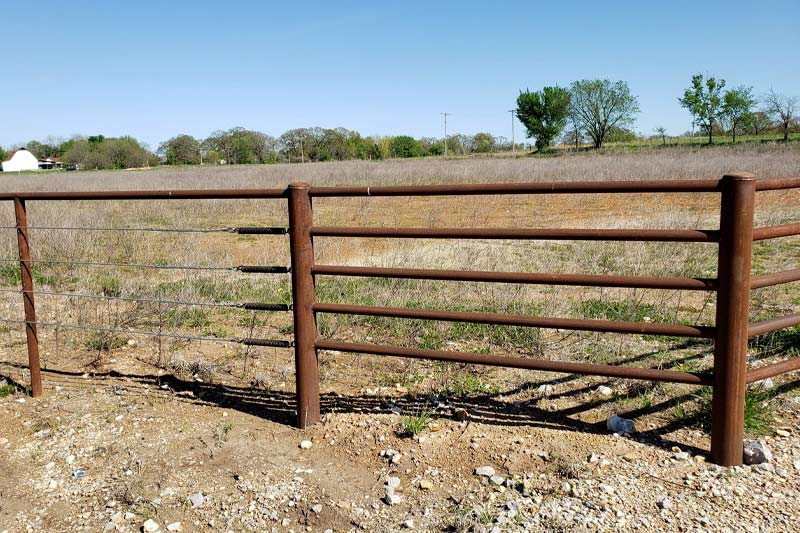
Land topography
How the land looks also determines how much you spend on fencing.
It costs more to fence a sloping land than flat land.
Since sloping land is harder to work on, it will cost you more to fence it.
When working on flat land, the work will move fast and will not require advanced tools or carrying heavy loads over large distances.
Usually, sloping land needs grading to make it easy to work. The cost of grading increases the cost of fencing.
Labor cost
You can DIY or hire a pro to help install a fence on your land. You will save on labor costs if you DIY. However, fencing land is a job best left to professionals.
The larger your land, the more you will pay for fencing. The slopier your land, the more difficult it is to work on, and the more you will pay.
Labor cost is additional to the material cost. Hence, increasing the fencing cost. Labor costs depend on the location of your land, the expertise of those you hire, and more.
Fence height
The higher the fence, the more it costs.
Fences are 6ft high. However, depending on the land you are fencing, you may need a higher one. Privacy fences are at least 8ft in height.
The higher the fence, the more materials it needs. Thus, the higher the cost. It will also take longer to install, increasing the labor costs.
Obstacles on the land
The more obstacles on the land, the higher the fencing cost. Trees are some of the fencing obstacles.
If there are trees on the fencing path, you have to remove them or go around them. Tree removal is expensive and is an additional cost when fencing your land.
If you have to go around the trees, you increase the distance for fence laying. As a result, you will need more posts which increases the cost of fencing.
Existing fence
Replacing an existing fence increases the cost of fencing. The pros you hire will charge extra for old fence removal. Also, it increases the time for new fence installation.
It is best to remove the fence before your hired pros get to the site. It will help you save money.
If your existing fence is usable, you can repair it. It will save you the cost of purchasing and installing a new one.
Benefits of pipe fencing
Strength
Metal pipes have sufficient tensile strength compared to other fencing posts. They can withstand strong hits without denting or breaking, unlike wooden posts. Steel pipes are difficult to ram down when properly installed.
Cost-effective
While it may be expensive to purchase and install pipe fencing, its usage is cost-effective. Once installed, it requires little maintenance. Since it does not attract pests, you do not have to keep inspecting and spraying chemicals.
Additionally, it is corrosion-resistant. You will not incur additional expenses to paint it regularly. Steel pipe fencing is also fire-resistant.
Durability
Steel pipes have a long lifespan. They last for 25-30 years before you have to replace them. Combined with its low maintenance cost, you have a fence that you will not need to spend money on after installation.
Eco-friendly
Recycled scrap metal is the source of material to manufacture pipe fencing. Thus, making it an environmentally friendly product. It does not leave any residue on the ground as it ages. Additionally, the pipes can be recycled and made into other steel products or new pipe fencing when removed.
Easy to install
Steel fence pipes are not as bulky as wooden posts making them easy to work.
When you use hydraulic drivers, you can install the pipes without digging or pouring concrete. Thus, you save time when working with steel than other materials.
Alternative farm fencing methods
High tensile wire fence
A high tensile wire fence can either be electric or non-electric. You will need six strands of the wire for proper fencing.
It costs $0.12-$0.18 per foot to purchase the non-electric high tensile wire. You will pay $0.18-$0.72 per foot to purchase the electric tensile wire fence materials. You will also pay additional labor costs to install the fence on your land.
It is durable and low-maintenance. Suitable for ranch fencing due to its high tensile strength. Animals get easily entangled by the wire due to its low visibility. You can use markers to make it more visible.
Vinyl horse fence
You will pay $0.90 to $1.60 per rail per foot of vinyl horse fence. Its price is considerably high compared to steel pipe fencing or other materials.
Vinyl is durable and requires little maintenance. It is best used in warm climate regions. In cold regions, it can become brittle and break.
Vinyl fences can be used at home and on agricultural land. It is safe for animals and people. Further, it does not break easily and will not injure animals or people.

Split rail fencing
You will pay $12-$30 per foot to purchase materials and install split rail fencing on your land. It keeps animals from straying and demarcates land easily.
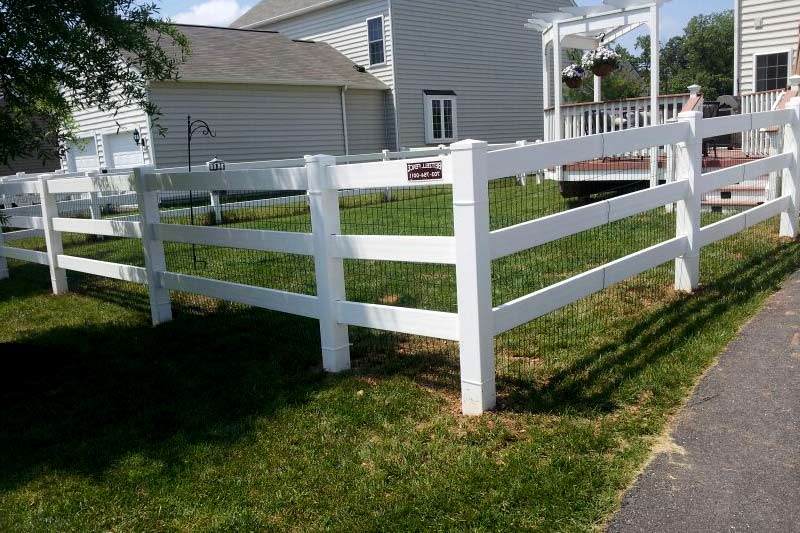
Barbed wire
Barbed wire is the cheapest farm fencing alternative. It costs $0.03-$0,05 per strand per foot. It is ideal for farmland. It keeps animals enclosed and safe.
Barbed wire requires regular inspection and tightening if it gets loose. It has sharp parts that may injure your animals when they get too close.

No climb fence
Post and rail or field fences can also add no climb mesh to better protect livestock. It costs $1.39-$1.89 for materials only. It is attractive and strong enough to keep animals from straying or knocking them down. It is best installed in even landscapes and may require regular tightening to keep it working well.
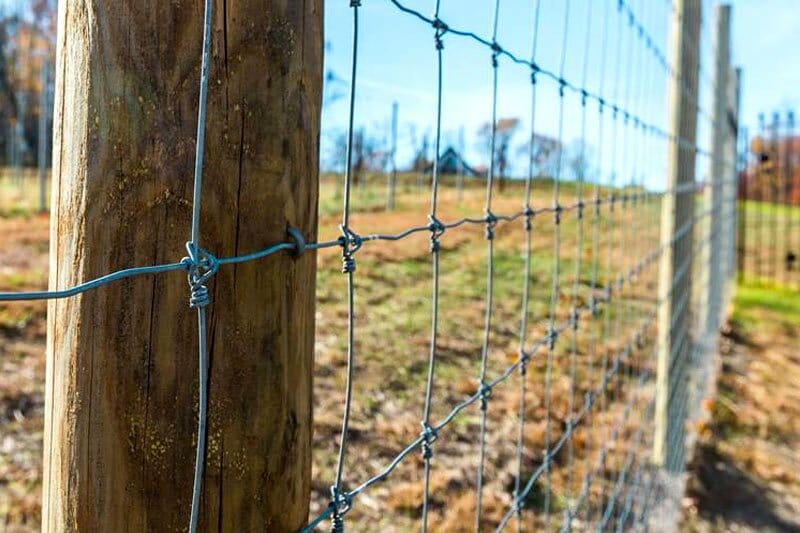
DIY vs hiring a pro cost
Depending on the fence materials you use, you can DIY or hire a pro for fence installation.
DIY pros
- Save money. You only spend money on the purchase of materials. It will cost you $2-$20 per linear foot to install a fence by yourself.
- Install the fence as you want.
DIY cons
- You may have to hire tools if you do not have your own. It may use up the money you saved and more.
- Likely to make errors if you do not know how to install fences.
- May take you a lot of time.
Pros of hiring a pro
- Saves time since the work is completed by trained professionals.
- No errors.
- Pros are insured to pay for medical injuries and other accidents at the site.
- May bring their materials
- High quality of workmanship.
Cons of hiring a pro
- Expensive. It costs $4 to $26 for a pro to install a fence on your land. The cost includes materials and labor.
How to hire a pro for your pipe fencing
Homegardenguides.com is a free tool to hire professional fence installation service providers.
It connects homeowners to professionals in the following easy steps.
- Enter your zip code at the top of the tool.
- Fill in the form to provide more details about the fencing service you need.
- You will receive three or four quotes and advice from professional fence materials and installation companies
- Contact and hire a land clearing service that falls within your budget.

Factors to consider when choosing a fence design
Cost
When choosing a fence design, you must have a budget. Your budget will provide the direction in how you design your fence.
The higher the budget, the more expensive materials you can get and the higher you can pay pros. Consequently, the more exquisite the fence design you can get.
A low budget allows you to purchase low-priced fence materials and limits you to affordable fence designs.
Fencing costs quickly add up. Thus, the higher your budget, the better a fence design you can get.
Lifespan
When choosing a fence design, you need to consider the durability of the fence. How long a fence life is determined by the fence material. Some have a longer lifespan than others.
Pests and rotting affect the lifespan of wooden fence posts. Consequently, wooden fences will not have a long lifespan.
Steel pipe fences are not affected by pests and rotting, and neither do they rust. Thus, they have a lifespan of 25-30 years, They are also affordable to purchase and are low maintenance, making them ideal for fence materials.
Intended use
The intended use of a fence determines its design. A fence installed at home will have a different design from one at a farm. A privacy fence has a different design from a picket fence even when you use the same material.
When choosing a fence design, ensure that you know where the fence will be installed. The location of the fence also determines its intended use.
Maintenance
When choosing a fence design, determine how much money and time you will spend to maintain the fence. The higher the maintenance cost, the more expensive it is to keep or install the fence. A fence should be easy to maintain.
Different fence materials have different maintenance requirements. Wooden fences require more maintenance than other types. They have to be treated and painted to prevent pests and rotting. They also need proper drainage to prevent them from rotting when they touch the water.
Other materials may only require painting every few years.
Installation
Depending on the design you choose, you could DIY or hire a pro to install the fence. The easier the design, the easier it is to install the fence by yourself. For a complicated design, you will have to hire a pro to install it.
Permits
Depending on where you live, you may need a permit to install a fence. Consult with a pro to find out if you do.
Putting up a fence around your home or property can significantly increase privacy and security. It also offers reassurance for your family and pets. Moreover, a fence introduces a fashionable feature that enhances the look of your home.
Homeowners can expect to spend an average cost range of $5 to $12 per linear foot for the materials, and an average cost range of $15 to $22 per linear foot for installing a horizontal fence.
While it was more common to have a vertical fence, installing a horizontal fence has slowly gained popularity because of its modern look. Aside from that, it makes properties appear longer and bigger, without forsaking the added privacy.
Horizontal wood fence prices by type/species
Often, homeowners or property owners can already assume to pay more or less based on the height and length of the fence. However, one cost factor that is often overlooked is the type of wood selected for the fence.
Most of the time, fences are made from treated redwood, cedar, pine, or other water-resistant lumber material. Some homeowners also prefer to seal and apply something to it to not let it warp and rot.
Below are some of the most preferred types of lumber used for installing a 6-foot-tall fence, their pros and cons, and their average costs per linear foot of material.
| Type of wood | Pros | Cons | Average cost (per linear foot) |
|---|---|---|---|
| Cedar | Insect and rot repellant if it is pressure treated Cost-friendly | Requires yearly maintenance such as sealing, sanding, and wood-staining Can be dented and scratched easily Turns gray over time if not properly sealed and stained. | $3 to $7 |
| Spruce or Whitewood | Cost-friendly | Can decay in 8 to 10 years Prone to graying or darkening The pickets tend to shrink wherever it dries | $6 to $7 |
| Redwood | Best for staining and repainting Naturally fire-resistant and pest-repellant Do not easily warp | Can easily develop mold and damage by the sun if not properly and regularly maintained | $4 to $7 |
| Pressure-Treated Pine | Cost-Friendly Insect-repellant and does not easily rot if pressure-treated | Can warp, split, and shrink especially in dry environments If burned, the pressure-treated pine will release harmful chemicals if burned | $3 to $7 |
| Cypress | Durable and dense type of wood that is similar to pine Has natural components that can be insect and pest-repellant Rot-resistant and can last for a long time, especially in areas that experience rain and snow | Costly | $10 to $15 |
| White Oak | Can last for a long time, especially when you treat the wood A popular choice due to its light finishes Can be resistant to rotting | Is on the pricier side Can warp and bow especially in extremely damp and humid environments | $15 to $40 |
| Black Locust | Very durable and does not require extensive maintenance Ideal for agricultural purposes where maintenance is not as frequent | Due to its rarity compared to its counterparts, Black Locust wood panels can be expensive and hard to procure | $20 to $40 |
Horizontal fence post price
Normally, fence posts are made from wood, metal, or concrete that is then grounded in gravel, cement, or soil. Ultimately, the choice of your fence post depends on your liking and the construction requirements.
As a ballpark cost, purchasing a fence post can run up to $5 to $75 each, which excludes the fee for its installation or additional treatment.
The cost relies heavily on the type of material used in the fence post. Usually, properties or homeowners opt for wood posts for their wood fences to match the look. However; there are still other options available.
Below are the other options for fence posts, their average price per material, and their average cost of installation.
| Fence post type/ material | Average Cost (per material) | Average Cost (including installation) |
|---|---|---|
| Wood fence post | $5 to $20 | $10 to $50 |
| Concrete fence post | $10 to $50 | $30 to $100 |
| Metal fence post | $5 to $30 | $10 to $60 |
| Brick or stone fence post | $25 to $75 | $50 to $150 |
Hiring a fencing contractor
Before hiring a professional fencing contractor to help you have a quality horizontal wood fence, there are a few checklist items to tick before you have them start on the project.
The grade of material used for the fence
Normally, your price will depend on the quality of the wood you have chosen. Make sure that the contractor knows your needs and preferred option of wood and sticks to it when the project starts.
Sometimes, some wood types look similar to one another but are not necessarily the same, especially in their characteristics.
Quality of Materials
Ideally, your hired contractor must use stainless steel fasteners/nails. They should also avoid non-galvanized steel that can darken or bleed black in your fresh fence.
The grade of steel
As a rule of thumb in using steel posts, you should not have them install less than schedule-20 steel posts. Any type under that standard will easily break, especially in heavy winds.
Warranty and quality of service
Your hired contractors should have a history and certification in honoring labor warranties.
The hired professional should also have the necessary experience and expertise in constructing and installing horizontal wood fences.
Clear deal and contract
Before signing a professional on your fencing project, you should make sure that the terms are clear and not vague. Items such as labor fees, additional costs, warranties, and others should be agreed upon.
Doing so does not only protect your interests but would also assure the hired contractor that the project is arranged and will be worthwhile.

Cost to DIY a horizontal wood fence
Homeowners that are familiar with home improvement and have power tools will find the building and installation of a wood fence easy. Doing so can save money since it does not require paying for a professional’s service.
However, having zero experience in home improvements can make the task very difficult. In this case, hiring a contractor to handle the fencing project might be the smarter choice.
If you are unsure if you can do it yourself, you might end up spending thousands and loads of hours, only to have an unsatisfactory fence for your property.
Necessary tools/factors to consider before DIY horizontal wood fence installation
Below are some of the necessary items and factors that you need to have and consider before doing a DIY horizontal fence:
Equipment and tools
Normally, you would need tools to build a horizontal fence. If you already own some of these, you won’t need to spend on another one. If you don’t, below are some of the tools and their average prices.
| Equipment / Tool | Average cost |
|---|---|
| Work Gloves | $5 |
| Protective Safety Glasses | $16 |
| Paint Brush | $15 |
| Spray Paint | $5 |
| Mason’s Line | $15 |
| Tape Measure | $18 |
| Hand Saw | $16 |
| Claw Hammer | $20 |
| Post Hole Digger | $50 |
| Power Drill | $80 |
| Level | $21 |
| Total | $266 |
Materials
Typically, the cost for the materials will depend on the type of wood that you will use and the size of the area where you will install your fence. Below are the ballpark costs of the necessary materials:
| Materials | Cost (per item) | Cost (per 150-foot wood fence) |
|---|---|---|
| Box Nails | $12 | (not applicable) |
| Deck Screws | $23 | (not applicable) |
| Concrete Mix | $20 | (not applicable) |
| Gravel | $400 | (not applicable) |
| Wood Stain | $125 | (not applicable) |
| Pickets | $5 | $1,640 |
| Horizontal Rails | $13 | $1,640 |
| Fence Posts | $28 | $560 |
| Total | $3,300 |
Horizontal fence vs vertical fence
Aside from providing additional privacy and security to your home, horizontal and vertical fences can help define the borders of your property, regardless of whether yours is a residential or commercial property.
Below are some of the differences between horizontal and vertical fences:
The openness of backyard
Vertical fences can have boards with spaces in between boards that can offer visibility of your backyard. This variation can be best if you want your space not to be entirely closed off.
If you want your property to have total privacy, horizontal fences may be the best pick. This is because horizontal fences rarely have spaces in between the boards, which offers less visibility than its counterpart.
Durability and strength
Horizontal fences are more durable, especially in locations that experience rain and weather damage.
Vertical fences are more prone to natural rotting and weather damage since the top and the wood can easily rot at the base and exposed edges.
Privacy
Because of its general construction design, horizontal fences can guarantee reliable privacy for your property. Since its design has panels closer to each other, it can block external viewing.
With vertical fences, the panels or boards have more spaces in between, making external viewing possible. If you want more privacy with vertical fences, you can consider chain-link instead of wood.
Ease of installation
If you consider doing the fencing project on your own, whether it is a horizontal or vertical fence, you will most likely do it on your own and do a good job.
If your residential or commercial property has uneven terrain, it may be best if you hire a professional since they are more experienced in dealing with fencing on slopes.
Additionally, it might be more suitable to have vertical fencing since it can be challenging to opt for horizontal boards on irregular or uneven ground.
Other considerable differences that make horizontal fences different from its counterpart are the following:
| Horizontal fence | Vertical fence | |
|---|---|---|
| Appearance | Unique, modern, and appears sleeker and impressionable | Appears attractive, but is common and can be considered outdated |
| Cost | Can be more expensive and labor-extensive | Less expensive compared to its counterpart |
| Installation on uneven terrain | Can be more complicated to build on uneven ground or contoured ground. Horizontal fences are best installed on level surfaces. | Can easily be installed even on textured or uneven ground |
| Durability and strength | Can be less sturdy and durable, but can be remedied by installing more vertical posts | It Is more sturdy because of its construction design where it uses 2x4 stringer |
| Availability of pre-built wood panels | Horizontal fence panels must be built on-site | There are pre-built vertical panels that can be bought or ordered |
Advantages of a horizontal wood fence
As initially mentioned above, there are several differences that horizontal fences offer compared to vertical fences. These differences can either cater to your specific fencing needs or can convince you more to choose it.
Below are some of the notable advantages of having a horizontal fence installed.
Variety of styles and designs
One of the best parts of choosing a horizontal fence is that it comes with different styles and design choices. With this, you have multiple options to make your property appear the way you intend it to be.
With horizontal fences, you can choose between split rail, board on board, woven designs, and other types of styles and designs.
With this variety of options, you can make your fence distinct from others, adding more personality and look to your property.
Customizability
If you choose to have a horizontal fence for your home or commercial property, you will have the advantage because you can tweak it so it suits your preference and necessity.
For example, you can have wood-stained panels to match the existing items in your landscape or have them match your gate.
Environmentally friendly
One of the advantages of having horizontal wood fences, especially if you are conscious of the environment, is that they will not damage your surrounding even if they start to rot.
If they start to have damage or rot, you can stain them to repel termite damage. This also means that you do not have to use harmful chemicals that can be dangerous to your health and the environment.
Less waste
In constructing and installing horizontal fences, the panels or boards do not necessarily have to be the same size, unlike vertical fences. This helps you save more money since it won’t waste too much wood.
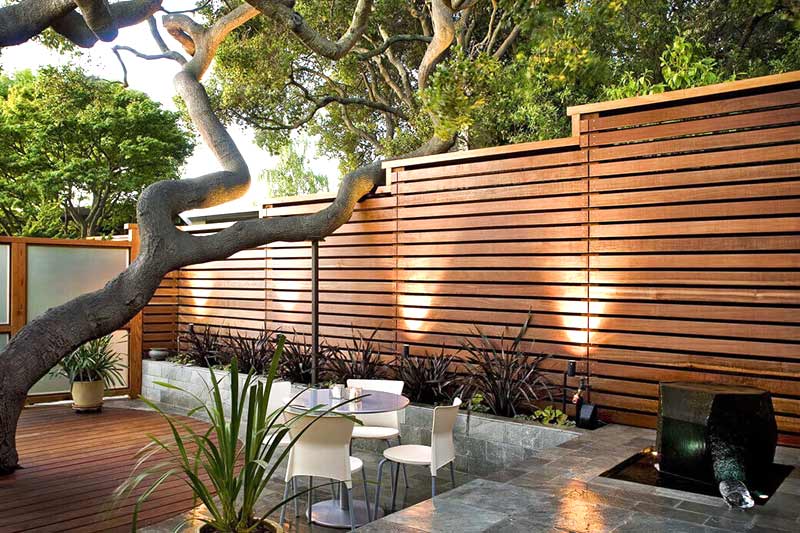
A residential fence is a barrier or structure built within a residential setting aimed at providing security, marking property limits, or serving as an aesthetic enhancement, with the middle line of the barrier positioned inside the established boundary of the property.
The types of residential fences can be divided into several groups such as wood fences, vinyl fences, ornamental iron fences, aluminum fences, chain link fences, and privacy fences. Which is best for you is a matter of taste, but many environmental factors can also influence your choice.
This article will help you choose a residential fence that will suit your needs, complement your home, be gentle with your budget, and provide the most security.
Types of residential fences
Let’s get to work and analyze the different fence types and their styles.
Wood fences
Wooden fences are the most popular type of residential fence among most homeowners. A wood fence is an attractive and secure option that will ensure your privacy, and with proper maintenance, it can last for decades.
Wood fencing is an affordable option that gives a classic, welcoming feeling to your home. Wood privacy fences are very versatile with various types of wood planks to choose to build your fence. The cost of the wood fence will vary depending on the type of lumber you select.
Styles of wood fences
Board on board
This style of wood fence is not a straightforward privacy style fence, but still, the view to the other side is possible when viewed on an angle. With the board on board wooden fences, there is a possibility for adjoining property owners because this style of fence shares a similar look on both sides of the fence so it has the same overall appearance.
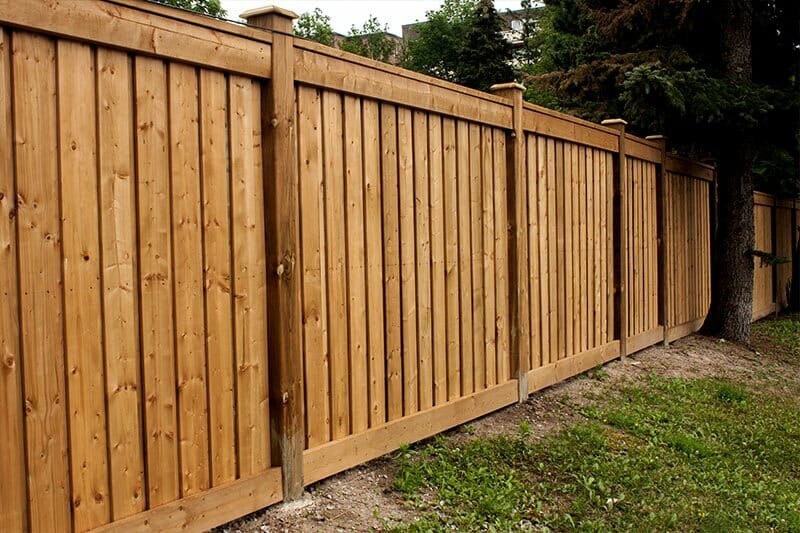
Board on batten
This type of fencing, also made from natural wood, is durable as its predecessor in this section and is stick-built and well-suited for steep grades. The addition of a lattice top, arch or dip, contributes to the enhancement of the standard fence appearance. In addition, upgrading to the standard post style can improve the fence’s overall appearance.
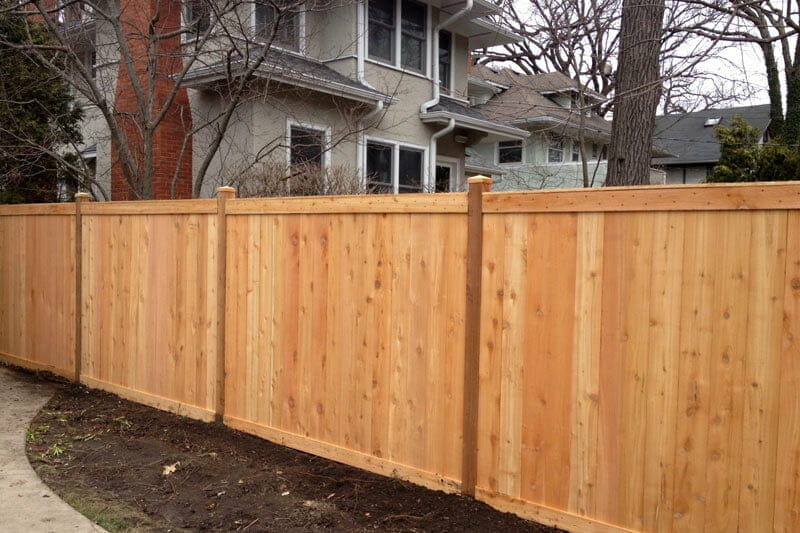
Split rail
Along with barn houses and green lawns, split rail fences are part of American culture and history since colonial days. A split rail fence as a structure is used to enclose livestock and designate the property.
From rural farmland to urban parks and homes, split rail fences can be used to complement many kinds of properties due to their effective and simple design.
In addition to being customizable and highly versatile, the simple design and little amount of material needed make the split rail fence a popular choice for many property owners who want to fence off their property at a low cost.
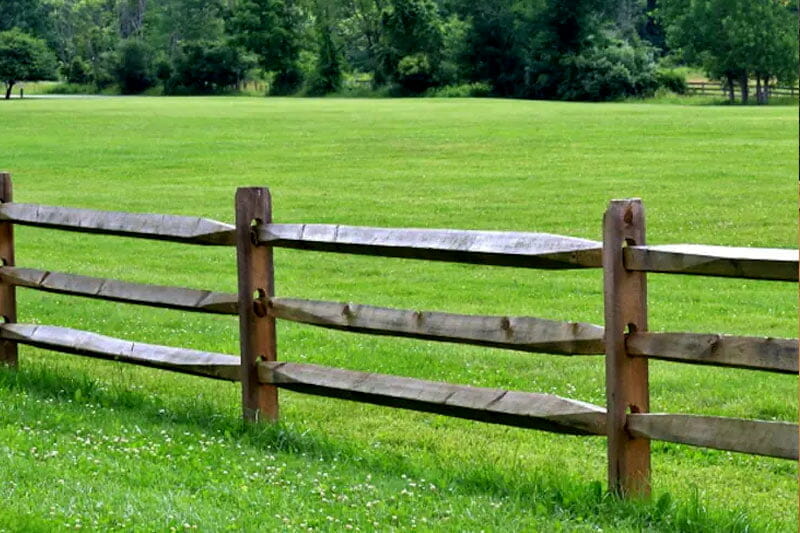
Stockade fence
Stockade fencing tightly places wood boards side-by-side. Often, the panels have pointed tops for security and style. Horizontal runner and sturdy fence posts give structure to the wood panels, providing strength and stability.
A stockade fence can provide an optimal balance of beauty, security, and value. Think about your fence as the container for your life – your property, your pets, and loved ones, and the space you inhabit for your daily activities and special occasions.
Given the value of the stockade fence, the quality matters. It should match the aesthetic of your space. It should beautify your home in its style and construction. It should protect what you love and offer you a sense of that protection in the time you spend within its walls. This container’s structure should match your values in preserving the environment in addition to your budget.
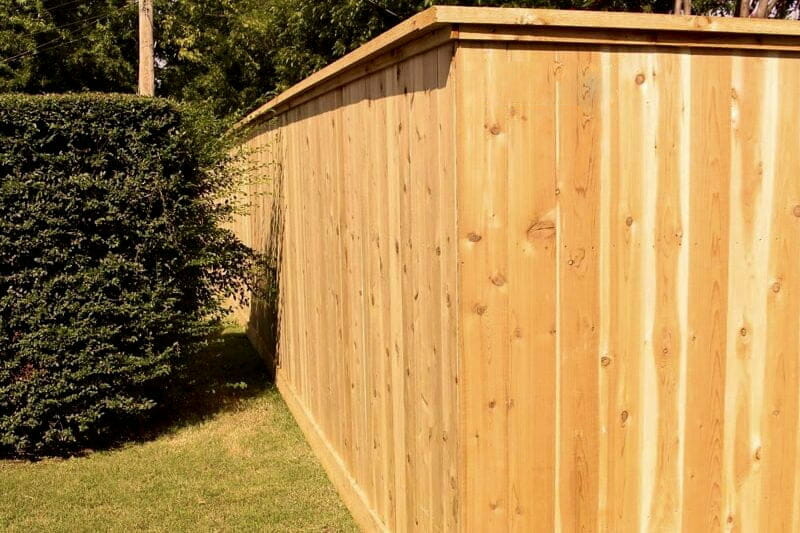
Spaced board
Spaced board fencing shares a similar look to a traditional picket fence but without a picket top. Flat edge boards are the basis of all constructions of the spaced boards.
If you want to add a warm look to your yard, a wide selection of space board fencing products can satisfy your need.
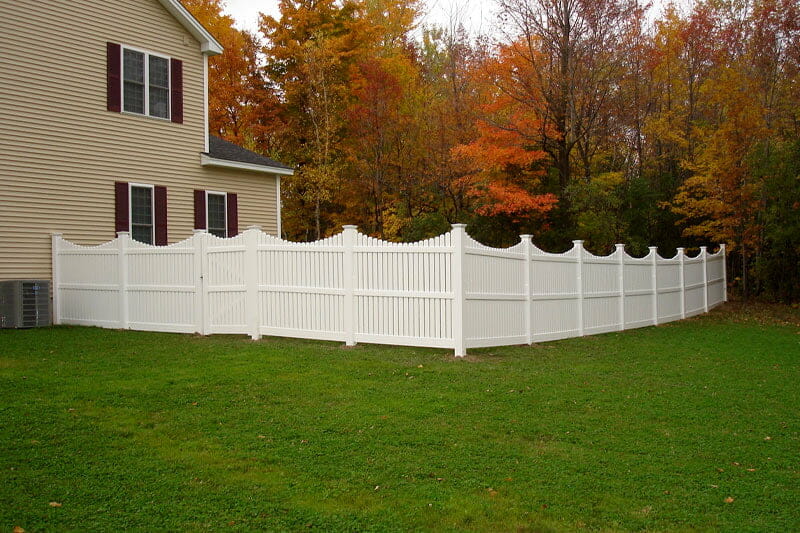
Wood pickets
White picket fences are as American as apple pie and backyard barbeques. Since colonial days, livestock and lawns have been fenced with a white picket fence. They are still popular these days, with many homeowners associations making them the go-to fence for residents.
Their design is simple but very effective and gives a charming and inviting feel to the home and beautify the property.
With picket fences, you have more advantages than just curb appeal. They are cost-effective because they require relatively little wood and are easy to install. Given their popularity, a well-maintained picket fence will add value to your home which making it an excellent investment for any homeowner.

Vertical board
In this particular style of fencing, the boards that comprise the fence section are placed adjacent to each other, but given that all lumber shrinks, some will develop between the vertical boards over time, hence it is considered to be virtually private.
The vertical board also creates a safe, private environment for your family to enjoy. Vertical board fencing is a durable fence option that is stick-built and well-suited for steep grades. Enhance the appearance with a cap board, lattice top, arch, or dip. In addition, there are a variety of fence post and cap options available to further enhance the look of the fence.
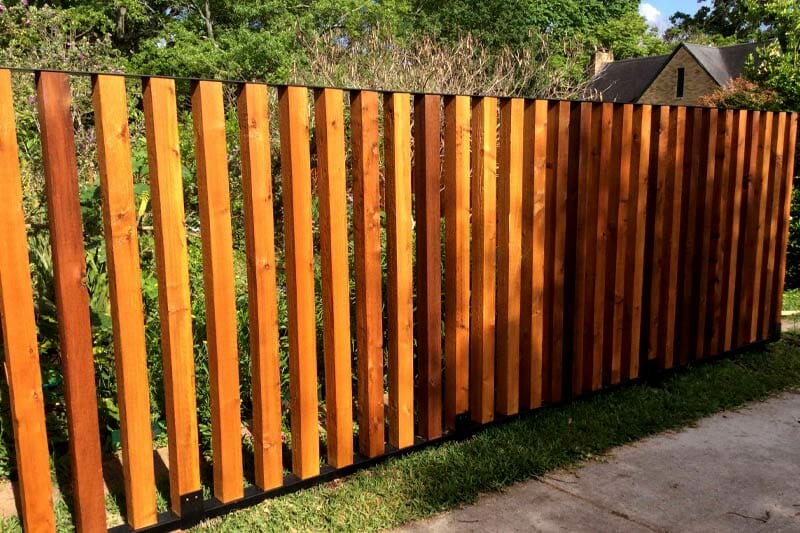
Use this FREE service
HomeGardenGuides.com is a free service that quickly matches you with top-voted local Fence Specialists.
You can get 3 estimates fast by real certified experts in your area in just 2 minutes.
- Scroll to the top of the page and enter your Zip code.
- Answer questions about your fencing project
- Your details are forwarded to three local experts. They will send you a price estimate for the job and some friendly advice.
IMPORTANT: There is no obligation to hire. This is a free tool and service to be used at your pleasure.
Why residential fence?
Residential fences can work their way in so many directions, and they are practical and can add some curb appeal to your property.
Fences are great for security purposes and for keeping children and pets safe and secure inside your property, and intruders and uninvited guests out. Certain residential fences can inhibit outsiders from being able to see into your home, these fences are known as privacy fences.
In one sentence, a fence defines your property boundaries and helps protect everything within those boundaries, including your privacy.
Another important role of the residential fences, and fences in general, is keeping your landscape safe. A beautiful garden with bright flowers or a finely trimmed lawn can be easily harmed and destroyed by animals, unscrupulous people walking through your yard. You must admit that a beautiful landscape and charming fences go hand in hand.
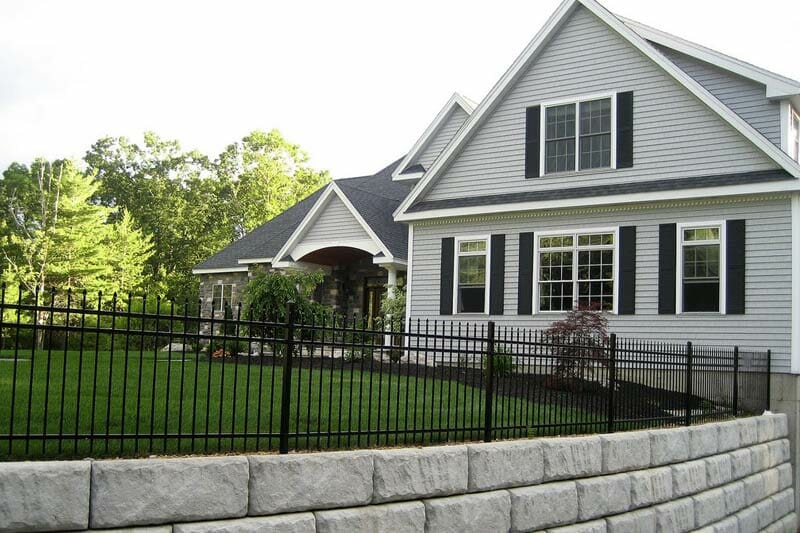
Vinyl fences
The popularity of vinyl fences is because they are strong, flexible, and secure. Maintenance of the vinyl fences is another advantage. They are almost completely maintenance-free and resist decay and most tough stains are removed easily with soap and water.
Vinyl fencing is a worthwhile investment in itself through its long-lasting and low-maintenance nature. Usually considered as a wood substitute, vinyl is a great choice if you are looking the best of both worlds, looking like wood but with low maintenance. Vinyl fencing is prone to rust and comes in a variety of colors and styles.
Styles of vinyl fences
Vinyl picket fence
Despite the visual appealing of vinyl picket fencing it also offers security for pets and children. A wide selection of vinyl picket fence options available on the market these days can help you add charm and beauty to your yard.
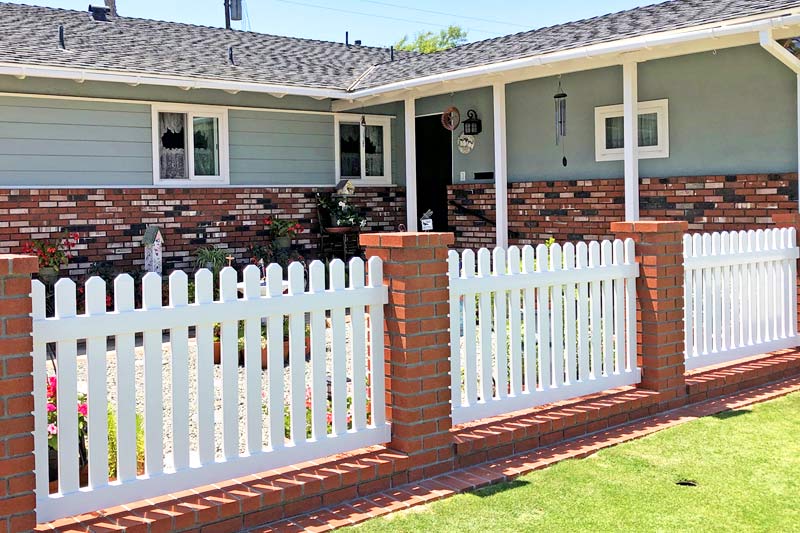
Vinyl privacy fence
Privacy fencing can help you increase property security, and minimize unwanted sights and unwanted visitors. Vinyl privacy fences are an ideal choice for people who live in populated areas, near a busy road or highway, or close to businesses and industrial centers.
Swimming pools and hot tubs go well with the seclusion that these fence styles offer. By installing vinyl privacy fences around a deck or patio can create a more intimate space for relaxing and entertaining.
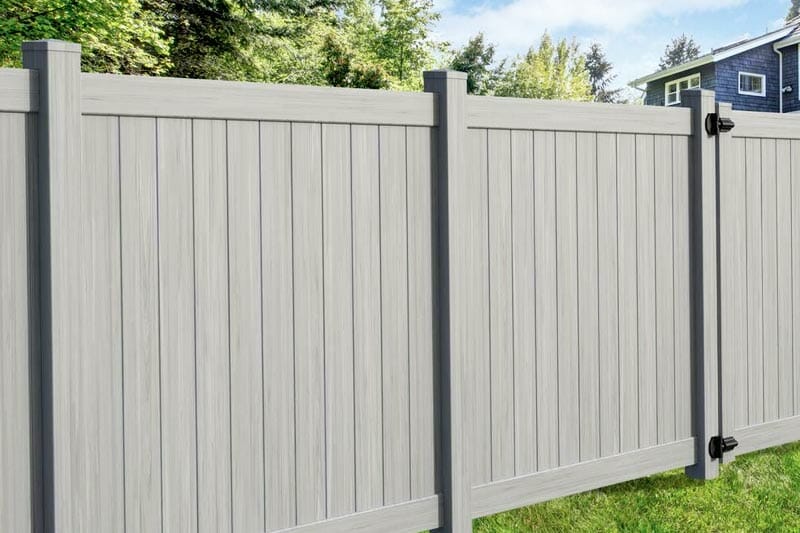
Crossbuck
Crossbuck estate vinyl fencing will provide a traditional look to any property without the regular maintenance of its wood counterpart.
This style of vinyl fencing imposed itself as a standard choice for farm or ranch fencing needs and is perfect for defining large property lines. Splinter-free surfaces and environmentally friendly make this an excellent choice for homeowners as well.
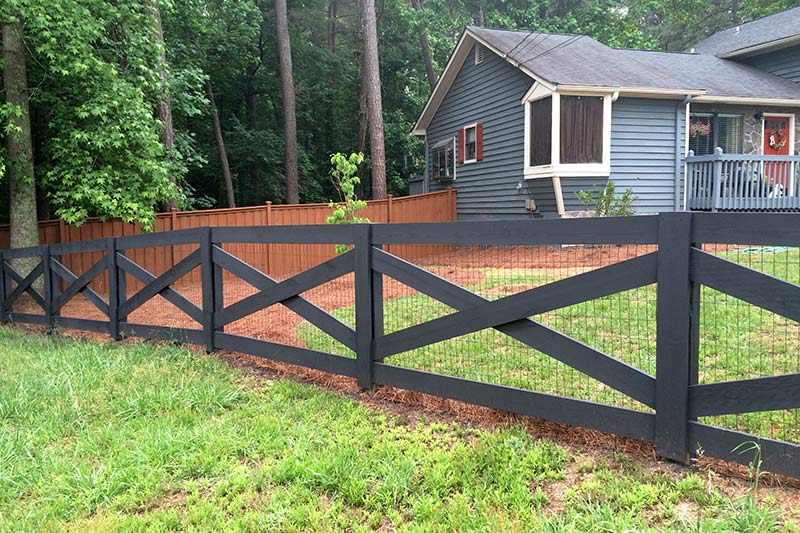
Ornamental iron fences
Ornamental iron fences, aka wrought iron fences, are increasing curb appeal and making your property more secure. Because of their elegant and high-security qualities, they are often used for both residential properties and governmental and commercial buildings. Like other types of fences, there are plenty of styles to choose from for your ornamental fence.
Styles of ornamental iron fences
Embassy iron fencing
An outstanding value for large projects. This style of ornamental iron fencing comes with a powder-coated finish to provide superior protection.

Diplomat ornamental iron fencing
This type will meet all of your fencing needs. This style comes with a flat top-rail with no protruding pickets. Also comes in a powder-coated finish for superior protection against elements.
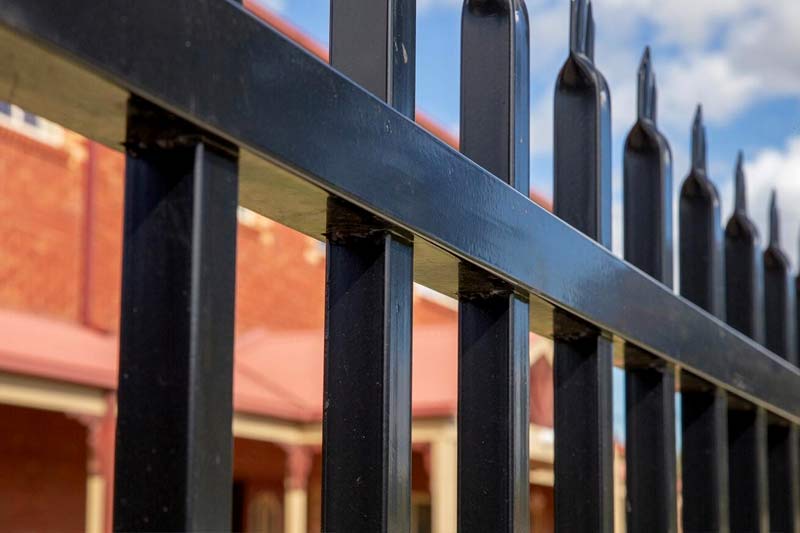
Sovereign
A popular and attractive choice for providing security. It features flat-top pickets that come with a plug-like cap or finals that can be added for a look of distinction. Sovereign is not a short fence.
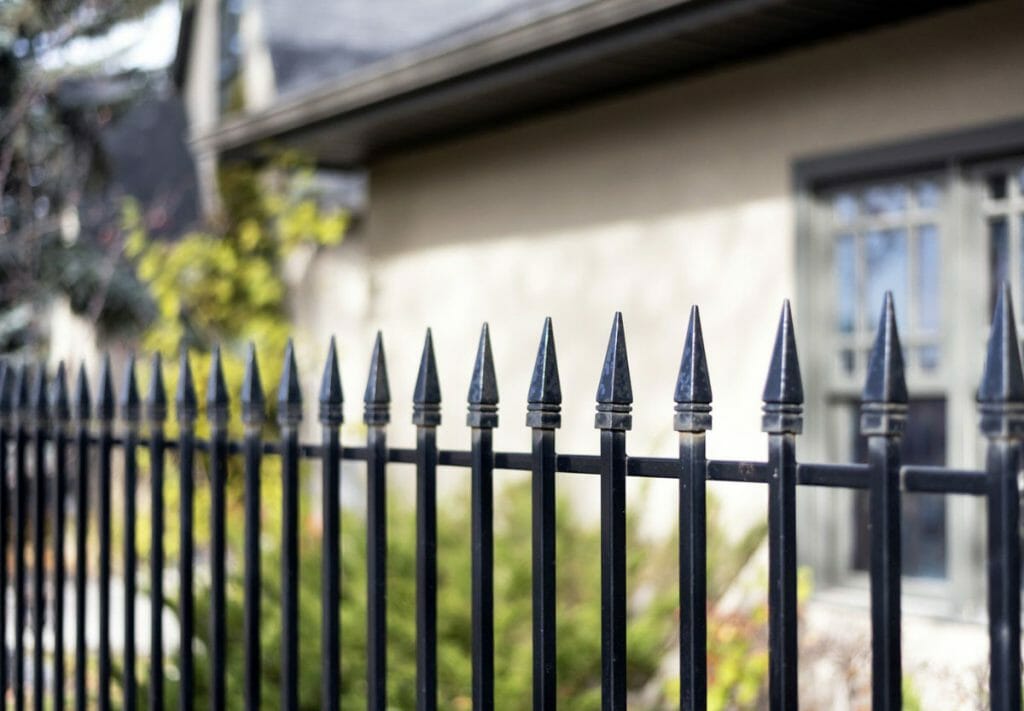
Regency
Regency is a simple but at the same time strong design fence, which is in line with most swimming pool enclosure codes. This style of iron fencing has no exposed picket on the top or at the bottom of the rail for added safety.
Regency-style gates can be equipped with a pool safety latch.
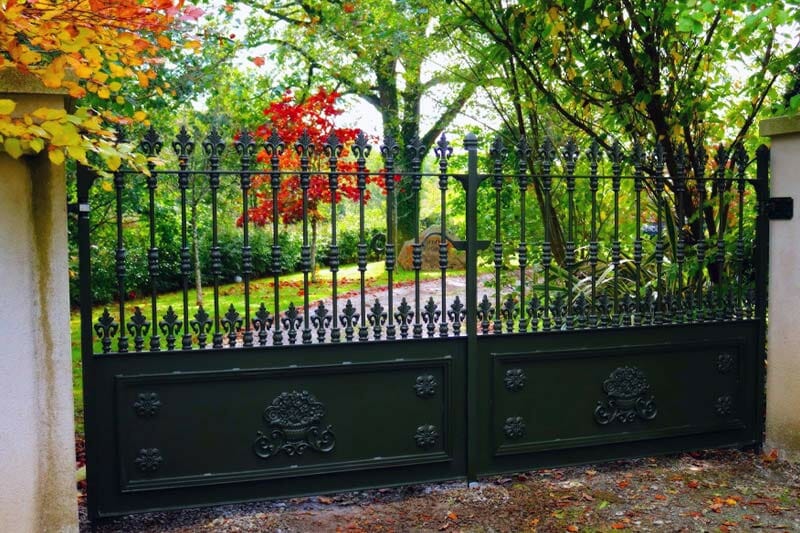
Monarch
The monarch fence is well suited for large-scale perimeter projects. Monarch iron fencing offers traditional protruding flat or pressed point pickets. However, the pickets heights alternate, adding visual interest and aesthetic appeal.

Aluminum fence
Aluminum residential fences are a very attractive and low-maintenance type of fence. The low-maintenance nature of aluminum fences is due to their naturally rust-resistant qualities.
This fence type provides a barrier and defines your property. It is easy to paint and decorate to make it look like any type of fence you want.
Styles of aluminum fences
Hancock Style
Each Hancock section comes with tree rails, consisting of a flat top rail and protruding pickets below the bottom rail.

Antietam Style
Antietam ornamental aluminum combines the safety of a smooth top-rail with the traditional look of alternating pressed point pickets below.
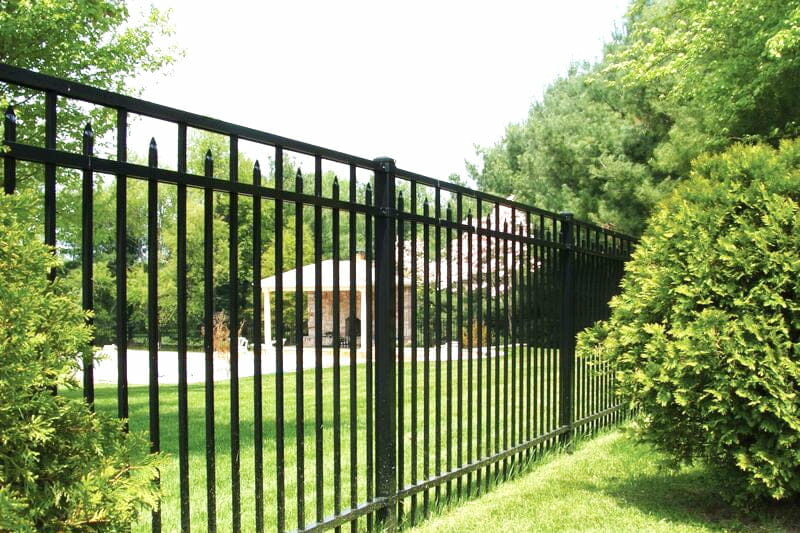
Fredericksburg
Fredericksburg ornamental aluminum was designed to meet strict pool enclosure codes that require a 45” spacing between horizontal rails.
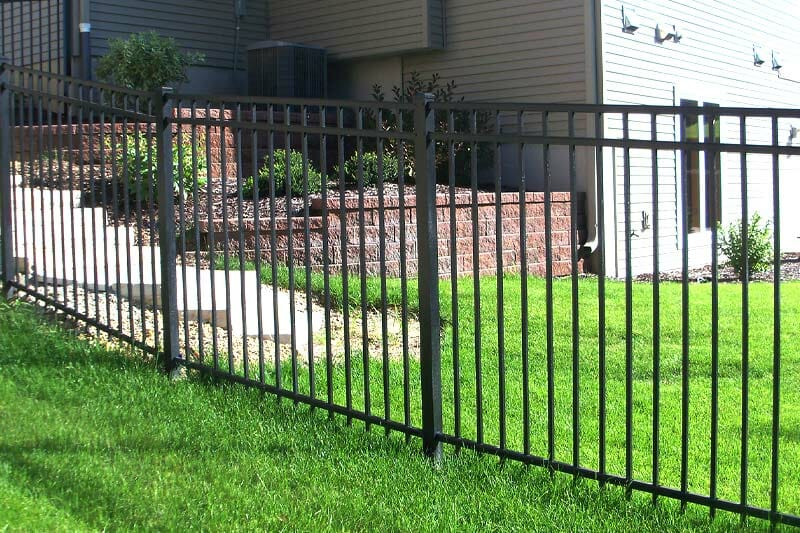
Charleston
Charleston ornamental aluminum style of fencing offers protruding flat-topped pickets that are capped with a black plug cap. Anyway, decorative finials can be added in place of the caps to create an ornate look that adds beauty and sophistication.
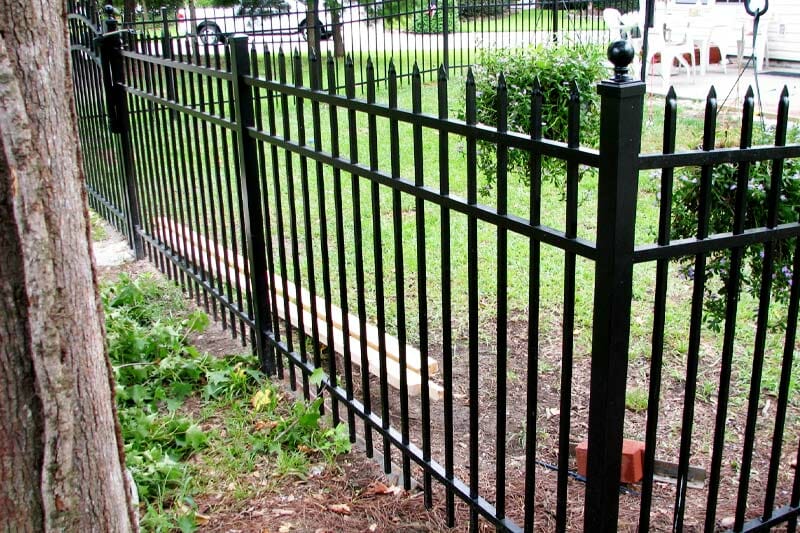
Chain-link fences
Chain link fencing is an affordable option for defining your property and keeping everyone safe within the boundary lines. Chain link fence as construction is safe from elements because of the aluminized and galvanized framework.
Chain link fences provide security because are hard to climb over while at the same time providing visibility for you to see any unwanted visitors. Animals and solicitors will be prevented from wandering through your property. A chain-link fence is one of the most budget-friendly choices for residential fencing.
Styles of chain-link fencing
Aluminized steel fabric
Aluminized steel fabric on galvanized steel framework is your best choice for strength and durability. Aluminized steel fence fabric is self-healing given it minimizes patina and is environmentally safe.
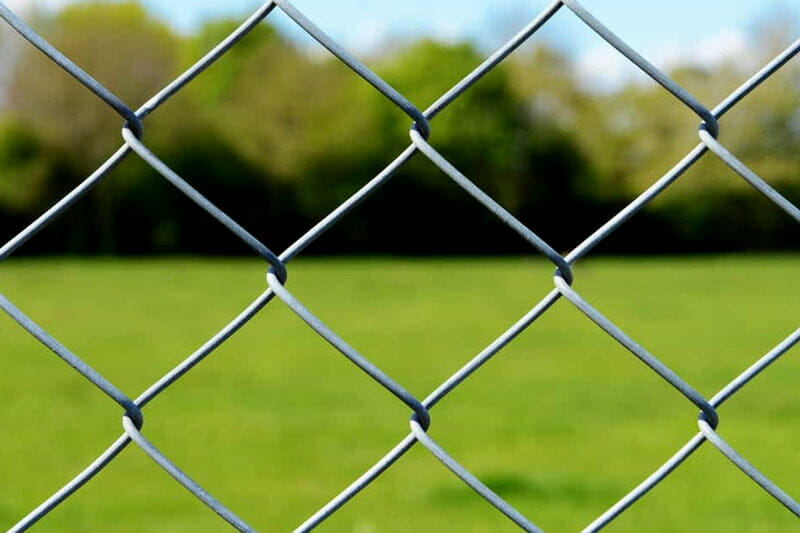
Polymer
Polymer coated fabric on galvanized steel framework is a lower cost option to having a durable fabric without the added expense of coated framework. Fabric is available in black, brown, or green. Closely matching colored PVC stats can be added for a degree of privacy.
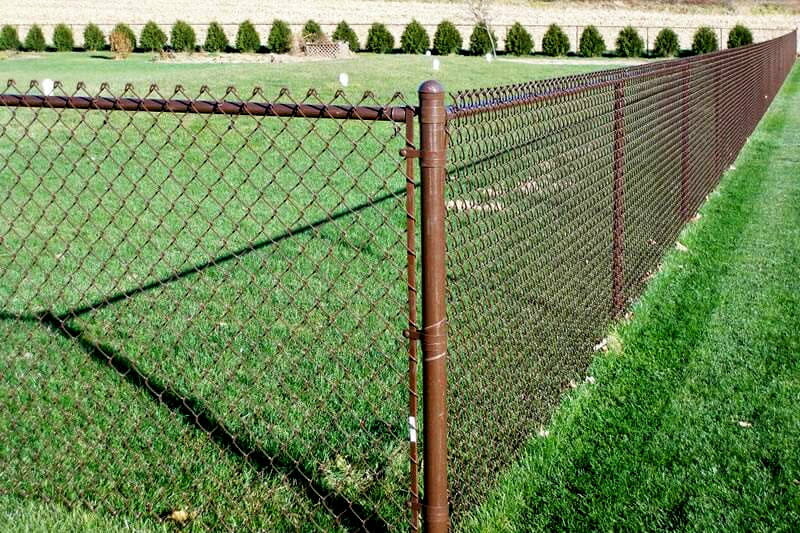
Privacy fences
Privacy fences aid in blocking out any unwanted sights, guests, and even sounds. If you live in a crowded area with a lot of traffic noise, lots of passers-by who want to peek into your property boundaries, a privacy fence will be the best option for your property.
Material of privacy fences
Often, privacy fences come as a wooden fence, vinyl/PVC fence, and chain-link fence with privacy slats added. Wood privacy fences deter outsiders, vinyl privacy fences offer an extended lifespan, and chain-link privacy fences are strong and durable.
Features for residential fences
If you want to improve or beautify your residential fence plenty of optional features are available.
Fence gates
One of the most popular options is a residential fence gate. Most of the residential fences have the option for vertical board gates that comes with a flat top, archtop, or dip cut so your taste can be satisfied.
A walkway or driveway gate is a popular type of fence gate that comes in a variety of widths suitable for pedestrians or any type of vehicle.
Garden and pool residential fence gates are also popular options for improving the residential fence curb appeal. Garden fence gates will keep any unwanted visitors or animals from accessing your property lines, while pool gates make it difficult for young children to enter the pool area and that way avoid accidents.
Benefits of residential fence
The following are some of the benefits of owning a fence:
- Child safety
- Pet control
- Property protection
- Architectural enhancement
- Define property boundaries
- Privacy
- Increase the resale value of the property
FAQ's
Definitely vinyl/PVC. The cheapest to create a fence for your home is by getting one from PVC. Such a fence is a great substitute for natural wood fencing and offers you protection from the outside world. PVC sleeves improve the stability of wooden posts used as a fence, reducing the cost of material and the labor used.
The most durable type of fencing is a masonry wall fence. This includes brick, concrete, stone, block, and even stucco. Longevity is the biggest advantage of this fence material. Can last over 100 years without any issues.
Prices depend on the type of fence materials used and the length and height of the fence. Follow this link, and you will find cost guides for all kinds of fencing projects.
In most cases, the householder who owns the fence is responsible for maintaining and repairing it. However, if any damage is caused to your fence by your neighbors, then it is their responsibility to pay for reparation.
Usually, repairing a fence costs less than replacing it entirely. Yet, under specific circumstances, the cost of mending a fence can exceed the expense of getting a new one.
The average fence repair cost is $560. This is a lot cheaper than a fence replacement which costs $2,250 on average. These prices normally vary depending on factors such as fencing material costs, labor costs and the type of problem being faced.
Typical repairs like frequent painting and resetting of fence posts are usually preferred by property owners as a short term solution. Entire fence replacement is however the cheapest long-term solution to fix a fence that has outlived its usefulness.
Average Fence Repair Cost
| Service | Quantity | Low | High |
|---|---|---|---|
| Fence Repair Costs | Per Linear Foot | $18 | $50 |
| Fence Repair Labor Cost | Per Hour | $50 | $200 |
| Cost to Repair a 200 linear foot fence | 200 feet | $3,600 | $1,0000 |
Average Cost to Replace a Fence
| Service | Quantity | Low | High |
|---|---|---|---|
| Fence Replacement | Per Linear Foot | $15 | $60 |
| Fence Replacement Labor Cost | Per Linear Foot | $5 | $20 |
| Fence Replacement Material Cost | Per Linear Foot | $10 | $35 |
Fence Replacement Vs Fence Repair Cost Estimates by Material
| Repair (per linear foot) | Replacement | |
|---|---|---|
| Wooden | $600 | $2,850 |
| Aluminum | $322 | $4,250 |
| Steel | $250 | $3,400 |
| Vinyl | $540 | $3,800 |
| Chainlink | $500 | $2,350 |
| Brick | $850 | $5,450 |
| Composite | $485 | $2,750 |
Wood Fence Repair Vs Replacement Cost
The national average wood fence repair cost is $600. Repairing wood fences normally involves repainting and re-staining any damaged fence posts, rails and fence panels. This is usually done to prevent any wood rot and pest damage.
You may however need to replace your wooden fence for an average cost of $31 per linear foot if it gets damaged beyond repair. This translates to a national average cost of $2,900. Labor costs for a new fence installation average $20 per linear foot while wood fence materials average $11 per linear foot.
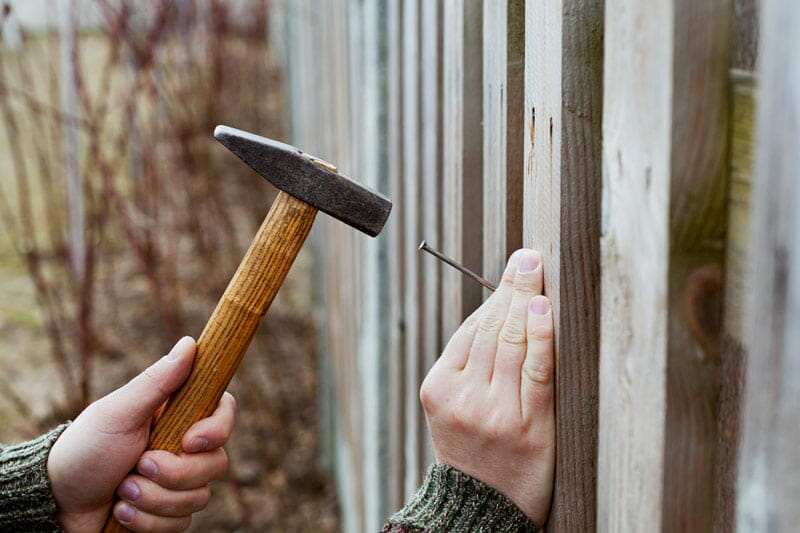
Aluminum Fence Repair Cost Vs Replacement Cost
The average aluminum fence repair cost is $30 per linear foot. Trusted fence contractors recommend replacing a damaged aluminum fence panel instead of welding in new parts into an old fence.
It therefore takes unfastening, detaching and replacing damaged fence panels to repair a fence made of aluminum. You may however need to replace your entire existing fence if it has outlived its usefulness. An average fence repair costs $54 per linear foot of aluminum.
This translates to a national average fence cost of $4,250 with the main cost considerations being labor and materials. Homeowners pay an average of $20 per linear foot for materials and $30 per linear foot for labor.
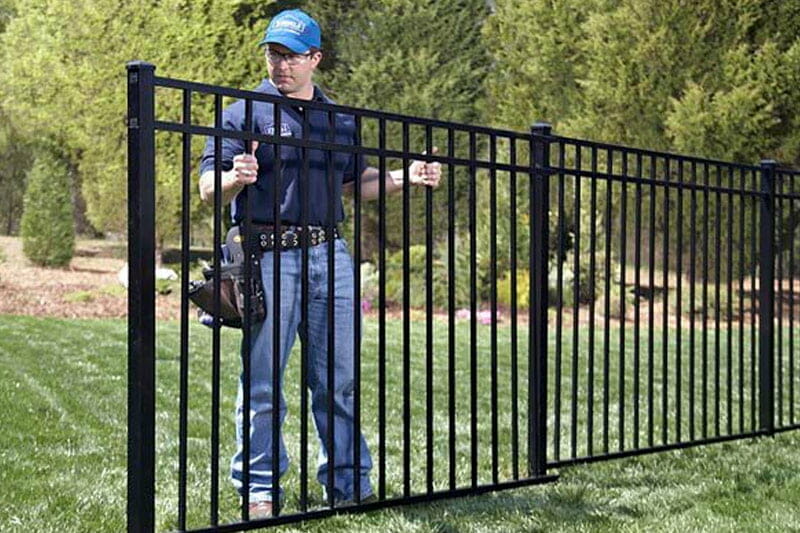
Steel Fence Repair Cost Vs Replacement Cost
Steel fence repairs cost an average of $30 per linear foot to complete. This translates to a total national average cost of $520. Property owners pay an average of $50 per hour for labor and $225 on average for each panel.
Replacing an entire steel metal fence will cost you $30 per section for Corten and Palisade fence types. Galvanized steel metal fences can however cost up to $350 per section. Expect to pay an average of $3,400 for a new steel fence.
Vinyl Fence Repair Cost Vs Replacement Cost
A 150-foot fence repair costs an average of $540 for vinyl fences. This is cheaper than repairing metal, brick and wooden fences. Expect to pay a professional fence contractor an average of $7 per linear foot or $40 per hour for labor in such a project.
You may, however, need to replace your current fence if it is damaged beyond repair. The actual project costs for installing a vinyl fence normally average $3,800 installed. Other cost factors for such a project include the size and design of your new fence.
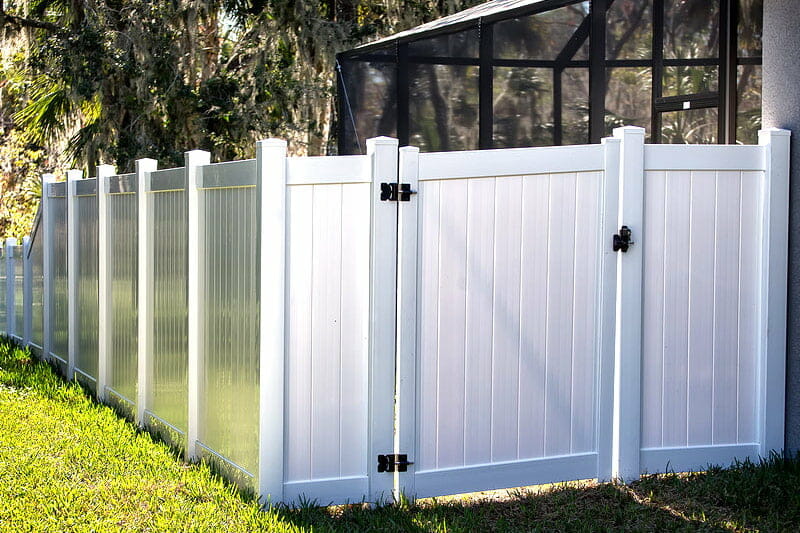
Chain Link Fence Repair Cost Vs Replacement Cost
Most chain link fence repairs cost an average of $500 to complete. This cost is inclusive of both labor and materials. The labor fence repair cost per foot normally averages at $15. The material costs often vary depending on the fence section being repaired.
Property owners pay an average of $2,350 to replace their chain link fences. Chain link fences are therefore more cost effective to install than most fencing alternatives. The main cost factors for chain link fence installation include height, size per square foot, labor and materials.
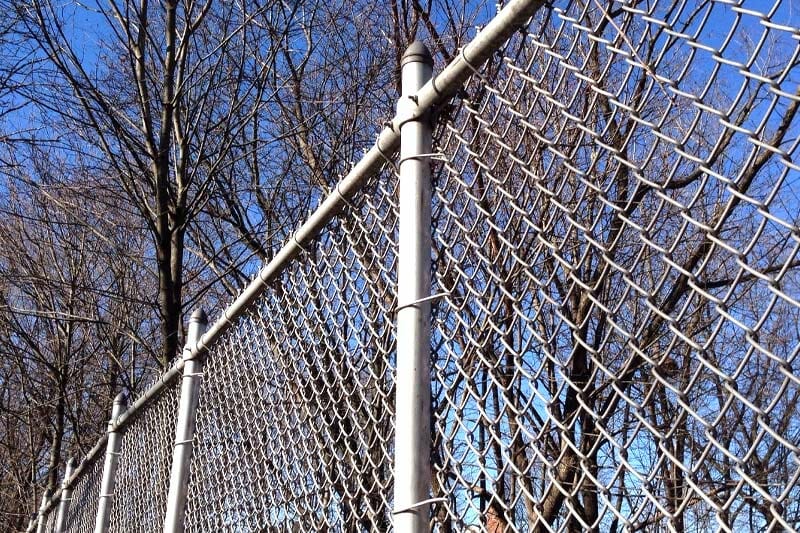
Brick Fence Repair Cost Vs Replacement Cost
Brick fences are one of the most expensive fencing alternatives to repair. This is because brick fences are quite labor and time intensive. Fence repair pros usually charge an average of $850 to repair brick fences.
Installing a new brick fence costs between $3,450 and $7,200 on average depending on whether the bricks are made of clay or concrete and the type of fence detail and finish you go for. Other cost factors for such a project include length, height, design and size of bricks.
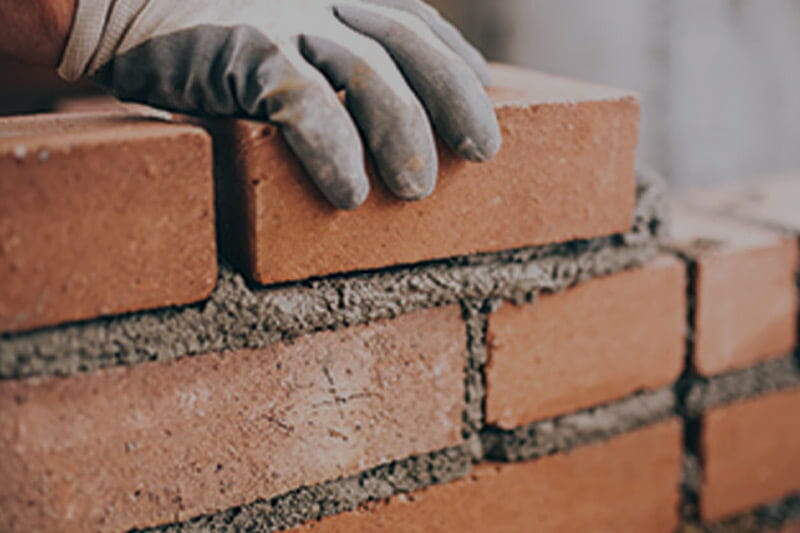
Composite Fence Repair Cost Vs Replacement Cost
The average cost to fix composite fences normally averages at $485 for both labor and materials. It often involves fixing every fence post affected by rot and pests. Any cracked or missing boards and all fallen fence sections are also repaired or replaced.
Installing a fence made of composite will cost you an average of $2,750. Although this is quite costly upfront, the durability and low maintenance nature of composite fences make them cheaper in the long term.
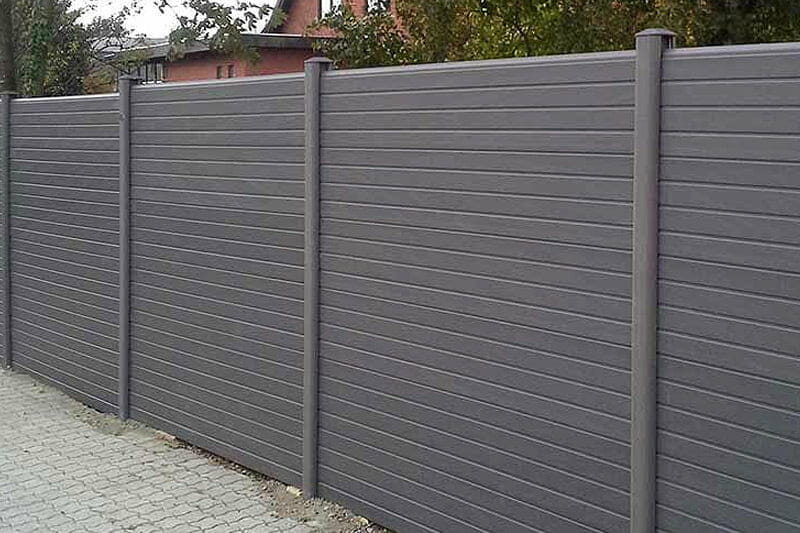
Fence Replacement Vs Fence Repair Cost Estimates by Type
Privacy Fence Repair Cost Vs Replacement Cost
A privacy fence repair costs an average of $825 to complete. Privacy fences are often the largest fences. A privacy fence can exist as a metal, brick, stone, wood or vinyl fence depending on the clients’ preference.
The fence material usually has a significant impact on the final cost. The large size of privacy fences also makes them extremely labor-intensive. This makes the labor cost to repair them rather high.
Expect to pay an average of $4375 to replace your privacy fence if it has been damaged beyond repair.
Picket Fence Repair Cost Vs Replacement Cost
The average cost of a picket fence repair is $300. Picket fences generally require simple repairs because they are made up of very little material and are therefore quite short. Picket fences are mostly constructed using wood and vinyl fencing materials.
They therefore require fence maintenance activities like staining and repainting to keep them from weather damage. Expect to pay an average replacement cost of $1900 if your picket fence’s structural integrity has been damaged beyond repair
Picket fence replacement costs normally vary depending on size, material, gate supports, style and labor.
Split Rail Fence Repair Cost Vs Replacement Cost
Split rail fences cost an average of $500 to repair. Rail fences are mostly used to cover large tracts of land. This is because they are wooden fences with simple fence posts, rails and support posts. They are therefore commonly used on ranches and fields to form animal enclosures.
Rail fences cost an average of $21 per linear foot to replace. A 100 linear foot wood rail fence will therefore cost you an average of $2100 to replace. Enclosing an entire acre will cost you an average of $17500 if you include a fence gate.
Temporary Fence Repair Cost Vs Replacement Cost
Expect to pay an average of $200 for a temporary fence repair. Wire mesh panels, plastic mesh panels and simple metal barricades are all examples of temporary fences. They are normally employed while activities like repairs and landscaping are taking place.
Replacing your temporary fence with a rented one will cost you an average of $90 per panel per month. Such fence costs normally vary depending on the length and height needed, the fence material and extra equipment like stakes and support posts.
Electric Fence Repair Cost Vs Replacement Cost
An electric fence repair costs an average of $275 to complete. Wiring issues are the most frequent problems with electric fences. They normally occur accidentally during activities like gardening and landscaping. Engaging an electric fence expert is usually recommended to resolve such a situation.
Replacing your electric fence will cost you an average of $1300. This cost is inclusive of the transmitter, receivers, wires, collar, charger, voltage meter and batteries. Expect to pay an average of $250 if you are replacing the transformer alone.
Lattice Fence Repair Cost Vs Replacement Cost
A lattice fence repair costs an average of $550 to complete. This is a more attractive fence that can be made of a variety of materials, including vinyl, wood, or metal. When water damage, rust, dents and breakage occurs in some lattice fence portions they must be restored with care to preserve the pattern and aesthetic.
Depending on the quality of material, a lattice fence replacement will cost you an average of $13 per linear foot to complete. High quality lattice wood and vinyl fences can cost you up to $24 per linear foot to replace.
Stockade Fence Repair Cost Vs Replacement Cost
A stockade fence repair costs an average of $525 to complete. A stockade fence is a wooden fence constructed using wood fence panels that are nailed together, side by side, with no gaps in between them. Despite providing good privacy, stockade fences are susceptible to wood rot and pest damage.
Replacing your stockade fence will cost you an average of $22 per linear foot. You are therefore likely to pay around $2200 for an entire fence replacement. This price is inclusive of materials and labor.
How Much Does It Cost to Repair or Replace a Leaning Fence?
The average leaning fence repair cost is $500. This cost can however vary depending on the fence material. A leaning wooden fence is therefore more expensive to repair than a leaning metal fence.
Leaning fences are usually a result of pest infestation, wood rot and improper installation. Replacing a leaning fence will cost you between $1000 and $2500 depending on whether it is a partial or full replacement.
A partial replacement involves replacing fallen fence sections, setting fence posts and stabilizing any moving ground. A full replacement involves completely removing your old leaning fence and putting up a new one in its place.
What is the Cost to Repair or Replace a Fence Post?
The average fence post repair cost is $325. A fence post may need a quick repair if it is wobbly or cracked. Loose fence posts are normally a result of improper installation and damage at the base. Cracked fence posts are mostly due to direct impact and weathering.
A fence post repair project generally involves resetting any loose posts by digging around them and reinforcing the base. Fence contractors can also repair cracked fence posts by patching or treating any splits with resin or mortar.
Expect to pay an average of $350 to replace a fence post. Fence posts that have been damaged beyond repair by storms, pests, rot and accidents certainly need to be replaced.
What is the Cost to Repair or Replace a Fence Gate?
Fence gate repairs cost an average of $325 to complete. The cost of such fence repair projects can however vary depending on size and material. A small wooden fence gate repair will therefore cost significantly less than a large wrought iron fence gate repair.
Homeowners pay an average of $525 to replace a fence gate. This price is however also dependent on size and fencing material. A simple wood gate will therefore be cheaper and faster to replace than a large fancy wrought iron gate
Fence Picket Repair Vs Replacement Cost
Fence pickets can be repaired for $200 on average. Picket damage is often a result of direct impact, accidents and weathering. Repairing a fence picket therefore involves fixing any splits, chips and holes caused by these processes.
Since, the picket material and difficulty to handle have an impact on the pricing, metal pickets are more expensive to repair than wooden pickets. Expect to pay an average of $250 to replace a fence picket.
Fence Panel Repair Vs Replacement Cost
Expect to pay an average of $225 to repair a fence panel. Strong winds and storms are known to cause fence panels to tumble down. A fence panel repair therefore involves relocating and fastening them back into place. Filling up and patching panels with holes, splits and cracks is also quite common.
Homeowners pay an average of $475 to replace a fence panel. This price normally varies depending on the size, fence material and type of the panel. It is considerably cheaper to replace a basic vinyl panel than a beautifully designed wrought iron panel. Fence panels are normally only replaced if they have been damaged beyond repair.
Pool Fence Repair Vs Replacement Cost
A pool fence repair project will cost you an average of $525 to complete. A pool fence is mostly a vinyl, aluminum or chain link fence. It is one of the cheapest fences to repair because it is not too large or sophisticated. Fading, cracks, and accidental dents are the most common problems with pool fences.
Expect to pay an average of $300 to replace your pool mesh. Pool meshes are mostly made of translucent vinyl materials that can allow light to pass through while also creating a barricade. They mostly get damaged or ripped when heavy or sharp objects fall on them. In such cases, a complete replacement is the way to go.
Deck Fence Repair Vs Replacement Cost
Most deck fence repairs cost an average of $600 to complete. This is equal to the national average wood fence repair cost because most deck fences are wooden. Aluminum and vinyl deck fences are however also available.
Deck fence repairs mostly involve dealing with structural damage on the rails. Such damage is often a result of wood rot, excessive moisture and accidental impact. If the rails have been damaged beyond repair, a full replacement is usually recommended.
Expect to pay an average of $925 to replace the rails of a 10-foot long deck fence. This price is however dependent on the fence material chosen. Glass is the most expensive material while composite and vinyl are quite cost effective. Labor will cost you $30 per linear foot or $70 per hour on average.
DIY Vs Professional Fence Repair and Replacement
With the right equipment and skills, you can perform minor fence repairs and even entire fence replacements on your own. You can clean, paint and stain your fence to save the money you would have used to hire a professional. You can also reset wobbly posts and replace any damaged or missing boards.
You should however seek professional advice and expertise if you are faced with a large fencing project that you are not effectively prepared for. This could save you a lot of effort and money in the long-term by guaranteeing that the fencing job at hand is done properly.
Home Garden Guides is a great tool that quickly matches you with the best fencing specialists in your locality. You can get three estimates from local fencing professionals in a matter of two minutes. Kindly follow the steps below to enjoy this great service:
- Scroll to the top of the page and enter your zip code
- Answer questions about your fencing job
- Your fencing details are forwarded to three local experts who will send you a price estimate for your job with some friendly advice.
Should I Replace or Repair a Fence?
A broken or damaged fence is never a pretty sight. Even the best and strongest fences will likely break down over time. When this happens, you’re left with two options; to repair or replace the fence.
To make this decision, you’ll have to consider several factors, including the extent of the damage, the age of the fence, the cost, and the fence material, among others.
In this post, we’ll dive deeper into these factors and the signs to look for to ensure you make the right decision.
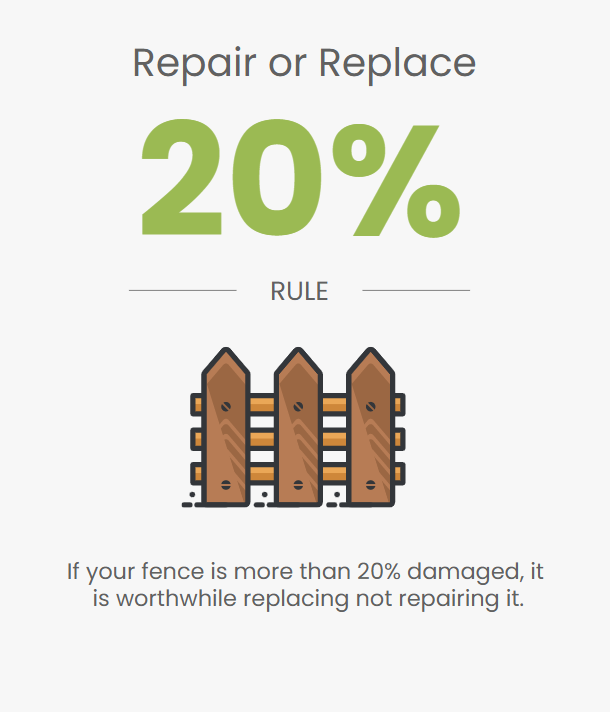
How to decide if it’s time to repair or replace your fence
As earlier mentioned, many factors play a role in determining whether it’s time to repair or replace your fence. However, many homeowners often narrow these factors to the cost and longevity.
Ask yourself these two questions:
- Does it make financial sense to replace the fence instead of repairing it?
- Will the repairs made be sustainable in the long term?
One of the most effective tools that can help you get these answers right is the famous 20% rule.
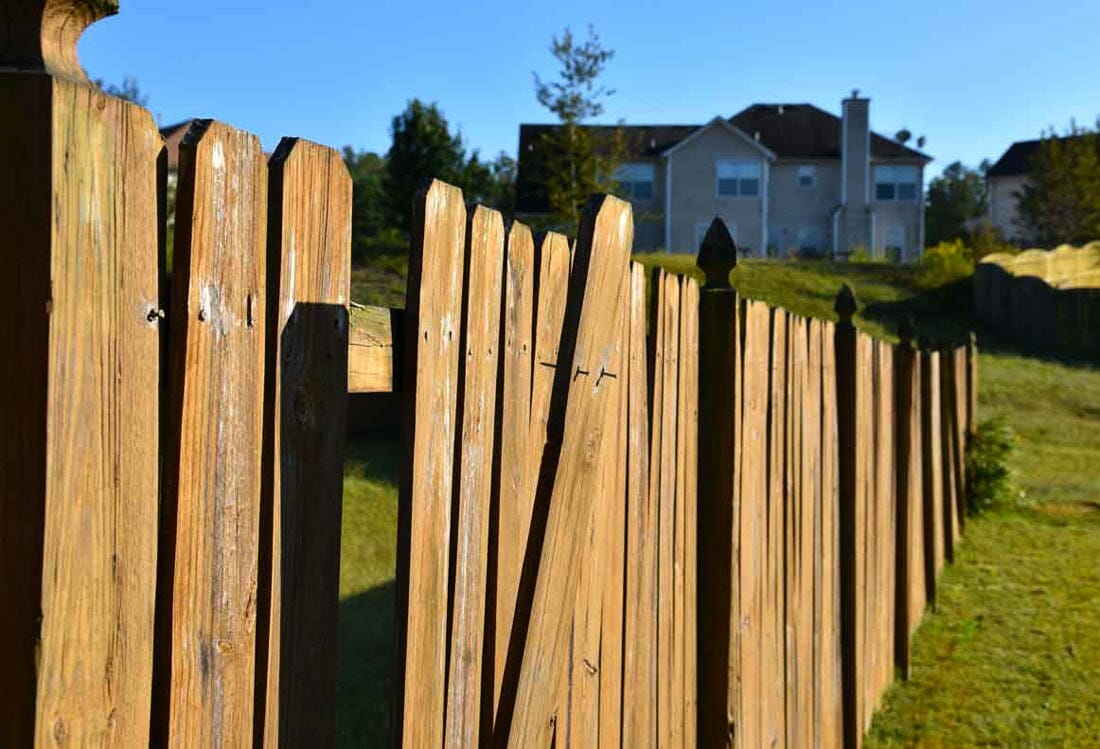
This rule states that if the repairs required on your fence exceed 20% of its size, then it’s time to think of a replacement. In other words, if you have to repair a quarter or more of the boards on your fence, replacing them is the better option.
The rule works because it gives homeowners a substantial metric by which they can measure the damages on their fence. It’s also viable since it helps you save a fortune in future repairs.
Keep in mind; The damaged 20% of your fence is only the visible beginning of your problems. There’s likely to be more serious invisible problems and damages in the remaining 80% of the fence.
By replacing it sooner, you’ll spend more on upfront costs but your new fence will last for decades with minimal need for repairs.
Exceptions to the 20% rule
Despite being a good rule that’s simple and easy to implement, there are exceptions to this rule that you should know, i.e.,
- If the repair cost is more than the cost to replace the fence, always opt for a replacement.
- If your fence is just too old, replacing it is always the right decision. There’s no point in fixing a dying fence.
- If the fence damages are more than 20%, but the cost to replace it is just too expensive, repairing it is the only option that makes sense.
Important: Despite all these exceptions, the best way to determine whether you should repair or replace your fence is by consulting and getting a free estimate from a fence contractor.
An expert can inspect your fence panels and several fence posts to assess the extent of your fence problems before making a final decision.
Signs it’s time to replace your fence
While the 20% rule is a practical way to look into the decision to replace your fence, there are other signs that could help you determine this.
| Problems | Fence affected |
|---|---|
| Storm damage /car accidents | All fences |
| Holes in the fence | Vinyl fencing Wood fencing |
| Leaning fence/fence posts / fallen panels | Vinyl fence Aluminum fence Wood fence Chain link fence |
| Rusting | Steel fencing Wrought iron fencing |
| Rotting | Wooden fencing |
| Missing boards/pickets | Wooden fence Vinyl fence |
| Property line/Local laws | Chain link fencing Vinyl fencing Wooden fencing |
Homeowners who can spot these signs early are able to avoid many unnecessary costs associated with further damage.
The signs include:
Heavy damage
Any damages caused by storms, tornadoes, falling trees, or even car crashes can be very costly to your fence.
In many cases, these accidents cause structural damage to the fence posts that hold your entire fence together.
While you can repair such damages, you’ll find that fixing up your fence posts is very expensive.
Natural disasters’ damage may also cause a shift in the soil structure, meaning more repairs will be required.
Holes in your wooden fence
Holes in your wood fence should be the first signs that you ought to get worried. If they’re just a few holes then some minor repairs are fine.
But once you notice a widespread distribution of the holes across the entire fence, then that calls for a replacement.
However, if the holes are caused by insects like termites or pests like mice, your first step should be exterminating wood-destroying insects.
Contact an exterminator to help you with this before applying any wood filler or wood putty.
Otherwise, your new fencing will just be torn apart like the old fence in a short while. Note that holes can also affect a vinyl fence.
Extreme rusting on steel and wrought iron fences
Rusting is a common problem among all metal fences except an aluminum fence.
If you’ve noticed excess corrosion on your steel or wrought iron fence, applying a fresh coat of paint is off the books.
If not handled quickly, rust can eat away all the metal causing your fence to fall apart. You’ll, therefore, need to replace the whole fence including the rails and posts.
The best way to prevent this problem is to schedule a maintenance service regularly.
Leaning fence
A leaning fence is never good news. It usually indicates that there’s an underlying problem that will eventually cause the fence to topple over.
In most cases, it’s usually caused by shifting soil during soil erosion or weak and unstable fence posts.
The worst thing about this problem is that by the time you notice the leaning fence, there’s little you can do in repairs.
It’s often a sure sign that your fence needs to be replaced.
You’re likely to find this problem in wood fences, vinyl fences, and in some instances, an aluminum fence.
Rotting wood fence
In areas that experience hot and wet climates, moisture tends to build up in wood fences resulting in rotting. This usually appears as stains of gray or yellow on your wood, with the presence of molds and fungi growth.
If not spotted early, the rot will eat your wood posts inside out, causing irreparable damage to the fence.
To avoid this, you can opt for more resistant fence materials such as treated lumber, vinyl fence, or aluminum fence.
Repairs are piling up
If you’ve noticed that you’re always repairing your fence, that’s a sign that it requires replacement. This is a common problem when you’re dealing with aging wood, vinyl, and aluminum fences.
If it’s not broken, some boards are missing, or there are cracks and holes.
Investing in these repairs instead of replacing the fence will cost you a fortune, and you’ll still have to replace the fence after it completely tears apart.
When should you repair your fence?
Generally, the only times you should repair your fence is when the damages are minimal. If money is to be involved, repairs should be cost-effective and easy to fix without disrupting the overall structure of your fence.
So, to know if your fence requires extensive repairs, first conduct an inspection of your entire fence to assess the state of the fence.
Some of the signs to look for include:
- For wood fences: Split boards, rails, small holes, insect damage, and fence panel damage
- For vinyl fences: Damaged boards and panels, warping, rotting, fading
- For Aluminum fences: Loose individual rail, bubbling paint
- For metal fences: Loose rail, rust
FAQ's
You may require a permit to repair a fence if the project you want to undertake is fairly large. Large scale fence repairs involve replacing huge fence portions and digging deep to replace or reinforce shaky posts. Contact your local homeowner’s organization or building inspector’s office for further information.
Warranties are usually included in many fence installations. Such warranties cover all workmanship errors and may even pay for any necessary repairs and replacements. Clients are therefore advised to double-check their warranty policies to see if they can save some money on repairs.
Yes, it does. Most homeowner’s insurance policies cater for additional structures within and around your house such as fences. Any fence damage caused by storms or fallen tree branches can therefore be covered.
In certain states, the cost to repair a fence is shared by the homeowners on either side of the fence. You should therefore find out if this rule applies in your area before starting to repair a fence.
If it does apply, ensure you negotiate the repair costs and come to an agreement with your neighbors before commencing on any repairs.
Expect to pay an additional $150 to repair a fence in an emergency situation. Such situations include when animals are exposed as a result of fallen panels or damaged electric fence wires. Most repair firms and contractors provide this service on the same day it is requested.
It costs an average of $725 to repair back and front yard fences. This fence cost can however vary depending on the material chosen. A simple vinyl or chain link fence is therefore cheaper to repair than a large detailed metal fence.
No, they are not. A vinyl fence costs an average of $550 to repair and about $30 per linear foot to replace. This is much more expensive than barbed wire, electric and chain link fences which cost between $1.5 and $25 per square foot to put up.
Staining your fence will cost you $2000 on average. Fence staining is usually done to prevent moisture damage and to freshen the visual appeal of a fence.
If you live in a location where high winds are common, you may want to invest in a sturdy windproof fence. Expect to pay an additional $17.5 per linear foot on average for such a fence. You can also pay $350 to reinforce your existing fence and make it more wind resistant.
One acre is approximately 836 linear feet around the perimeter. How much you will pay to fence an acre of land depends on the type of fence you install
It costs $3,340 to $15,000 to fence an acre of land, depending on the land’s material, shape, and location.
You can choose fencing materials based on how you use your land. Agricultural and residential land use different types of fence materials, which would cause the fencing cost to vary.
| Fence type | Cost per linear foot | Cost per acre |
|---|---|---|
| Split Rail | $15 | $12,000 |
| Barbed wire | $4 | $3340 |
| Wood | $12 | $10,020 |
| Chain link | $7 | $5845 |
| Vinyl | $15 | $12,525 |
| Aluminum | $30 | $25,000 |
| Wrought Iron | $35 | $29,000 |
| Board on Board | $18 | $15,000 |
Cost To Fence An Acre by type
Split Rail
Depending on the material you use, a split rail fence is a classy and attractive fence. A split rail fence is open and is suitable for agricultural land. It is made with logs placed on each other with spaces in between.
Install a split rail fence costs $12 to $17 per linear foot. To install a split rail fence on an acre of land will cost $10,000 to $15,000.
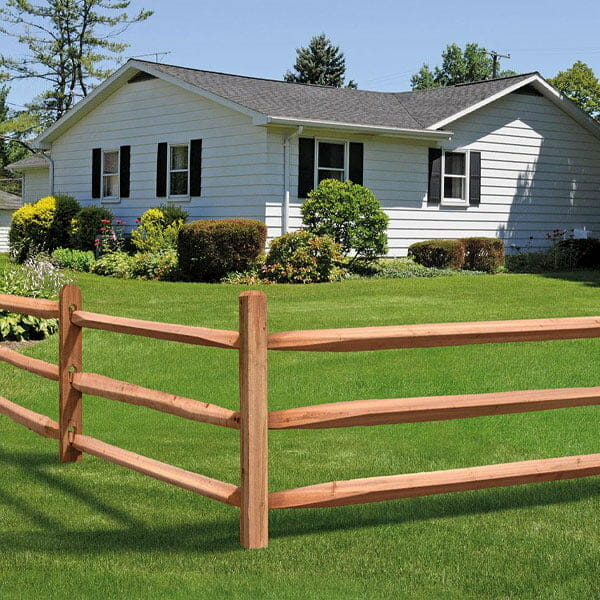
Wooden Fence
Install a wooden fence costs $12 to $30 per linear foot. How much you pay for a wooden fence depends on the wood you choose. Pine is the cheapest wood material you can use to make a fence. Cedar and redwood are moderately priced, while hardwoods are expensive fencing materials.
Fencing an acre of land with a wooden fence would cost from $10,000 to $25,000. The cost of the wooden fence may rise with the height of your fence. The higher your wooden fence, the more you will pay to install it.

Chain Link
A chain-link fence is also an affordable fencing option. How much you pay for a chain-link fence depends on the height of the fence and the quality of the chain link wire. Chain link fences are available in 4, 6, and 8-foot fences. Higher gauge chain link fences are more expensive than lower gauge fences.
It will cost you $5 to $15 to install a chain-link fence. It will cost you $12,000 to $21,000. Depending on your needs, you don’t need to pay the higher amounts of chain link fencing. Hire a professional to properly install a chain link fence for you.
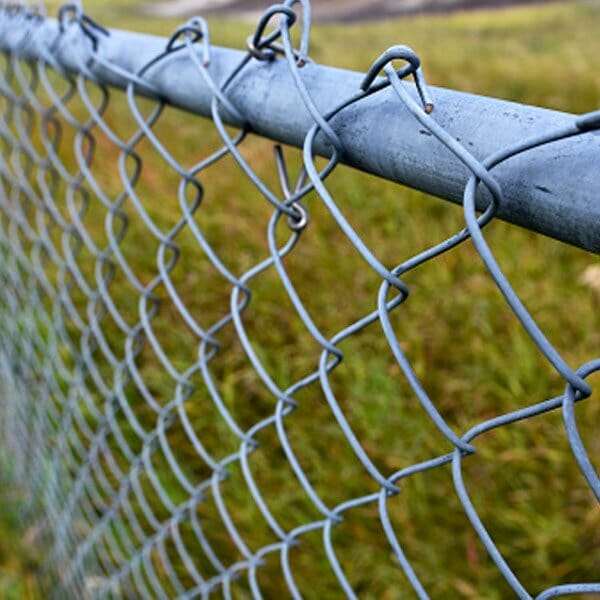
Vinyl Fence
A vinyl fence costs $15 to $30 per linear foot. A vinyl fence is strong and versatile. It is long-lasting and requires little to no maintenance. It is also available in many styles, colors, and designs from the manufacturer.
It will cost you $12,000 to $24,000 to fence an acre of land with a vinyl fence. The cost of vinyl fences varies on the height and design of the fence. A high vinyl privacy fence is more expensive to install than a short one. The design of the vinyl fence also determines how much you will pay for your fence.
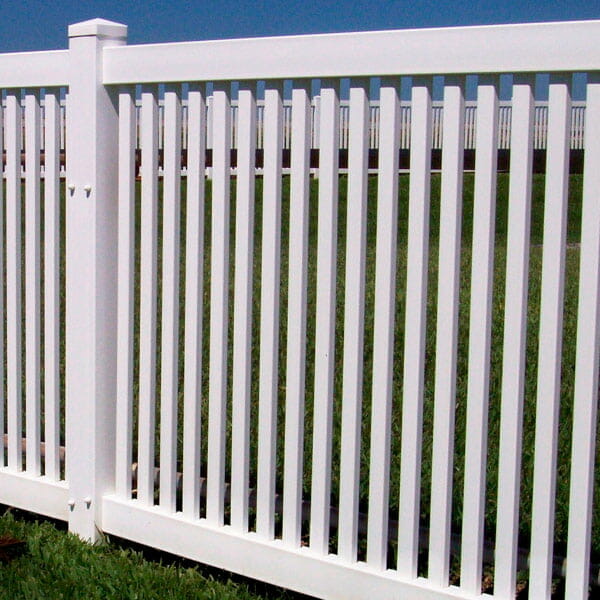
Aluminum
Aluminum is a popular fencing material. It is strong, doesn’t rust, and could last up to 100 years, depending on the quality. The height and quality of the aluminum fence determine how much you will pay to install an aluminum fence.
An aluminum fence costs $25 – $50 per linear foot, depending on the height and the aluminum fence’s quality. You can expect to pay $20,000 to $40,000 to fence an acre of land with aluminum fencing.

Wrought Iron
A wrought iron fence is strong and sturdy. It is attractive and lasts many years. It also doesn’t rot.
A wrought iron fence costs $24 to $44 per linear foot. Installing a wrought iron fence on an acre of land will cost you $20,000 to $37,000.

Composite & Trex
Composite and Trex fencing costs $23 to $37 per linear foot. Fencing an acre of land will cost you $20,000 to $30,000.
Composite and Trex fencing is long-lasting and can serve you for over 20 years. It looks like wood but doesn’t need painting or staining. It is available in different colors and styles. It is also easy to install, and you can install it yourself. You can do this to save on your installation costs.
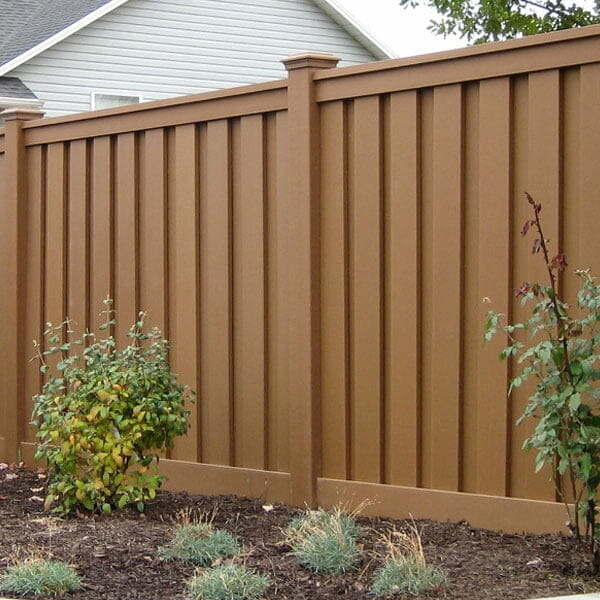
Board On Board Fence
A board-on-board fence is a strong and attractive fence. It costs $16 to $22 to install. If you want to fence an acre of land with the board-to-board fence will cost $14,000 to $18,300.
Although it is a strong fence, it doesn’t provide as much privacy since you can see through the overlap rails on the fence.

Barbed Wire
Barbed wire is the cheapest fencing material you can buy. It is suitable for fencing agricultural and rural land. It easily keeps animals from straying away from your land and provides you with a clear view of your land.
Barbed wire costs $1.5 to $2.5 per linear foot. Labor installation costs $2.5. You can expect to pay from $3,300 to $4,200 to fence an acre of land with barbed wire.
If you are handy enough and have the time, you can install the barbed wire fence yourself. It is a lot of work since you need to dig the posts all around your acre of land then fix the barbed wire to the posts.
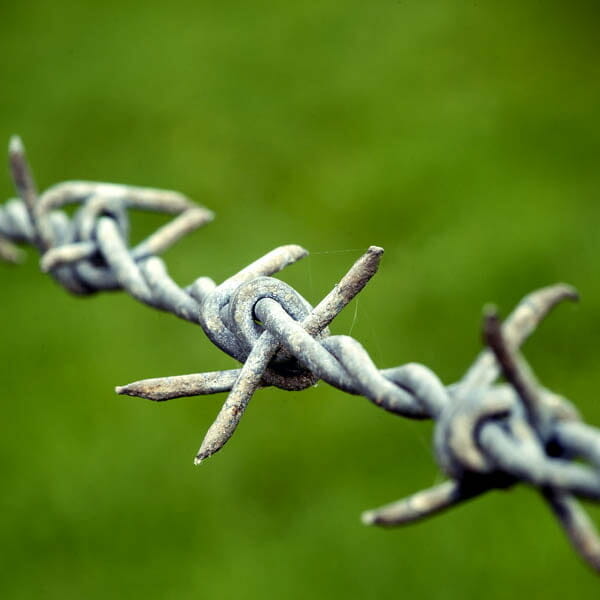
Hiring A Fence Installation Company
Installing a fence is a tasking job. If you want to install a fence, you are better off hiring a fence installation company than doing it yourself.
It is difficult to hire the right fence installation company. Use the homegardenguides.com tool to hire the right professional for the job.
At the top, enter your zip code then fill the subsequent form. On the form, enter the details of the fencing project.
You will then receive three quotes from three professionals. You can then pick one of them to install the fence for you.
FAQ’s
How Can I Make My Fencing Project More Affordable
If you want to make your fencing project more affordable, match it to your house. If your house is modest, install a modest fence. Don’t choose fence materials that are not similar to your house.
When buying fence materials, check out more than one supplier. You can compare the prices offered by each of the suppliers and buy from the cheapest. You don’t have to buy all the fencing materials from one supplier, you can buy each item from the cheapest seller.
Additionally, having a professional install the fence for you helps to lower the cost of the project. With their professional contacts, they can purchase materials at a lower cost than you. Thus, reducing your fencing cost significantly.
What Factors Do You Consider When Choosing A Professional Fencing Company
The first thing you need to consider is your budget. How much do you want to spend on your fencing project? Let your contractor know how much you have to spend. They will then advise you on the best materials to use for the fence and how much they will charge you.
You also need to consider the experience of the contractor. Can they manage a project like yours? If the contractor can show you evidence of handling a similar project to perfection, choose them.
Also, consider the reputation of the contractor. Check the contractor’s website and read reviews from other customers. If the customers have a favorable view of the contractor, hire them.
Do I Need A Permit To Fence My Land
Depending on where you live, you may or may not need a permit to fence your land. Check with the local authorities in your area on whether you need a permit to fence your land. Pay the required fees before you start installing the fence.
When you hire a professional, they will advise you on whether you need a permit in your region to install a fence.
How Do I Know How Much I Need For My Fencing Project
The easiest way to find out how much fencing materials and money you need for your fencing project is to hire a professional installer. They will help you measure your yard and provide the exact cost and materials needed for fencing it.
You can also use apps found on fence contractor websites. Enter the approximate size of your yard onto the app. Enter other details such as gates required and the expected height of the fence. When you have filled in all the details, the app will provide you with a detailed cost list of the materials and costs to install a fence in your yard.
Fences provide privacy to your home. Fences also enhance the security of your home by blocking intruders and animals. In ranch land, fences prevent animals from straying into other ranches.
At home, fences block noise in the street from reaching your house. Depending on the fencing material used, it will make your home more attractive and increase the value of your property.
A half-acre plot is about 420 linear feet around the perimeter. Most urban homes are built on ¼ or ⅛ acre plots. Fencing a half-acre plot will be more expensive than fencing around your home.
Depending on your chosen fence materials, you will pay $1 to $40 per linear foot. On average, you will pay about $6,000 to fence ½ an acre. Barbed wire is the cheapest fence material for large pieces of land.
Whether you hire a pro or install the fence, DIY will also influence how much you pay.
| Material | Cost Per Linear Foot | Cost Per Half-Acre |
|---|---|---|
| Vinyl | $10 | $4,200 |
| Chain link | $15 | $6,300 |
| Barbed wire | $3 | $1,200 |
| Split Rail | $20 | $8,400 |
| Wood | $30 | $12,000 |
| Corrugated Metal | $30 | $12,000 |
| High Tensile Wire | $3 per strand | $ 2,000 |
Materials To Use For ½ Acre Plot
Vinyl
Vinyl fencing is a suitable and affordable option for a half-acre plot. Installing a vinyl fence costs $10 to $40 per linear foot, depending on the style and quality of the fencing material. You can expect to pay $5,000 to install a vinyl fence on average.
Vinyl fencing is strong and sturdy. It is easy to install, and you can fix it independently if you have the right tools and skills. It is durable and requires little to no maintenance over its lifetime. Its cost-effectiveness saves you money, and you don’t have to worry about your fence once it is installed.
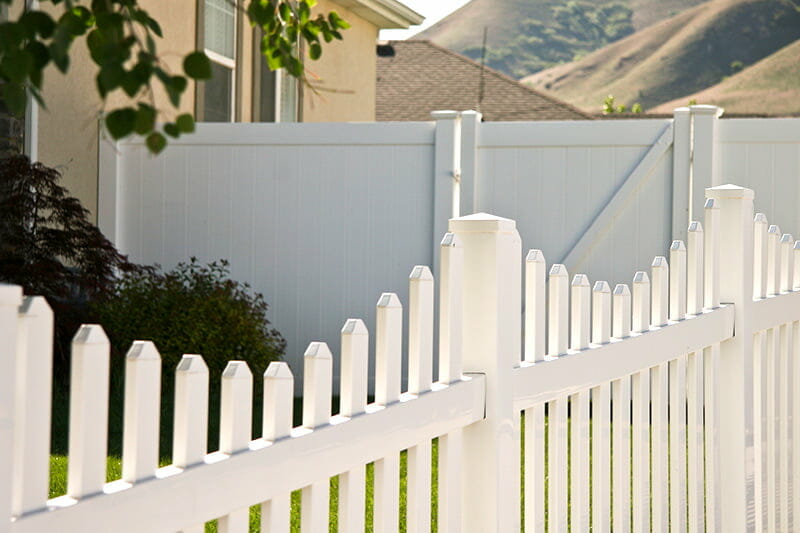
Chain Link
Chain link fencing is affordable for a half-acre plot. For materials, chain link fence costs $5 to $10 per linear foot. How much you spend on chain link fence materials depends on the strength of the wire. You will pay more for a higher gauge and stronger chain link fence. Installation costs $10 to $20 per linear foot.
You can expect to pay $6,300 to fence a half-acre plot with a chain link. Chain link fencing is strong and durable. It requires little to no maintenance; all you need is the posts and the chain-link wire.
However, it provides little privacy, as you can see through the gaps in the wire.
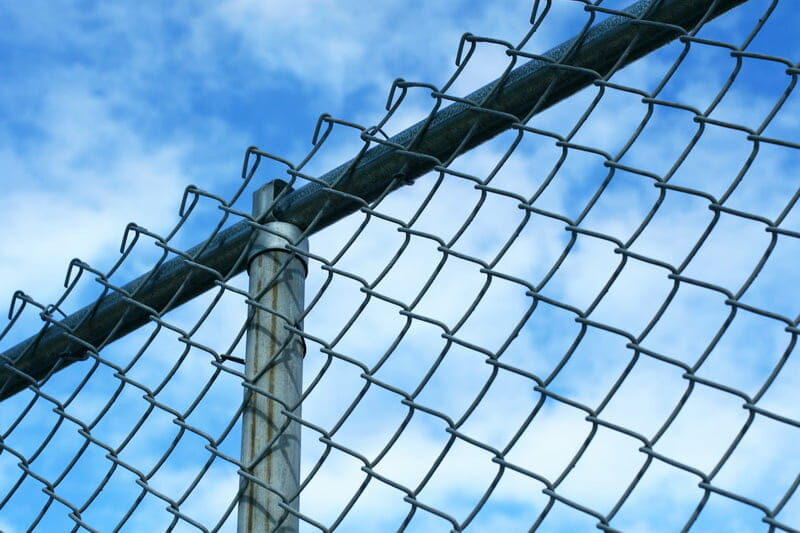
Barbed Wire
Barbed is the most affordable fencing option available. Considering the size of a half-acre plot, barbed wire is a suitable fencing material.
Materials and installation costs for a barbed wire fence cost $3. You can expect to pay $1,200 to fence a half-acre plot with barbed wire.
It is a suitable farm-land fence. It helps to mark boundaries and to keep your animals from straying. It is a poor privacy fence, as you can see through it easily.
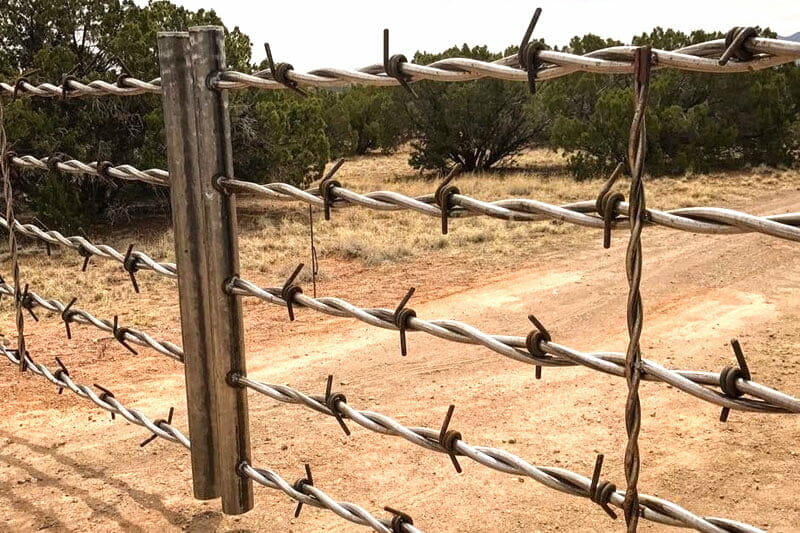
Split Rail
A split rail fence is also a suitable option for a half-acre plot. A split rail fence will cost you $11 to $20 per linear foot, depending on your fencing material. You can use wood or pre-assembled vinyl posts.
You can expect to pay up to $8,400 to fence a half-acre plot with a split rail fence. It is easy to install and long-lasting.
If you choose a wood split rail fence, you must maintain it regularly. Proper maintenance for a wood fence requires regular Inspection for rot and decay, painting or staining, and fixing any broken parts.
Materials such as vinyl need little maintenance.
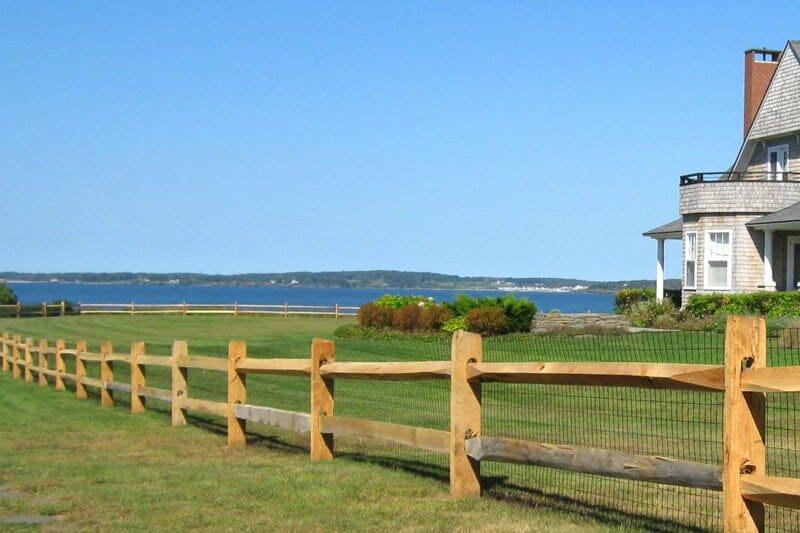
Wood Fence
Wood fences cost $18 to $40 per linear foot for materials and installation. How much you pay for a wood fence depends on the type of wood you choose. Pine is the cheapest wood fence, while cedar and redwood fences cost much more.
You can expect to pay an average price of $12,000 to install a wood fence on a half-acre plot.
Wood fences need proper care and looking after. When buying a pine fence, make sure it is chemically treated. The treatment makes the wood change color. It also makes it resistant to pests, rots, and decay.
Redwood doesn’t need to be treated as it is already pest resistant and has a natural red hue that makes the fence attractive.
However, you must keep your wood fences from touching the ground to prevent rot and decay. Maintain and take care of your wood fences to prolong their lifespan.
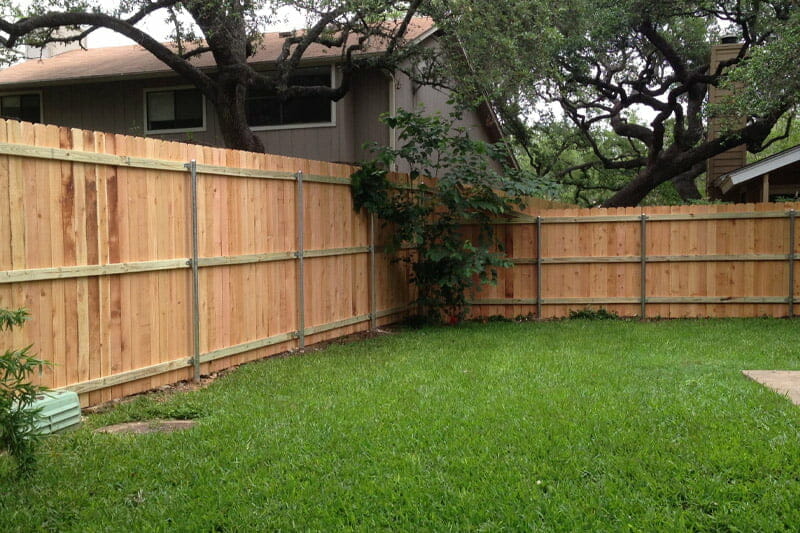
Corrugated Metal Fence
A corrugated metal fence is an option for your half-acre plot. It is strong and sturdy, provides privacy, and is long-lasting. Corrugated metal fences come in panels of different materials such as aluminum or other metals, measuring 6 or 8 feet each for easy installation.
Corrugated metal fences cost $17 to $90 for materials and installation. It will cost you about $12,000 to fence a half-acre plot with corrugated metal. How much you pay depends on the type of corrugated metal panels you choose and the size of the panels you buy.
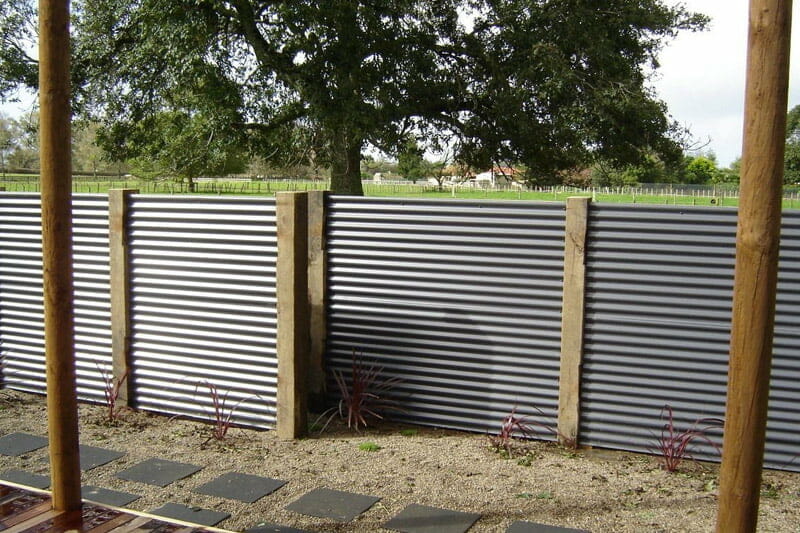
High Tensile Wire
The high tensile non-electric wire consists of 8 strands of 12.5 gauge wire and posts. It is a suitable and affordable fence for a half-acre plot. High tensile wire fences cost $0.07 to $1 per foot for materials and installation. Fencing a half-acre plot with non-electric high tensile wire will cost you about $2,000 to $3,300.
A high tensile wire fence is strong and durable. It is a low-cost and low-maintenance fence.
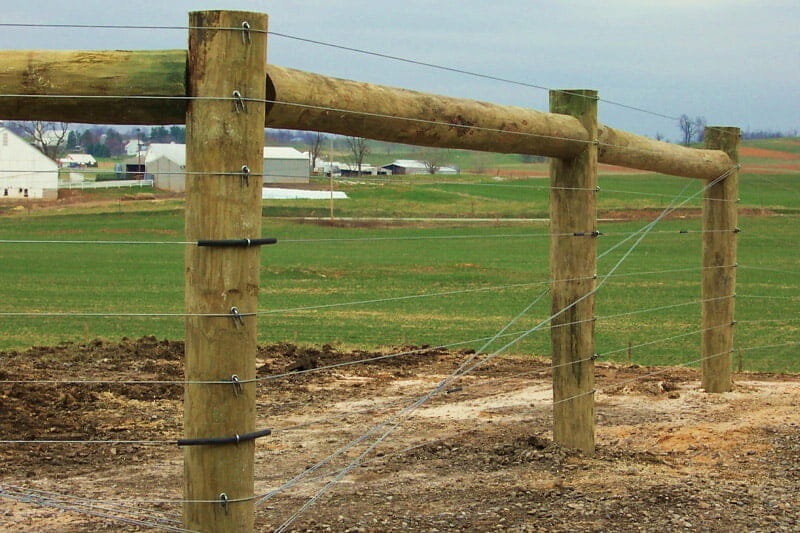
Use This Free Service
Go to homegardenguides.com. At the top of the page, enter your location zip code.
After that, fill in the form that follows. You will provide more details on the fencing project at hand. For instance, you will provide the size of the land, the slope, and how it is used. Then submit the filled form.
Afterward, you will receive quotes and advice from three professional fence installers. Compare the prices offered and pick one that will work within your budget.
Depending on the materials you choose, fencing is an easy DIY project. It will save you the cost of installation after you have purchased materials.
However, using a pro is much better. How much they charge you includes the tools you may have to buy or hire if you DIY. Being professionals, they will do a much better job than you can.

FAQ’s
A fence is an essential part of any plot of land that you own. You must fence your plot to identify the boundaries easily. If you don’t fence your land, it can be easily encroached on by your neighbors and others.
A fence also provides privacy. Depending on the materials you use, a fence can easily block outsiders from viewing whatever is going on in your land. Also, you cannot see beyond the fence.
If you have agricultural land with animals on it, a fence is essential. It ensures that your animals don’t leave your land. Keeping your animals from your neighbor’s land keeps your animals safe and protects your neighbor’s land from destruction.
Some fence materials make attractive fences. Attractive fences increase the value of your land.
How Do I Decide On The Type Of Fence To Install On My Half-Acre
There are many types of fences you can install on your land. The type of fence you install depends on several factors. The size of your land is a major factor in the type of fence you will install. The larger your land is, the more expensive it is to fence it.
The other factor to consider when fencing land is the cost of fencing materials. The cost of fencing materials ranges from highly affordable to expensive. Buy fencing materials depending on your budget.
How you use your land is another factor to consider when installing a fence. If you are fencing around your home, you will use different types of fence materials from when you are fencing around agricultural land.
Do I Need A Permit To Install A Fence
Depending on where you live, you need to find out from your local authorities whether you need a permit to install a fence. You can visit the local authority office or hire a pro fence installer to advise you.
Where you need a permit, you will have to pay for it. Find out how much you will pay for the permit and add the cost to your fence installation cost.
Depending on where you live, you will pay about $20 to $60 for a fencing permit.
How Can I Save Money On Fencing
Fencing is an expensive endeavor. However, you can save a significant amount on your fencing project. To save money on your fencing, hire a pro. Pro fence installers have relationships with materials distributors. Buying from your installer can help you save on your installation costs.
Consider the size and use of your property. It will help you to choose the right type of fence. The right fence is cost-effective. Install a fence that requires little to no maintenance. A high-maintenance fence will cost you more over its lifetime.
If you are looking to save on the cost of installing a fence, gather as many price quotes as you can. Talk to more than three pro installers to find out how much they would charge you. Then, pick one who is likely to carry out a high-quality job at a lower cost than the others.
Putting up a fence offers privacy, security, and visual improvement to your front or backyard. Additionally, it can boost your home’s appeal and increase the value of your property.
The cost to fence a 1/4 acre lot ranges from $400 for the lowest end price to up to $20,000 for the most expensive composite or vinyl option.
Depending on the material used and the difficulty of access and construction, the overall cost of the project will vary.
Fencing Cost per Acre
Fencing projects usually range from $1,000 to $38,000 per acre, depending on the material used and the difficulty of access and construction. As long as you purchase your materials through a professional, the more length you buy, the lower the price per foot will be. Many manufacturers provide savings on higher volumes of orders to pros in the industry. If you are ordering on your own, you may miss such discounts, and for larger projects, those discounts can equal thousands in savings.
From Cheaper to The Most Expensive Options by Acre
There are many options for your fencing. Depending on the material price can vary from cheaper to most expensive.
| Acres | Cheaper (Wire or Electric) | Moderate (Composite or Vinyl) | Expensive (Wood or Metal) |
|---|---|---|---|
| 1/4 Acre | $400 - $2,500 | $4,200 - $8,500 | $10,500 - $20,000 |
| 1/2 Acre | $600 - 3,500 | $6,000 - $12,000 | $15,000 - $27,000 |
| 1 Acre | $1,000 - $5,000 | $8,000 - $17,000 | $21,000 - $38,000 |
| 2 Acre | $1,200 - $7,000 | $12,000 - $23,500 | $30,000 - $53,000 |
| 5 Acre | $2,000 - $11,000 | $19,000 - $37,500 | $47,000 - $84,000 |
| 10 Acre | $2,500 - $16,000 | $26,500 - $52,800 | $66,000 - $120,000 |
| 20 Acre | $4,000 - $22,000 | $38,000 - $75,000 | $95,000 - $170,000 |
| 25 Acre | $4,200 - $25,000 | $42,000 - $84,000 | $105,000 - $190-000 |
| 40 Acre | $5,500 - $32,000 | $53,000 - $106,000 | $132,000 - $240,000 |
How to Estimate How Much Material do You Need for Fencing 1/4 Acre of Land
Normally, you want to know how much it is to fence your property. An acre is a measurement of area, whereas when you are figuring fence materials, you typically are dealing with finding the perimeter or distance around a property. There is a formula that can help you calculate:
- One acre = 43,560 square feet
- 1/4 acre = 0.25 x 43,560 square feet = 10,890 square feet
- To find the length of one side, you need the square root (√) of 10,890, which equals 104 linear feet of the perimeter.
This formula makes estimating the total cost of the fence needed for your property easy. For example, if a 4’ high residential chain link fence costs $4.5 per linear foot, you will need roughly $1,872 in materials.
Use this FREE service
HomeGardenGuides.com is a free service that quickly matches you with top-voted local Fence Specialists.
You can get 3 estimates fast by certified experts in your area in just 2 minutes.
- Scroll to the top of the page and enter your Zip code.
- Answer questions about your fencing job
- Your fencing project details are forwarded to three local experts. They will send you a price estimate for the job and some friendly advice.
IMPORTANT: There is no obligation to hire. This is a free tool and service to be used at your pleasure.

Cheap Ideas to Fence a ¼ acre lot
Treated Pine
Pinewood panels that are chemically or pressure-treated to resist rot and pests will cost you from $12 to $19 per linear foot installed. This is a far less expensive option than cedar or redwood. If you have the possibility, always handpick fence panels from the lumberyard to ensure that they aren’t green or damp because if they are, the wood will easily move out of place once in the ground.
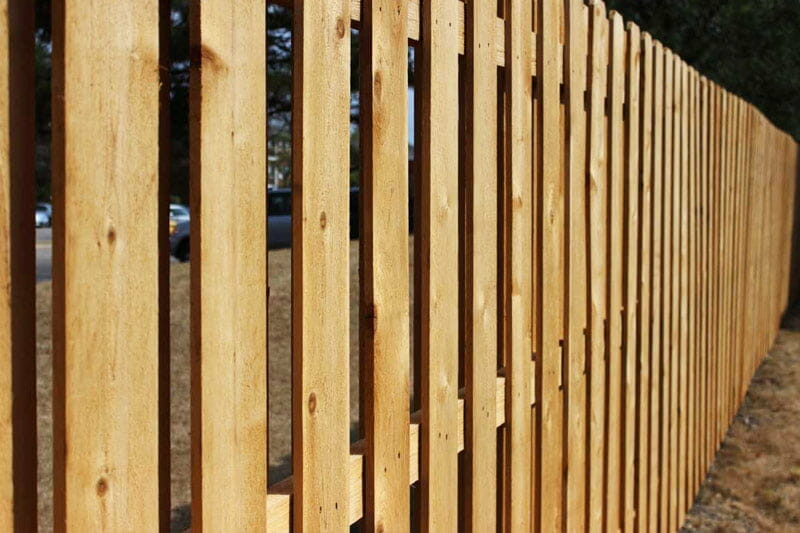
Chain Link
If you are dealing with a small budget and a large yard, go with the chain link. With the price of $10 to $20 per linear foot installed, it is a budget-friendly material. A chain-link fence does not provide privacy like a solid fence, but you can easily make it private, and also you can improve the appearance by painting it with oil-based exterior paint.
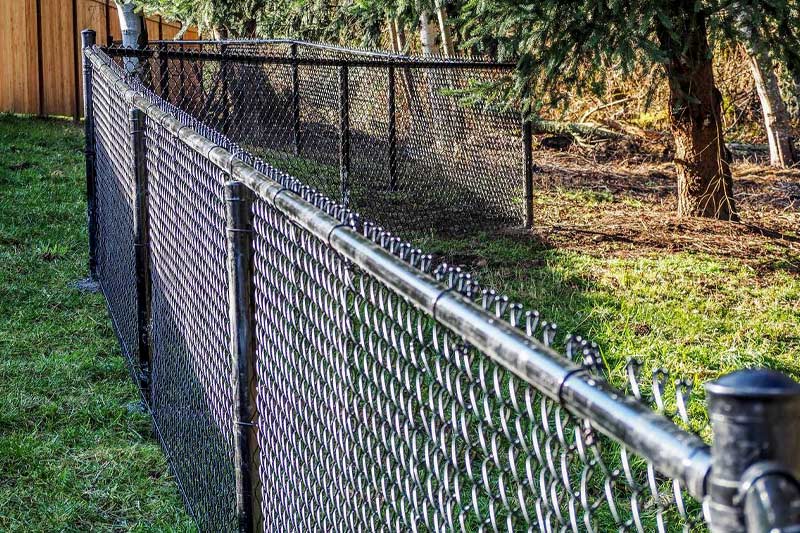
Barbed Wire
This low-cost option is hard to beat when reining in livestock or keeping out of your property predators like wolves and coyotes. Barbed wire costs range from $1.50 to $2.00 per linear foot.
Three to five strands of barbed wire are stretched horizontally between metal posts around the property line, with wood or metal posts installed at corners to hold the wire up. You must know that barbed wire fences are only permitted in rural areas.
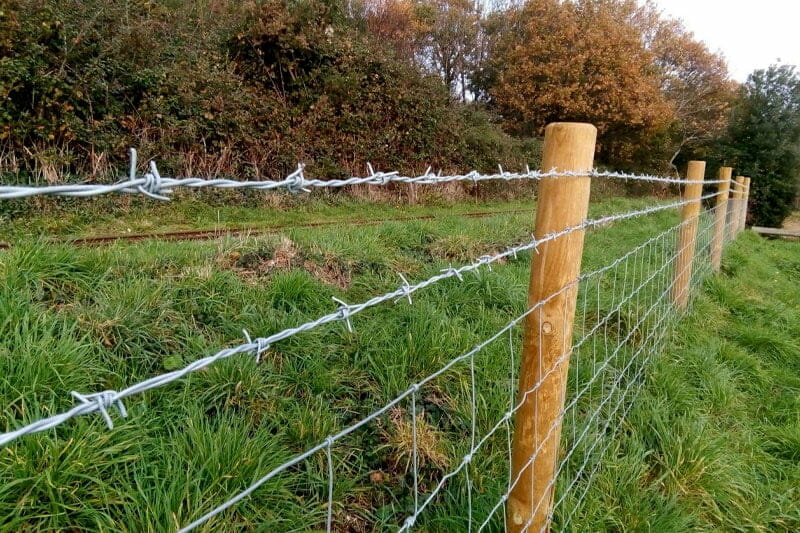
Pallets
This option will provide you wooden fence for free. You can DIY from pallets that you can pick up free of charge at nurseries, construction sites, and other venues.
Pallets can be installed either vertically or horizontally between vertical pallet posts, either with or without space in between. Handle them with care because pallets can contain splinters and nails if the pallets have an IPPC logo, that means that they were heat-treated or fumigated to prevent the spread of insects or plant diseases.

Split Rail
Split rail is traditionally used on farms and ranches to corral animals or mark property boundaries, the split-rail fence has leaped the ranch and Southwestern-style homes and beyond. Split rail fence costs vary from $10 to $20 per linear.
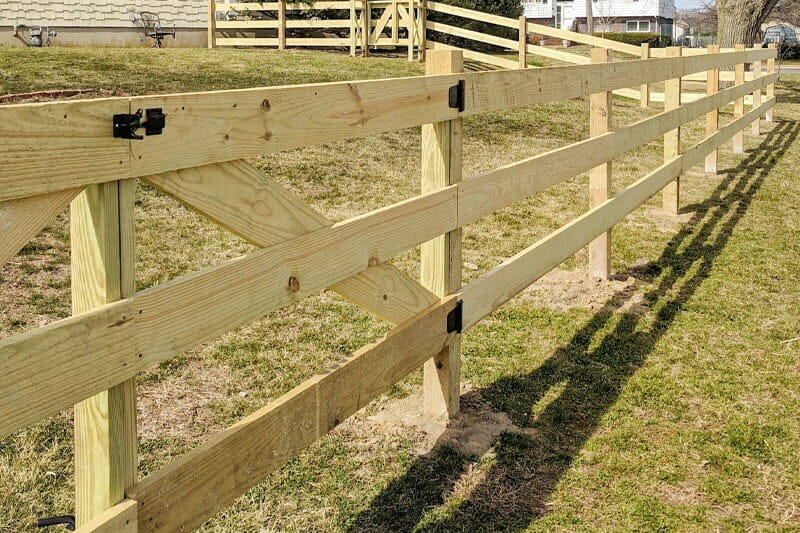
Timber logs, usually cedar or chestnut, are split lengthwise into “rails” and then stacked horizontally between short or tall vertically oriented posts. This fencing uses less material than solid varieties and so costs considerably less because there are eight to ten inches of space between individual rails.
Wrought Iron
Thin, vertically oriented balusters made of a rot-and-warp-resistant low-carbon iron alloy are placed inches apart between taller, thicker vertical iron posts. A wrought iron fence will cost you $24 to $34 per linear foot. Plain black iron posts start at the lower end of the price range, while zinc-coated ones are more expensive.

FAQ's
- Make accurate measurements before you order products or before you call professionals for quotes;
- Don’t go overboard on style and elegance if it doesn’t answer your actual needs;
- If you’re looking at a high-end product, like redwood or cedar for wooden fencing, consider lower-end options that perform similarly, like treated pine;
- Let your professional order materials in order to make the most of expert-only rates.
- Consider lower-priced gates. The gate and fence material doesn’t need to match to look good.
Electric fences are the cheapest for residential yards but only serve a limited purpose. Wire styles, like barbed and chain link, are also very affordable.
A fence itself does not add as much value to the home when compared to material and construction costs. It will enhance the value of the home only if there is a true need for such an outdoor structure.
If the property is 100’ wide, the depth would be 217.8’ and if the property is right-angled, you would need around 636 linear feet of fencing. A half-acre is 21,780 sq. ft. so just divide that by the property width and you will find out the depth.
Choosing the ideal fence for your front yard does not have to be overwhelming. All you need to do is determine your preferred style, materials, budget, and desired level of privacy. Once you have these factors decided, you can easily select the perfect option from a range of choices.
Do you want to fence your front yard but don’t know the best alternative that enhances the privacy of your home? Below are 12 front yard privacy fence ideas, including split rail fencing, wooden privacy fencing, chain link fencing, picket fencing, and more. We discuss why each would be a great option and how much you can expect to spend.
Vinyl Fencing
As one of the longest-lasting fencing options, vinyl fencing provides you value for your money. There’s a lot to love about vinyl fencing, especially in your front yard. This includes vinyl’s natural appearance that resembles wood fencing, minimal maintenance needs, and a relatively simple installation process.
The cost to install a vinyl fence is $3,800 on average. This is depending on location, project size, and finish options.
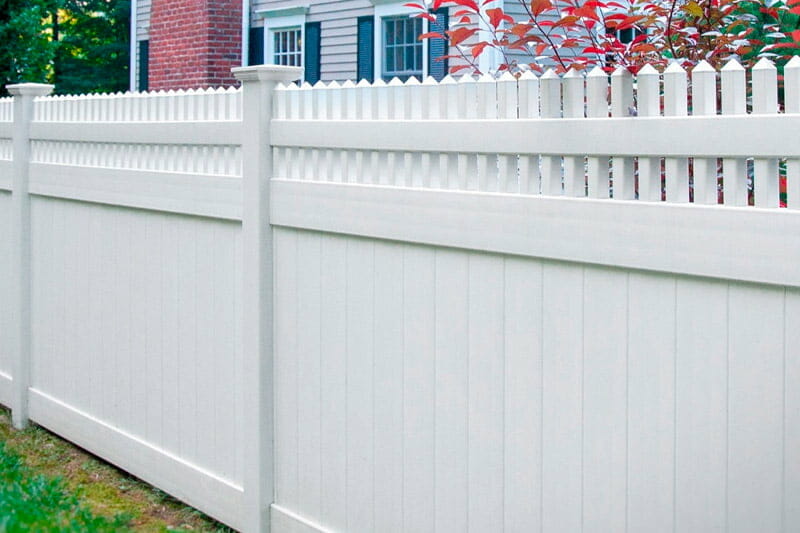
Aluminum Privacy Fence
Aluminum is a lightweight metal that’s malleable and easy to install in the front yard. Aluminum fences come in limitless designs and colors, allowing you to match the barrier to your home’s theme and style.
The fences offer adequate security to keep intruders at bay and are more durable than wire and wood fences. Unfortunately, you will have to dig deeper into your pockets to install an aluminum fence. The low-end cost of installation is $2,500 whole the high-end cost is $12,500.
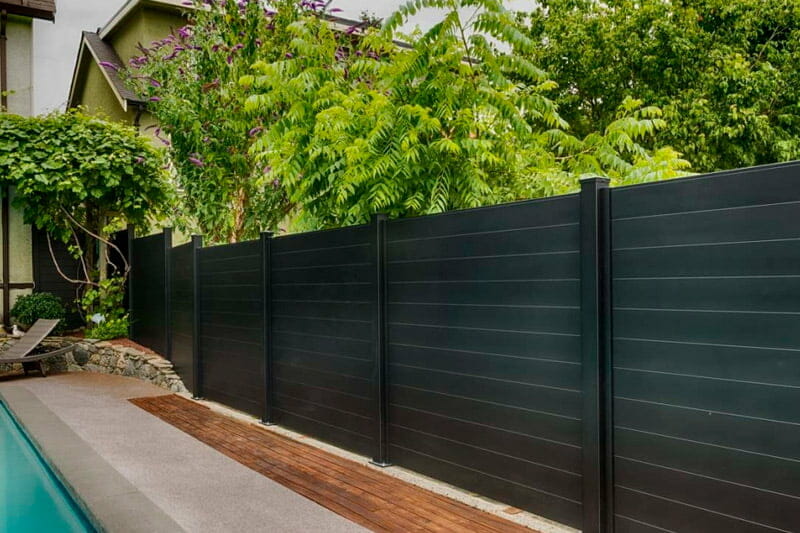
Bamboo Fence
You are lucky if you live in warmer climates because you can easily grow a bamboo fence along your property line. Don’t fret if the climate in your area of residence does not allow you to plant bamboo trees, as you can go with dried bamboo fencing that’s available in rolls or panels.
Bamboo is very beautiful, and you can mix it with other materials, like brick or concrete, to create a unique modern look. Installing a bamboo fence is ranges between $12 and $23 per linear foot, which is cheaper than vinyl and picket fencing.
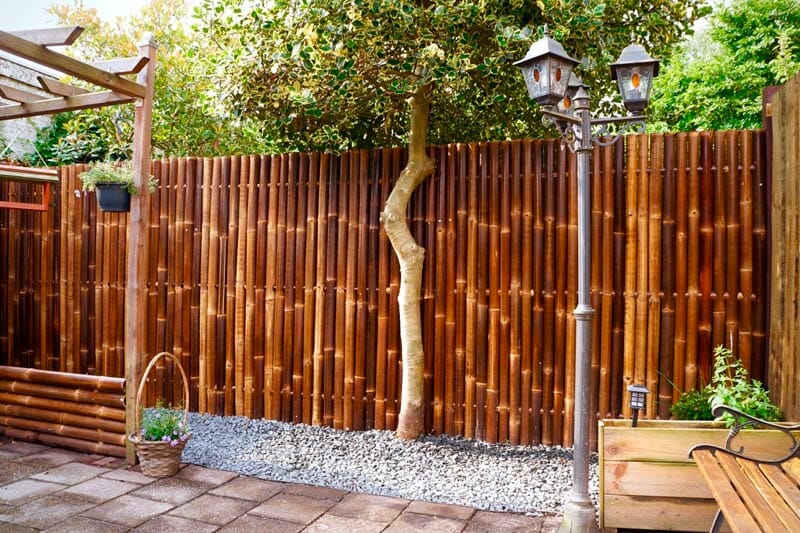
Chain-link Fencing
Chain-link front yard fencing is an inexpensive option that lacks the appeal and privacy offered by most other alternatives. However, they are a good option if you want a strong, durable, and long-lasting fence. You can also add privacy to your chain-link fences using privacy screens and slats.
The national average cost for installing chain-link fencing is between $1,200 and $3,500. This price is not inclusive of labor costs which range between $25 and $50 per hour.
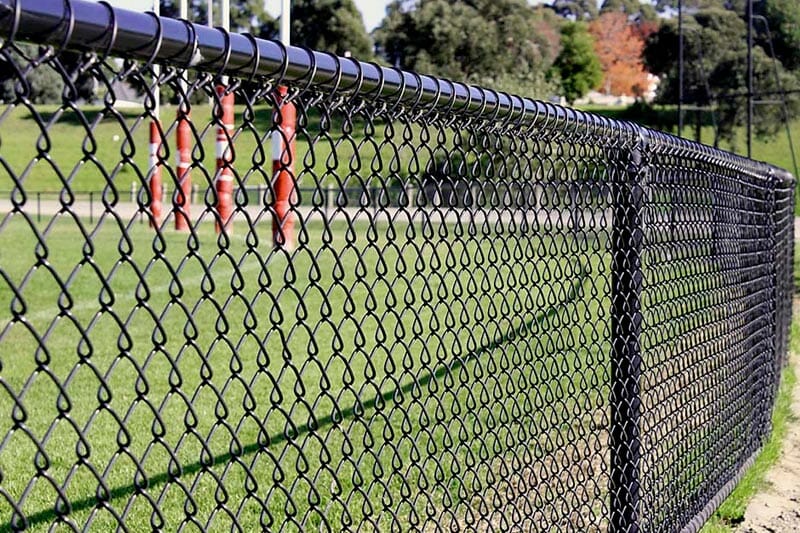
Lattice Fence
It offers privacy to a yard through the crisscrossed slats of wood. The lattices leave diamond-like spaces, allowing sunlight and wind to pass through. They are plant-friendly and come in various designs, styles, and sizes to pick the perfect fit for your yard.
You can stack them up to get to your desired height. Cheap plastic lattices cost $4.50 to $8.50 per linear foot; cheap wood lattices fence cost $7.00 to $9.50 per linear foot, and quality wood lattices $8.70 to $20.
Split Rail Fencing
The rustic and natural appearance of split rail fences makes them a classic front yard fencing option. Split rail fences come in all manner of shapes and sizes. The best for your front yard depends on your preferences and budget.
Cedar split rail fencing is a popular choice because it is affordable, eco-friendly, requires minimum maintenance, and can withstand harsh weather conditions. It will cost you roughly $12 to $20 per linear foot.
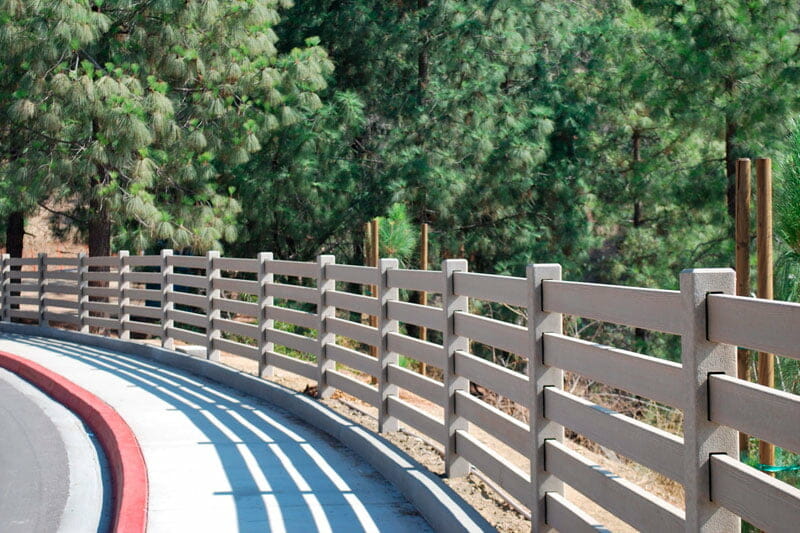
Steel fencing
Steel is an alloy of iron and carbon, making it one of the strongest fencing materials. It can also be combined with other materials, such as tungsten, for added durability.
The average cost of installing steel as a privacy fence is $7-$10 per foot. Including posts and gates may make the cost of installation go up.
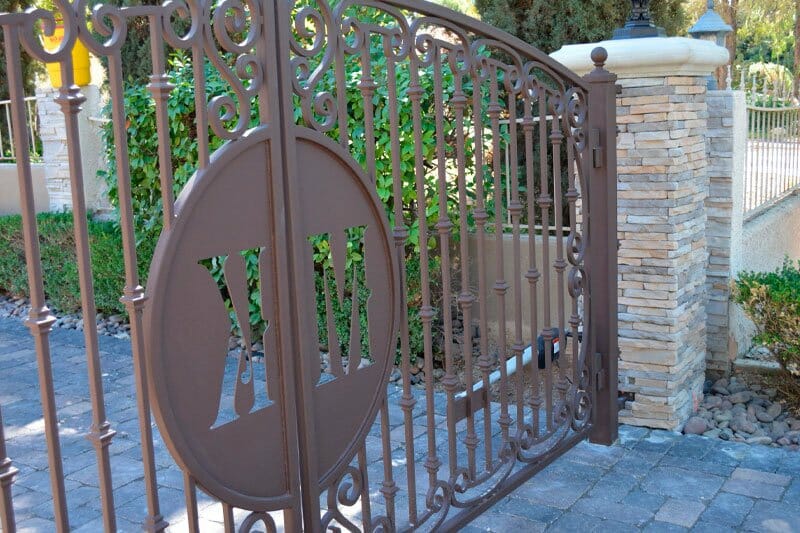
Wrought Iron Fencing
If you are looking for a front yard fencing option that screams elegance and sophistication, then rest assured, wrought iron is the one. Wrought iron fencing is a classic option that offers you privacy, high-level security and boosts your curb appeal.
However, all this glitz and glam come at a price. It will cost you anywhere between $25 and $35 per linear foot for labor and material costs.
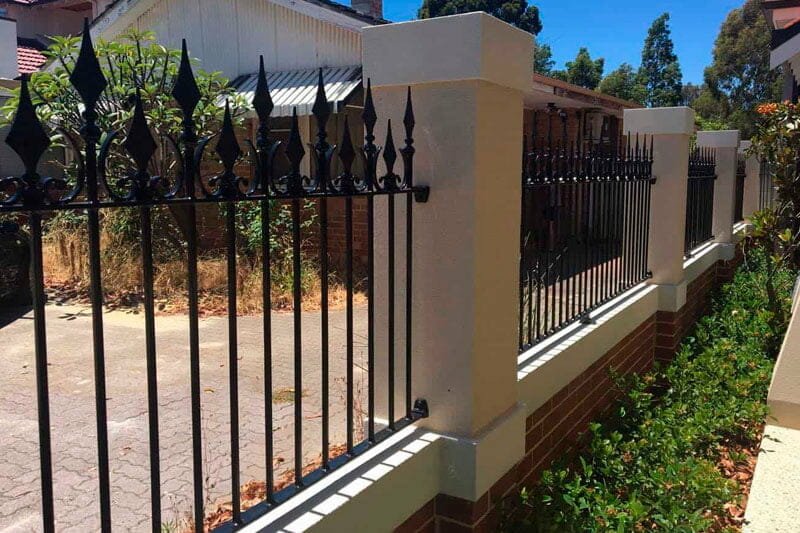
Picket Fencing
Picket fences are a popular front yard fencing option because they comply with most homeowner fencing regulation codes, are highly decorative, and add to the aesthetic appeal. You can enhance the privacy of your lawn by enclosing your picket fence or making it higher than usual.
The average cost of installing a picket fence per linear foot ranges between $23.50 and $38.00. Depending on the picket material you prefer, terrain fence height, project size, and preparations costs, this price can go up or down.
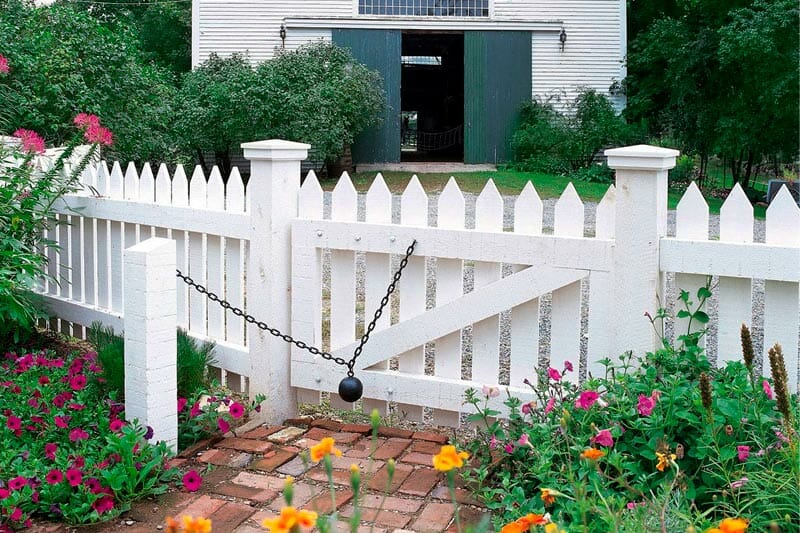
Privacy Hedge
Fast-growing privacy hedges effectively add privacy, texture, and interest to your landscape. When maintained properly, hedges cost less than most other front yard fencing alternatives and have a higher environmental significance.
The cost of planting a hedge is determined by the price of seedlings in your locality and the landscaping fees—typical labor costs for planting a 209-foot hedge range between $45 and $65. Hedges will need to be trimmed regularly and usually cost $35 per hour.
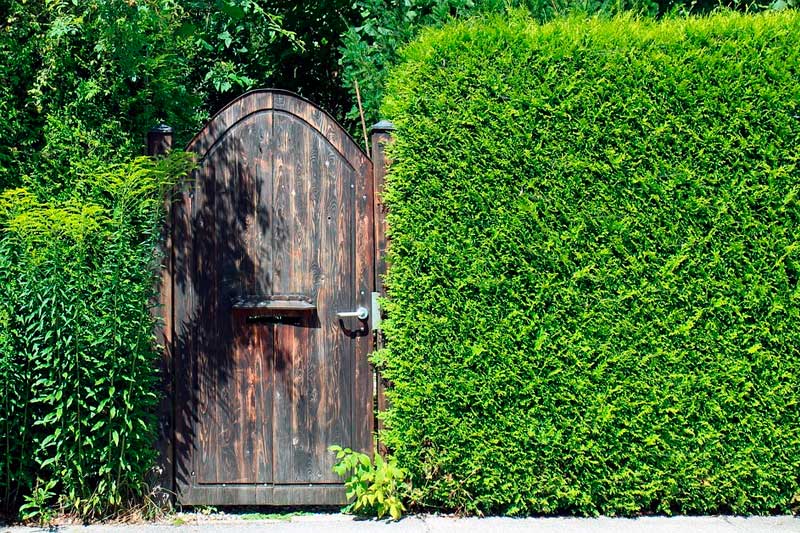
Wire Fences
Wire fences are a great way of marking property boundaries. They serve as an ideal way of ensuring privacy in your property without blocking out the natural surroundings.
Different factors determine the cost of wire fences, including the installation cost, the purpose of the fence, and the thickness of the fences. The national average cost of installing a wire fence is $2,400. The installation cost per foot is between $1- $8.
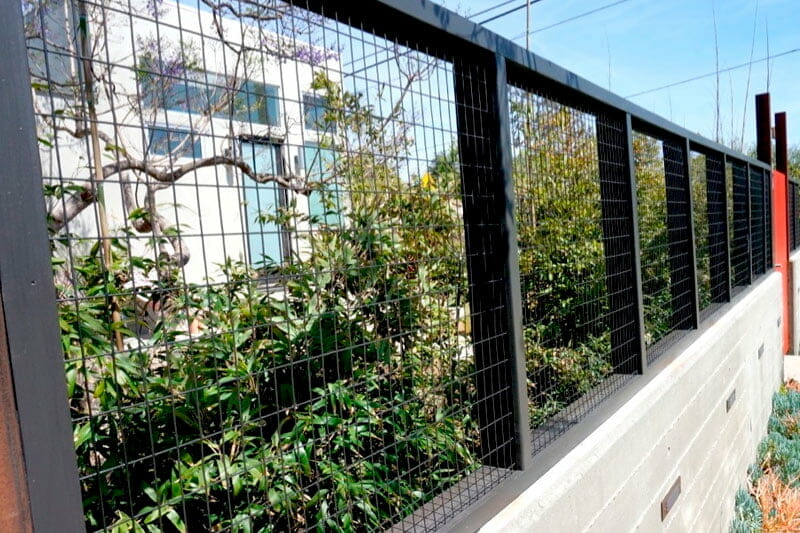
Wooden Privacy Fence
Wooden privacy fences are the most ideal if your home is on a busy street, too close to a sidewalk, or if you want to achieve maximum privacy. In addition, wood fencing provides you with desired aesthetics and great flexibility when it comes to design and color options.
The average cost of installing a wood privacy fence is between $3,600 and $10,000. However, with regular maintenance and care, your wood privacy fence can stand strong for up to 20 years, providing you with value for your money.
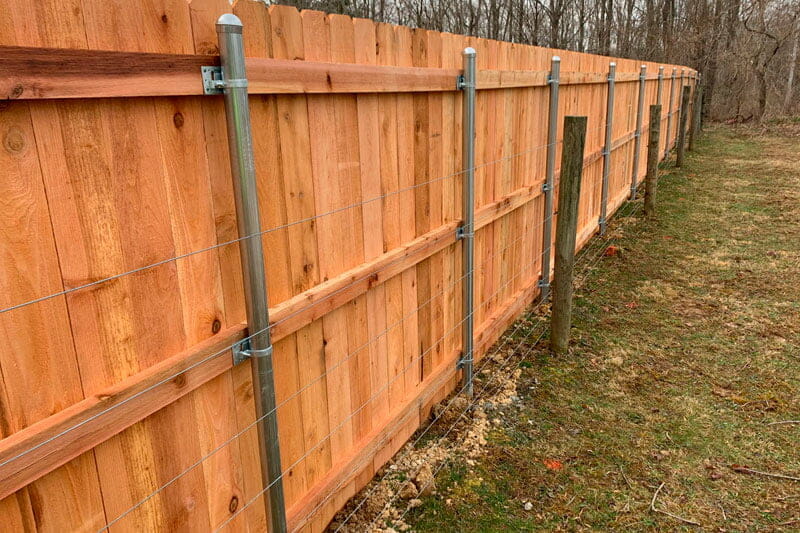
Which Is the Best Option?
All the above options are great for your front yard. However, the best option for you is one that appeals to your tastes and preferences, fits your budget, and compliments the theme and style of your home. Don’t forget to consider the durability and strength as well as the levels of security and privacy offered by each fencing option.
Fences offer a variety of advantages for your property, including increased safety and security, keeping children and pets contained within the yard, improving curb appeal, and more. When choosing a fencing material, homeowners often have concerns about its durability and lifespan.
Wooden fences last from 5 to 30 years depending on the type of wood, Aluminum fences lifespan is impressive, with proper maintenance easily 50+ years. The life expectancy of vinyl or PVC fences is 20 to 30 years.
In this article, we will talk about the fence’s lifespan primarily, but we will cover some other factors on this subject too. Let’s go!
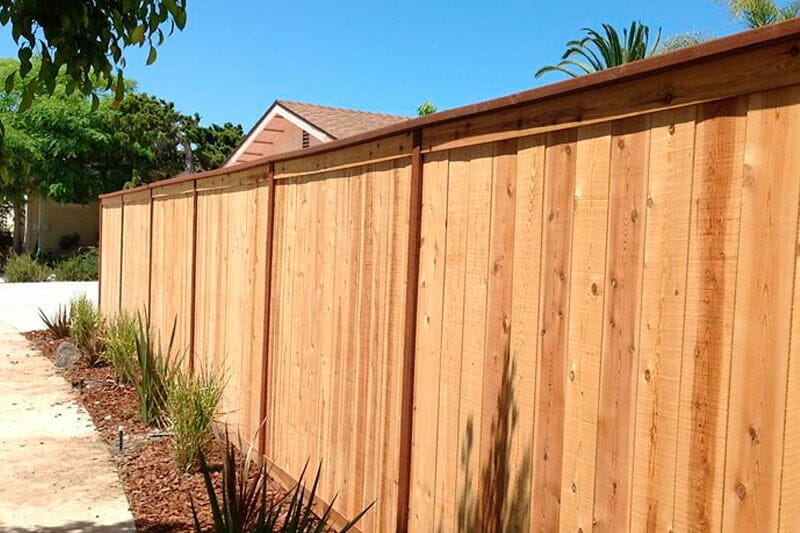
How Long Does a Fence Last?
Before you spend your money on a new fence is normal that you want to know how long your fence will last. There are a whole host of factors that determine the lifespan of the fence. First the material, elements that fence will be exposed to, way of maintaining, place where is installed, the weather condition in your area, etc.
How Long Does a Wood Fence Last?
A wood fence split rail, and picket fence can contribute to the curb appeal of your property and can increase the value of your home. The average life expectancy of the wood fence is 15 – 30 years, but with the proper maintenance and protection, it can last up to years or more.
- Pine – 20 years
- Cedar – 25 years
- Redwood – 25 years
- Engineered wood – 30 years
Wood Fencing Consideration
Wood fences are famous and widely used due to their ability to withstand decay and rot. Part of the fence post which has constant contact with the ground and is exposed to moisture and insects should be pressure treated with chemicals that keep away water and bugs so the wood will not get damaged.
New Installation
When you have a new fence installed, wait at least a year before painting and staining it so the chemicals used on the wood can dry out. Otherway you will seal the moisture inside and very fast you will end up with damaged fence. Pressure-treating ensures that the wood is protected from fungal decay and termites. Anyway, if you overlook the regular maintenance of the fence your wood will suffer from swelling, shrinking, cracking, and wrapping.
Conduct an Annual Inspection
Conducting an annual inspection ensures the longevity of your fence. Simply walk around and locate damaged or rotten boards. If needed replace any broken boards, hammer in nails, or tighten screws. Also, check if the wood sections are properly attached to each other and if any part of the fence is leaning, make sure the posts are tightly in the ground.
Ensure dry environment
Pressure-treated wood isn’t 100% waterproof so whatever steps you take to avoid moisture will increase the lifespan of your fence. Also, you can adjust your sprinklers so they don’t get your fence wet and cause the wood to rot ar lead to moss growing on your wood. Trim back your bushes and shrubs so they don’t hang on the fence because they’re adding weight and hold on moisture.
Thorough Cleaning Every 2 to 3 Years
Every two to three years clean your wood fence to avoid dirt, moss, mildew, and graying, and after that apply UV inhibiting, water-repellant coating. Scrape off any moss or peeling paint until you’re able to see the wood again. If mold is already an issue prepare a cleaning solution of 20% bleach with 80% mild detergent and spray it on the fence an hour before washing to kill any mold spores and stop them from growing back.
Reseal or Repaint After Cleaning
Painting and sealing should be conducted at the same time as cleaning, more precisely after. For wooden fences use exterior oil-based stain or latex paint which will seal out the moisture, prevent the wood from rotting, and limit the amount of weathering of your wood. Use products with a UV inhibitor to help keep the wood from turning gray.
How Long Does Aluminum Fence Last?
There are a lot of things to love with an aluminum fence. First the sleek look, the luxury of zero maintenance, and last but not least the extraordinary durability and lifespan. Aluminum is an absolute champion among fence materials with a lifespan of 50+ years, but it depends on the quality of aluminum and the coating process.
Its impressive lifespan is due to the impermeable aluminum base. Aluminum unlike wood is not susceptible to rot and mildew and stands very well against dirt and grime. The combination of almost zero maintenance and longevity makes aluminum a great choice for your fence.
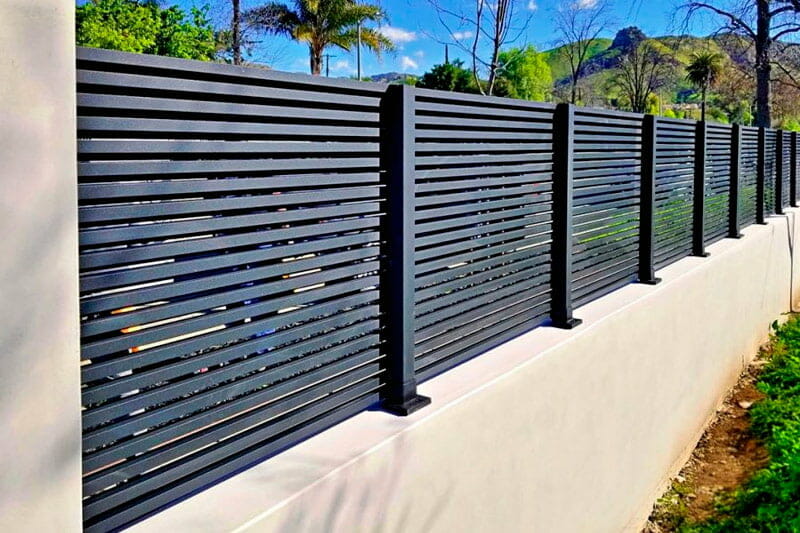
Aluminum Fence Maintenance
Although we mentioned above that aluminum fences require almost zero maintenance, there are still some things you will have to do, not for increasing a fence lifespan but to keep the good looking of the aluminum.
Hose Down
Every few weeks, or when necessary, hose down your fence to get rid of any dirt, fertilizer chemicals, and other waste. None of this can hurt your fence but they will ruin the picture of a perfect aluminum fence, and for sure you don’t want that.
If hosing it down doesn’t help, after some muddy storm for example, and the bottom of the fence is caked with splatters of mud, wipe it down with some soft cloth, but never use something like a wire brush to remove dirt from the aluminum fence. Wash up first to dilute the dirt and then wash down to remove it away from the fence post. Let the fresh air do the magic and then wipe it down with a soft cloth.
Use chemicals and soap
For harder stains use CLR ( Calcium Lime and Rust Remover) which is not a dangerous chemical but still beware when you working near plants or vegetable gardens. In that case, apply the CLR with a rag. For areas that are more soiled and that aren’t coming clean with water or degreaser, use warm water with dish soap.
Important to note that if you live near the coast where saltwater corrosion is a problem you will have to use your hose more often to be sure that the salt will not cause problems.
How Long Does Vinyl/PVC Fence Last?
20 – 30 years is the life expectancy of a vinyl/PVC fence, of course, it can range depending on the quality and brand of vinyl fence. Check the manufacturer’s warranty to know how long a specific vinyl/PVC fence will last. Warranties range from 20 years to a lifetime, and if your fence is installed correctly and properly maintained, should last as long as the warranty.
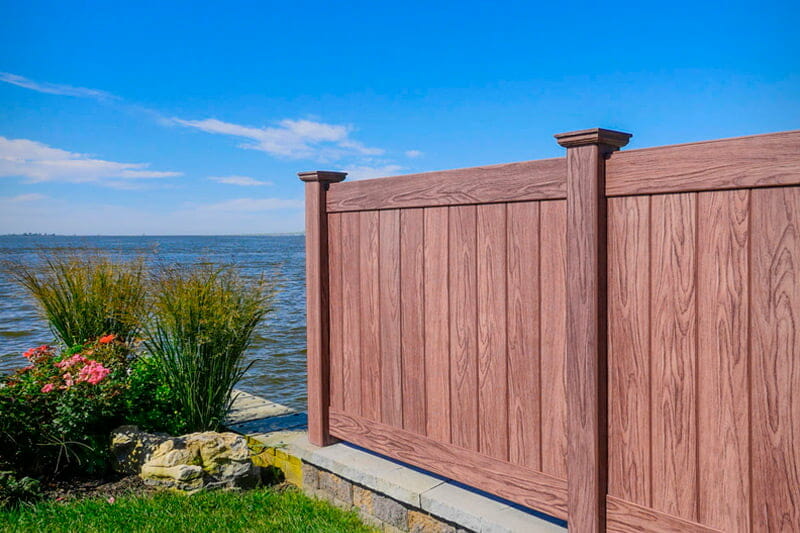
What Makes Vinyl/PVC Fence Last so Long?
Polyvinyl chloride is responsible for the longevity of the vinyl/PVC fences. Vinyl is durable and strong, it has five times the tensile strength and four times the flexibility of wood. Vinyl fence material is typically blended with other ingredients to become a low-maintenance product that will last for years.
Is Vinyl/PVC Fence Prone to Cracking and Brittling?
Quality vinyl/PVC fence products won’t crack or become brittle due to sun exposure or cold temperatures. Good vinyl is UV-resistant and can accommodate normal temperature changes.
To be sure that your vinyl/PVC fence will stand well against sun exposure and weather conditions, made some researches about the brand you are going to purchase because some seemingly cheap options can cost you a lot in the future due to the reparation or even replacing your fence.
Use This FREE Service
HomeGardenGuides.com is a free service that quickly matches you with top-voted local Fence Specialists.
You can get 3 estimates fast by real certified experts in your area in just 2 minutes.
- Scroll to the top of the page and enter your Zip code.
- Answer questions about your fencing job
- Your dancing job details are forwarded to three local experts. They will send you a price estimate for the job and some friendly advice.
IMPORTANT: There is no obligation to hire. This is a free tool and service to be used at your pleasure.
Location Factor
Location or where you will install your fence has a big influence on the fence lifespan. This applies to all types of fences. Swampy or uneven ground or heavily forested areas with a lot of weak trees can take a few years of your fence lifetime. However it is possible to build on a slope, so-called “racking” a fence, if you don’t have other options.
Substantially solid, devoid of weak threes, and leveled as much as possible installation area acts favorably on your fence.
Connection Between Installation and Lifespan
While installing your fence, don’t place posts too close together because you will get a too rigid structure that will not stand well against strong wind. You want a flexible fence.
Digging 6 inches deeper than recommended holes will provide enough room for gravel needed under the posts for extra strength. Avoid places with lots of rocks and debris.
How long your fence will last depends on many factors, including the type of fence, location choice, installation quality, and maintenance. Take time before deciding on the fence you will spend your money on. Good luck!
FAQ's
Yes, it is, fire-resistant and self-extinguishing material. While wooden fences are fire hazards, vinyl/PVC fences are difficult to ignite because of their high chlorine content.
Titanium oxide is a compound with phenomenal stability and very low toxicity that protects the vinyl from sun damage, degradation, and yellowing over time. Because of this, vinyl is one of the most durable fencing materials.
While there are many different alloys of aluminum, they contain almost no iron, and without iron rust (iron oxide) can’t form.
Yes. Staining a fence protects it again water damage, rot, insects, and day-to-day wear and tear.
Redwood, cedar, or pressure-treated pine last the longest.

- Build your fence with metal fence posts
- Add a rot board to the bottom of your fence
- Stain and seal your fence
- Inspect and repair if needed at least once a year
- Minimize contact with water, soil, and vegetation
- Clean the fence thoroughly every 2 to 3 years
There is a range of farm fences in different types and designs, each with a corresponding cost.
Farm fencing costs between $2 and $20 per linear foot installed. Post and wire are the cheapest, while Post and rail are much more expensive. The average cost is $1,675 per 100 ft, while labor costs $2 and $6 per linear foot.
The installation cost of farm fencing depends on the total linear footage to be covered and the type and quality of the fence you choose. Vinyl, wooden and pipe fencing are quite costly to install but are more durable. High-tensile wire fencing is an excellent choice if you are looking for a more budget-friendly farm fencing option.
The average cost of farm fencing
The table below provides you with a summary of the different farm fencing types and their costs. Before you install a particular fence, consult with your professional first to know the number of lines and strands you will need for your animals’ safety and the structure’s durability. The number of lines and strands needed will depend on your livestock type.
| Material type | Price | Lifespan |
|---|---|---|
| Metal pipe | $7 - $10 per foot | 20 – 30 years |
| High-tensile Non-electric wire | $0.02 - $0.03 per ft (per strand) | 25 – 50 years |
| High-tensile electric wire | $0.03-$0.12 per strand | 25 – 30 years |
| High-tensile barbed wire | $0.03-$0.05 per strand | 20 – 30 years |
| Electric High-tensile polymer | $0.10-$0.15 per line | 25 – 30 years |
| Non-electric High-tensile polymer | $0.11-$0.13 per line | 20 – 50 years |
| High-tensile polymer rail | $0.80 - $0.90 per foot | 30 – 50 years |
| Vinyl | $8 - $20 per foot | 10 – 15 years |
| Hog, Bull, & Cattle panel | $1.25 - $2.55 per foot | 7 – 10 years |
| Wood post & board | $3 - $9 per foot | 15 – 20 years |
| Woven wire | $0.10-$0.14 per braid | 25 – 30 years |
| Tape | $0.04 - $0.30 per strand | 5 – 10 years |
| No climb | $1.40 - $1.90 per foot | 15 – 20 years |
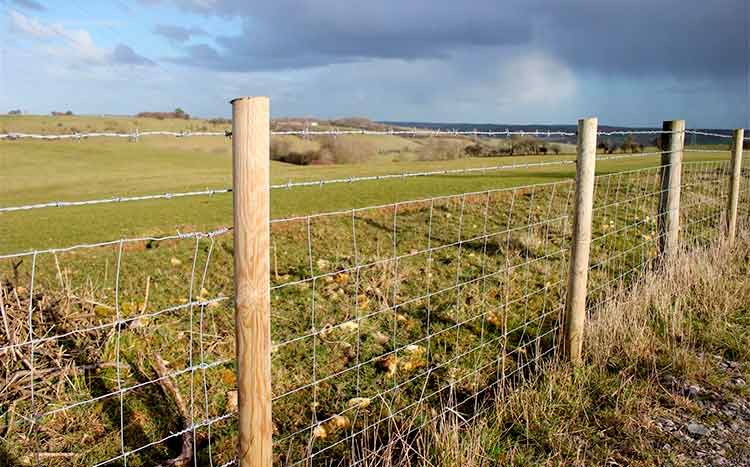
Metal pipe fence cost
Metal pipe fencing costs between $7 and $10 per linear foot to install. This fencing type is quite expensive to install, but its durability makes it an excellent choice for livestock owners looking for a safe, strong, and durable fencing option. Metal pipe fences can, however, hurt animals that run or get pushed into it.
Pipe fences are corrosion-resistant, making them excellent for areas experiencing harsh weather.
High-tensile wire
High-tensile wire fences are excellent farm fencing options that last for many years. They are cheap to install, and their low maintenance costs make them a popular choice for most ranch owners. High-tensile wire fences come in electric and non-electric options.
Electric
A high-tensile electrified wire fence will set you back by around $0.03 to $0.12 per linear foot. It is essential to use markers or raise the bottom/lowest wire several inches from the ground to protect your animals from potential harm.
Non-electric
The high-tensile non-electric wire fence costs around $0.02 to $0.03 per linear foot to install. This cost is for one strand, so the overall cost will depend on the number of strands you want. Experts recommend six strands for optimal protection so that you will pay between $0.12 and $0.18 for this fence, not including labor costs.
However, high-tensile wire fences have low visibility, which may put your livestock at a higher risk of being injured or entangled in the wires.
High tensile barbed wire
Installing a high-tensile barbed wire fence costs between $0.03 and $0.05 for a single strand per linear foot. This fence type is inexpensive to install and will keep your animals safe and contained in your ranch. It has a rustic appearance that makes it very appealing to most homeowners.
Once you install this fence, you should watch your livestock. This is because a barbed wire fence contains sharp barbs that can tear and rip off your animals’ skin and injure them severely. This fence also requires regular tightening to keep it effective.
High tensile polymer
The high-tensile polymer fence also comes in electric and non-electric options.
Electric
Expect to pay between $0.10 and $0.15 per linear foot for one line of high-tensile polymer electrified fence. The HTTP electric fence is costlier because it takes a long time to install. More so, this fence type uses electricity, so your monthly power bills will be higher.
Non-electric
The high-tensile non-electric fence costs around $0.11 to $0.13 per linear foot for a single line. It is slightly cheaper than the electrified option and is ideal if you do not want additional power bills.
Both HTTP electric and non-electric fences are excellent choices for your livestock. This fence is safer for livestock fencing as the additional polymer prevents the fence lines from cutting and ripping off your animal’s skin. More so, the polymer is resistant to weather, impact and stretching, making it highly durable. The polymer comes in various colours to increase visibility.
High tensile polymer rail fence cost
The average cost per foot for a high-tensile polymer rail fence is between $0.80 and $0.90 per foot. This fence features three HTP steel wires that are evenly spaced. The wires can be either electrified or non-electrified. This fence is highly durable, and it does not break, split like wood fences. It is similar in appearance to the split-rail fence and can last for over 30 years.
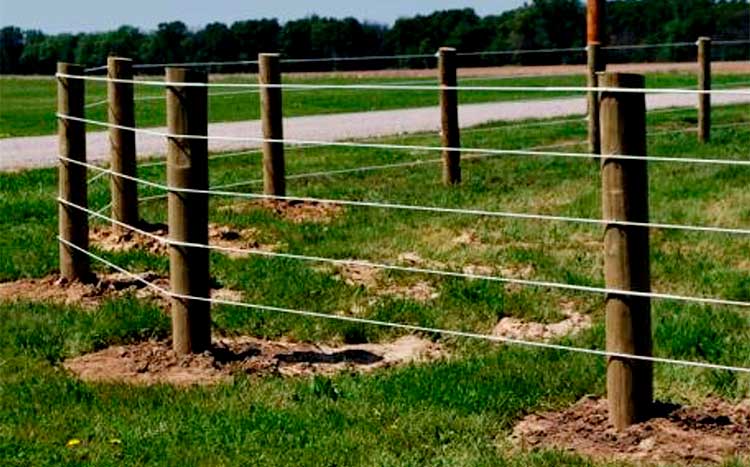
Vinyl horse fence cost
The vinyl horse fence is another high-end farm fencing option that costs between $0.90 and $1.60 for a single rail, per linear foot. The rails come in various colours, so you can choose the colour that matches your property. This fence is one of the most expensive to install, but it can last for about 10 -15 years. It is a low maintenance fence that works perfectly in moderate climates, but a colder climate can make the PVC material brittle.
PVC fencing does not splinter like wood upon impact, making it safer and more durable. You can add one strand of electric wire on the fence to keep your livestock from leaning or popping the fence posts and rails.
Hog, Bull & cattle panel cost
Expect to pay between $1.25 and $2.55 per linear foot for hog wire fencing as well as bull and cattle panel fencing. If you wish to buy a wire panel measuring 16 feet long, you will spend about $25 to $50.
Different animals have different needs. So, the gaps at the panels’ bottom and spacing between the wires will depend on the kind of livestock you want to enclose.
Wood post & rail fencing cost
A wood post and board fence is also called a paddock, split rail or Kentucky fence. Building this fence will cost between $4 and $12 per linear foot, including the required posts and 2-4 nails.
If you wish to add a wire mesh to the fence, you will spend an additional $2.00 per linear foot. You will also need to add protective stain or paint at an extra cost.
Wood post and board fences are quite expensive to install and maintain. It is essential to maintain the fence and replace boards regularly because the wood may cause harm to your animals when it splinters.
Woven wire electrical fence cost
Installing a braided or woven wire electric fence costs around $0.10 to $0.14 for one braid, per linear foot. The actual cost of the fence will vary widely depending on the size of your farm.
Electrobraid is one of the most popular brands for woven wire electric fences. Installing this fence costs approximately $1.55 per linear foot. This fence is durable and can last for over 25 years without showing any signs of failure.
This fence offers more visibility than other types of wire fencing, and it comes in various colours and diameters.
Tape fencing cost
The average cost to install a tape fence ranges between $0.04 and $0.30 per linear foot. The cost may vary depending on the width and thickness of the tape. A tape fence is manufactured using conductive metal strands and poly fibres that are woven together. This fence is inexpensive and easy to install. It is also much wider and offers more visibility than traditional tape fencing, but it is not suitable for windy areas.
No climb fence cost
No-climb farm fencing, diamond weave or woven wire fence, costs between $1.40 and $1.90 per linear foot to install. This cost is for materials alone and can vary depending on the size of the structure. No-climb fencing is ideal for larger animals like horses because it has small openings. This fencing is suitable for even landscapes and requires regular tightening to maintain its functionality.
Livestock ranch fences (best choice)
The livestock fence you install will depend on the kind of livestock you have and your budget. Below are different types of livestock fencing and their costs.
Horse fencing
Both split rail and wire fencing are excellent options for horse fencing. The average cost to install a split rail fence costs between $12 and $30 per linear foot including labor cost. This kind of fence requires 3-4 rails and a height of 5ft to keep your horses safe and contained in your ranch. Although the split rail fence is expensive, it is the best option for safety and durability.
Wire fences are cheaper and cost around $3 to $8.50 per linear foot installed. If you are looking for a cost-effective choice, wire fences are an excellent choice. However, these fences have low visibility, which may cause injuries to animals.
Cattle fencing
If you wish to contain your cattle, HT (high-tensile) barbed wire is an excellent option. This fence is affordable as it costs between $0.03 and $8 per linear foot for a single strand and about $0.20 to $0.50 per linear foot for the recommended 5 strands. A standard HT barbed wire cattle fence will cost around $1.50 per linear foot to install.
Goats and sheep fencing
Adding a mesh screen to your wooden fence is the best way to contain your sheep and goats. This fence will keep your livestock within your farm and keep out unfriendly pests like coyotes and raccoons. This kind of fence costs around $1.80 per linear foot, not including labor costs.
Game
A woven wire fence is a perfect choice for game fencing. You can spend between $0.10 and $0.15 per linear foot for a single braid. A high structure of up to 8 feet tall can cost about $1.20 per linear foot for materials alone. This fence is meant to prevent animals such as deer from jumping and climbing over.
Field fence installation cost
The cost to install a field fence averages $2 to $6 per foot. On average, you can pay about $600 to $635 for the project, excluding materials. Most livestock owners spend around $500 to $800 for the entire project, but the price depends on the type and size of the fence. To correctly estimate the project cost, consider factors such as your labor charges in your region and additional structures like gates and accessibility.
Size by foot and acre
Generally, the labor cost to install farm fencing costs between $2 and $6 per foot. So, the labor cost for one acre measuring 208 feet will be around $416 to $1,248. The exact cost for the project will vary depending on the height of the fence, the number of rails and your local labor rates. The terrain and soil type of your land will also affect the total cost of the installation.
Livestock gates cost
The average cost to install livestock gates is about $200 to $400. Livestock gates have varying lengths, from 6ft. to 16ft. These gates are designed using tubular steel welded for strength and stability. They do not sag, splinter or warp like wood. The exact price to install livestock gates will depend on their size, style and height.
DIY vs hiring a pro cost
Farm fencing installation is relatively easy, so DIYers can install it without many complications. However, this is not a job for a weekend warrior, and it can be dangerous, especially when installing electric fences. While installing the fence yourself can save you lots of cash, it is best to leave the job to professional fencing contractors.
If you plan to DIY the job, you will buy materials for around $2 to $20 per linear foot. The overall material cost will depend on the size and height of the structure. You will also need supplies and tools for the installation at an extra cost.
Hiring a professional is the best option as they will come with their materials and tools. The average cost for professional installation ranges from $4 to $26 per linear foot. Professionals are more experienced and will offer timely, high-quality and durable installations.
FAQ's
What is the cheapest type of equine fencing?
The cheapest equine fencing is wire fencing that costs as low as $0.03 per foot to install. So, if you are looking for a practical, safe and cheap livestock fencing option, consider wire fencing.
Does a chain link fence work for livestock?
Yes, a chain-link fence works excellently for livestock. It is completely safe and cannot get tangled easily, making it a perfect choice for livestock. However, it is more suitable for smaller animals such as chickens, goats and sheep as it is not sturdy enough to contain larger animals like horses. Before you install this fence type, ensure it meets your needs.
How much does it cost to fence 1/2 acre?
The cost to install farm fencing on half an acre costs around $600 to $27,000, depending on the type of material you choose. A simple wire or electric fence will cost around $600 to $3,500 to install, including labour. A composite or vinyl fence is the most expensive and will cost between $15,000 and $27,000 to install on a ½ acre.
How much does a fence cost for 1/4 acre?
Installing farm fencing on a quarter an acre will set you back by about $400 to $20,000, including labour. The actual cost depends on the type of material you choose and your yard/ranch size.
